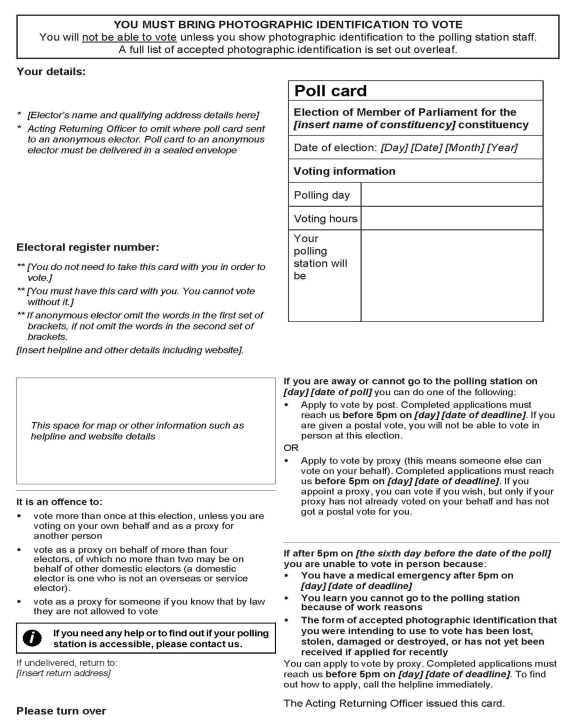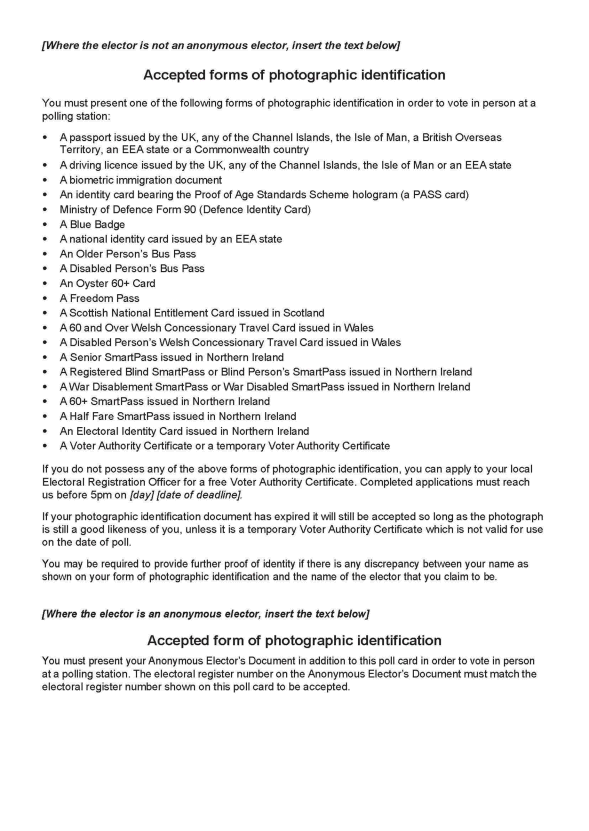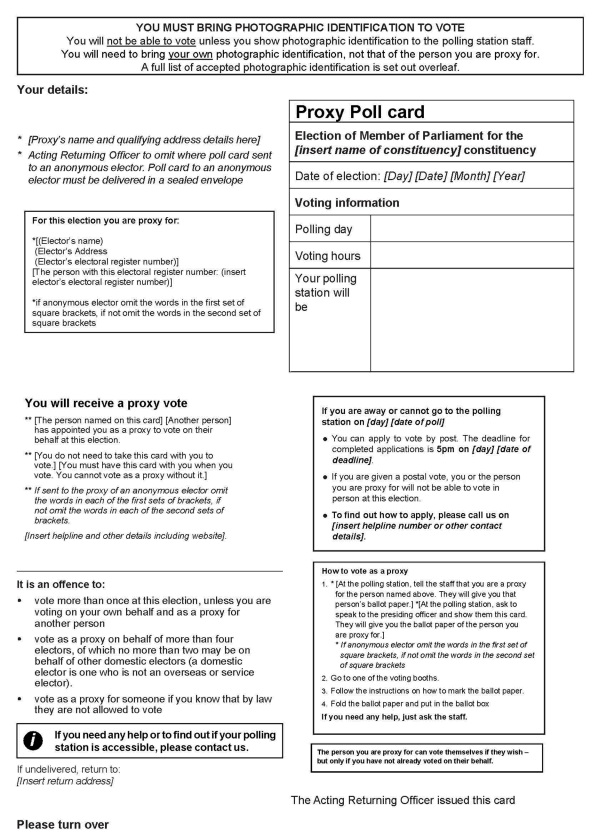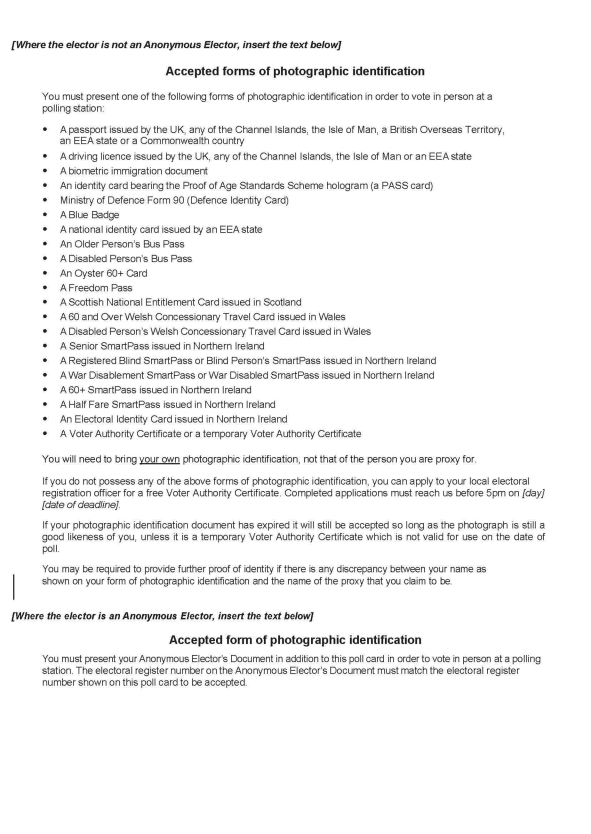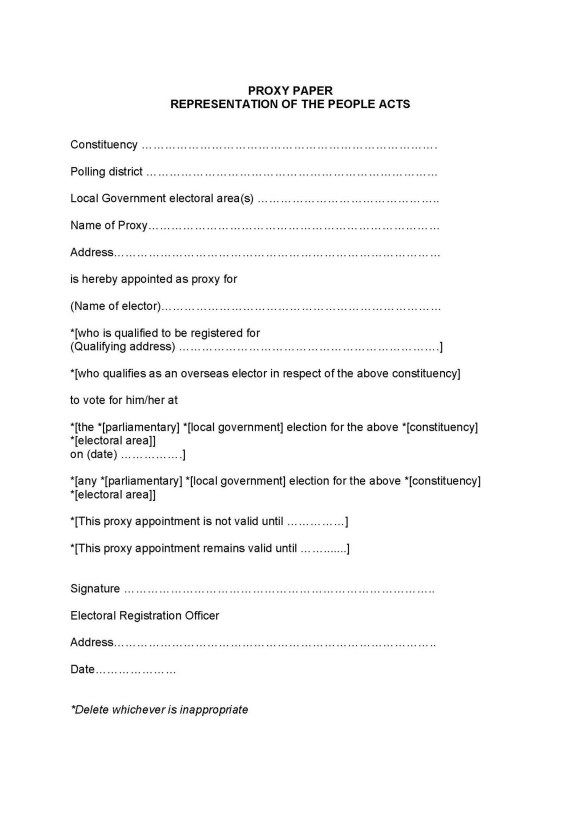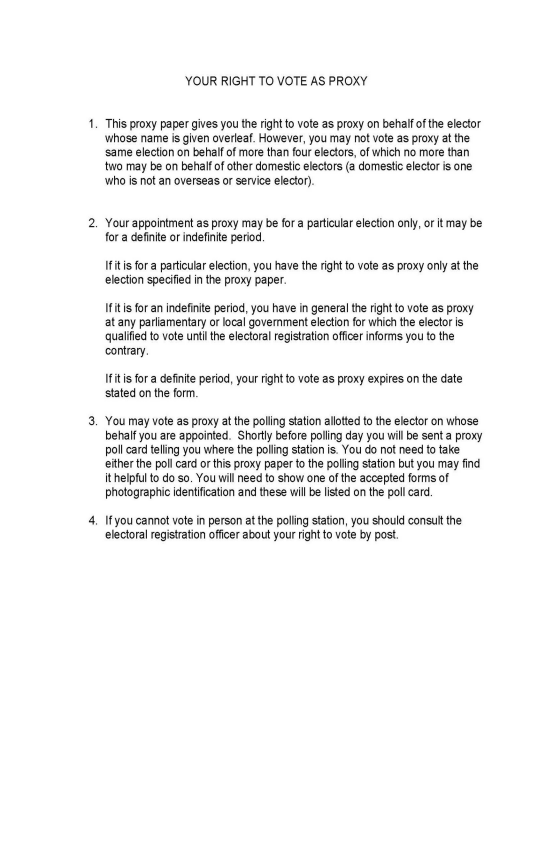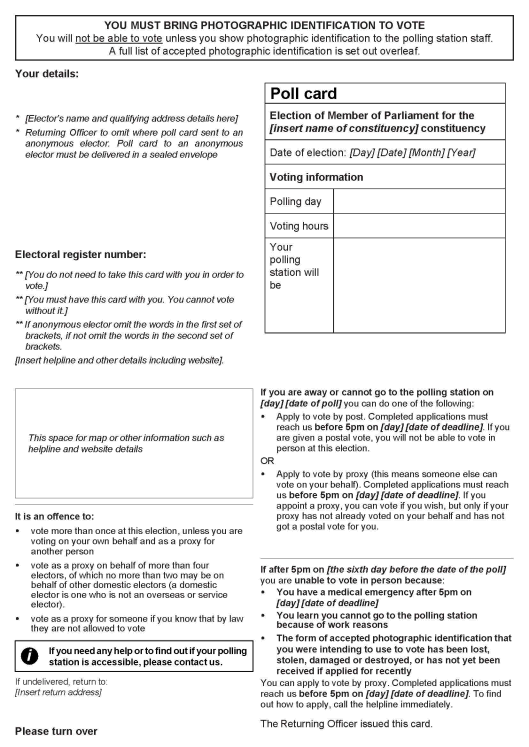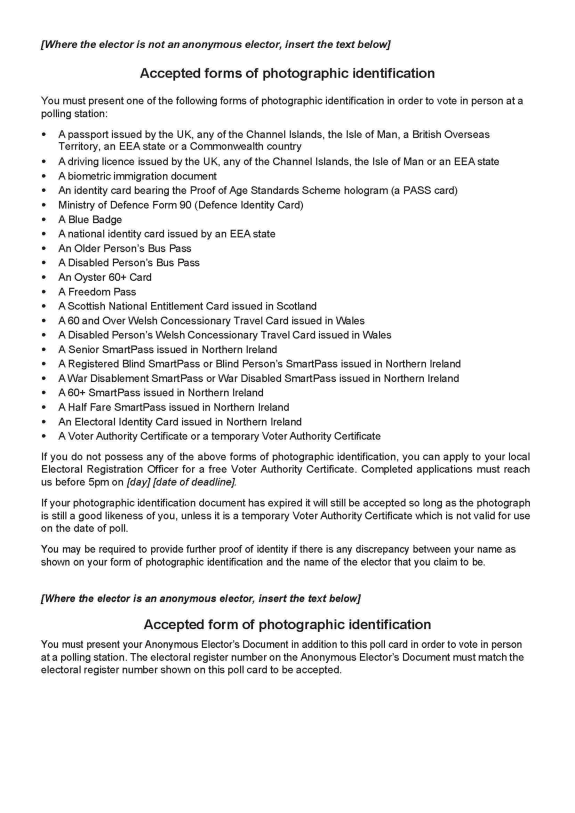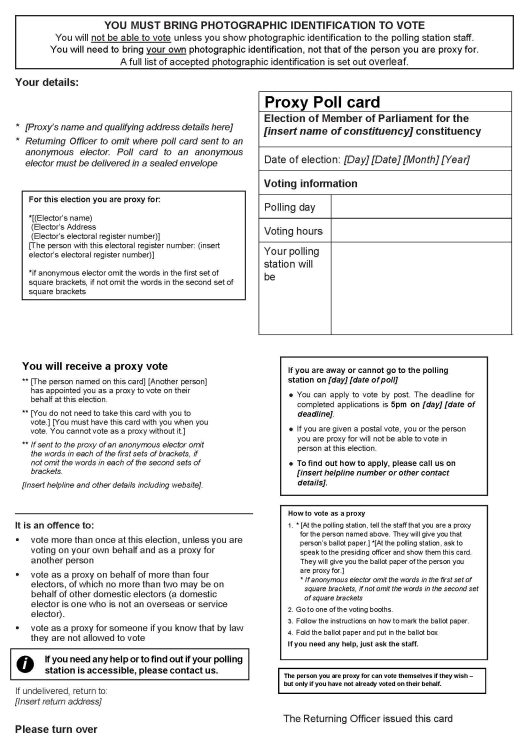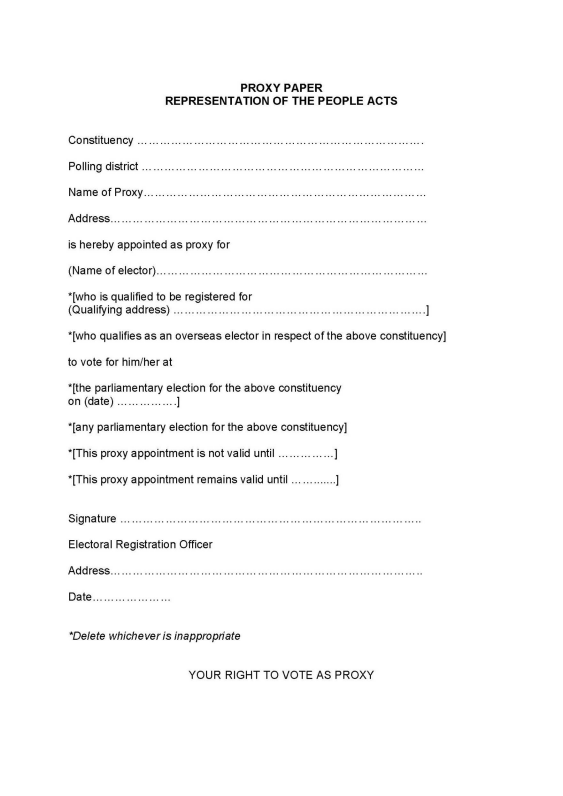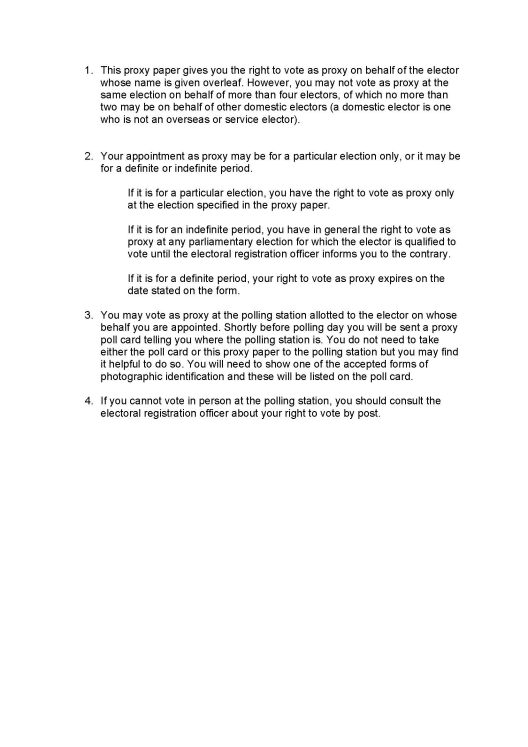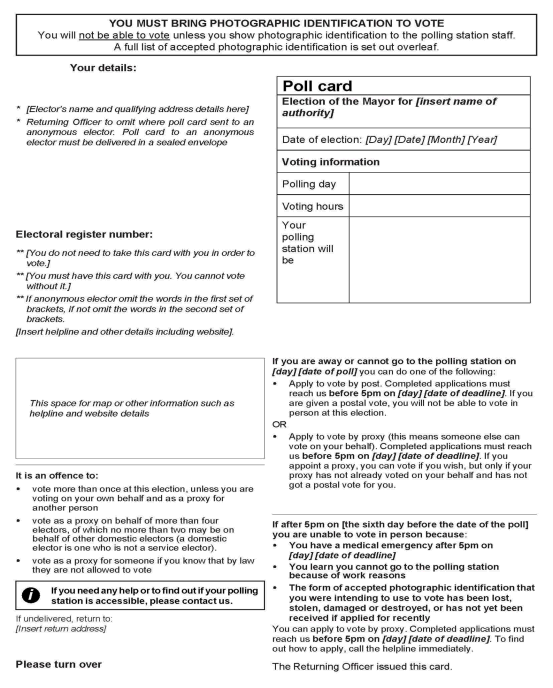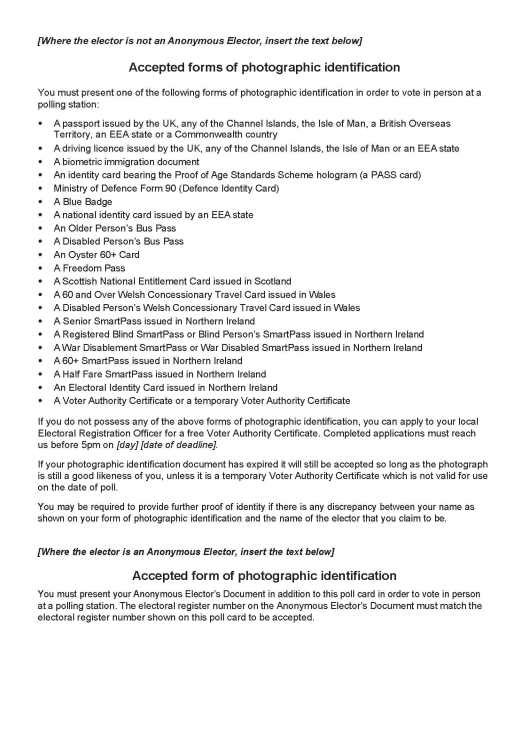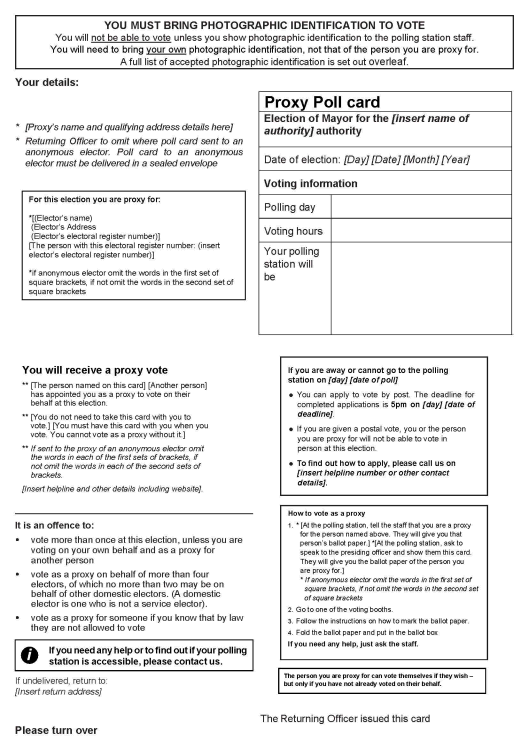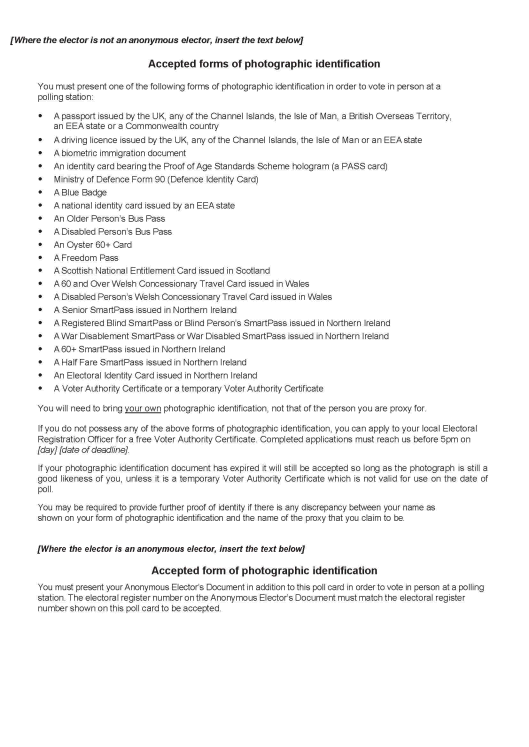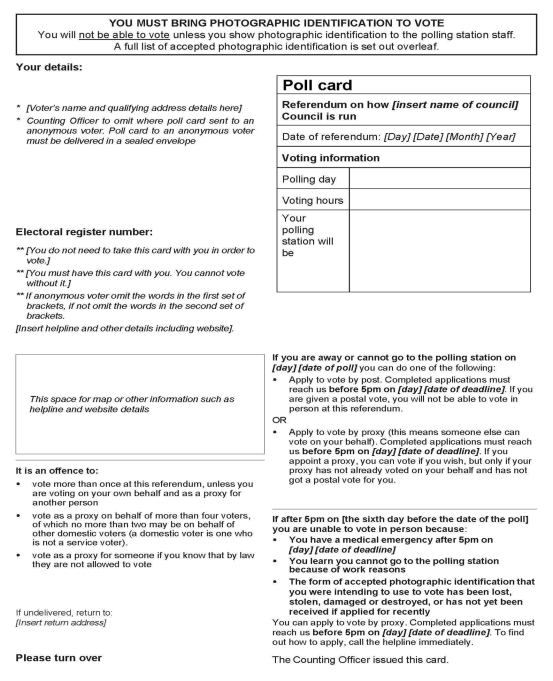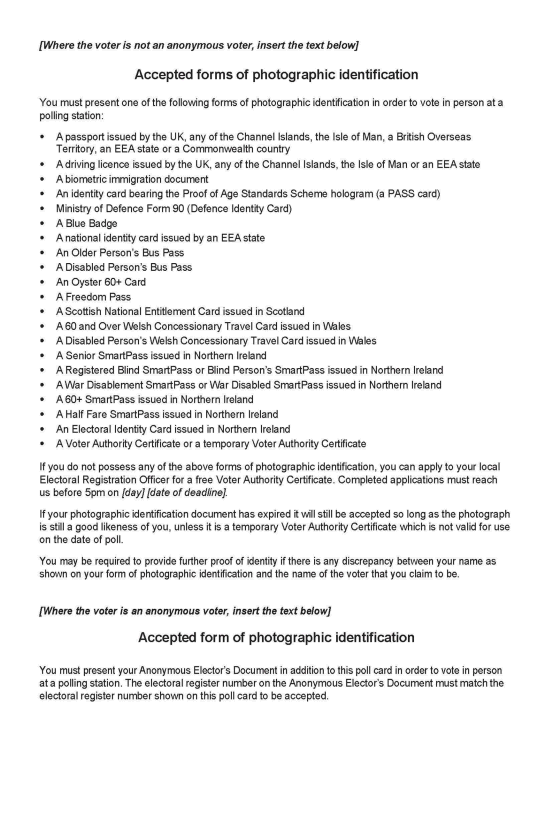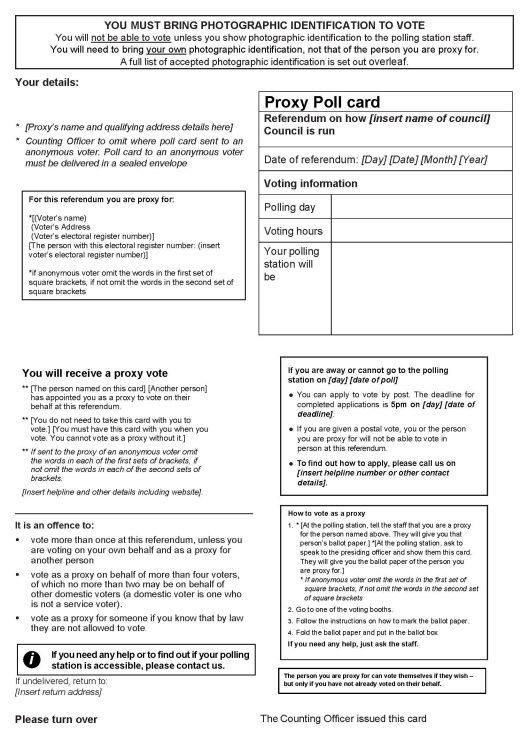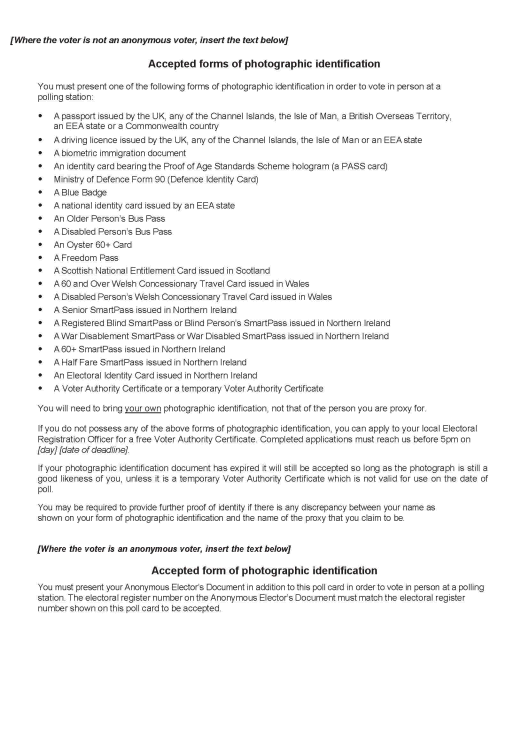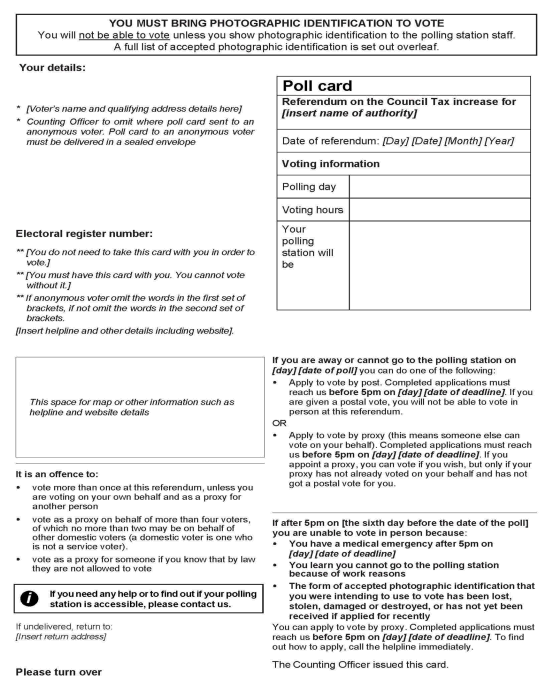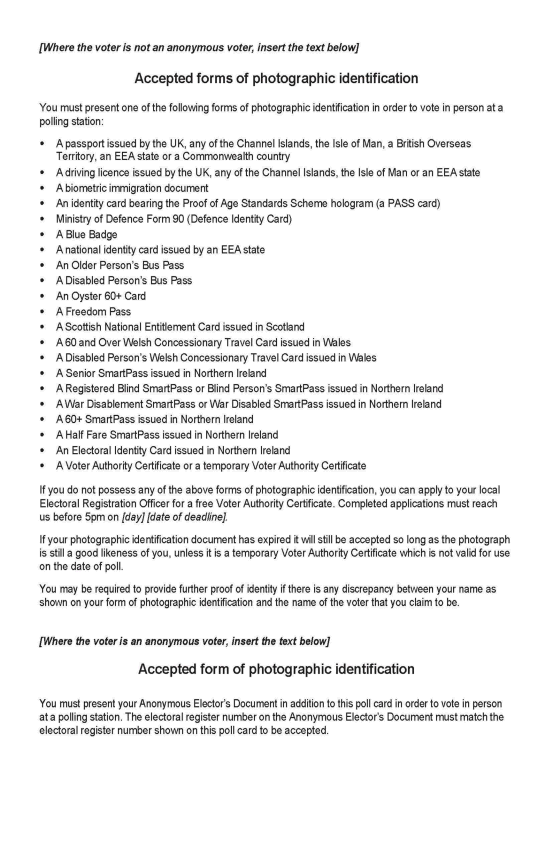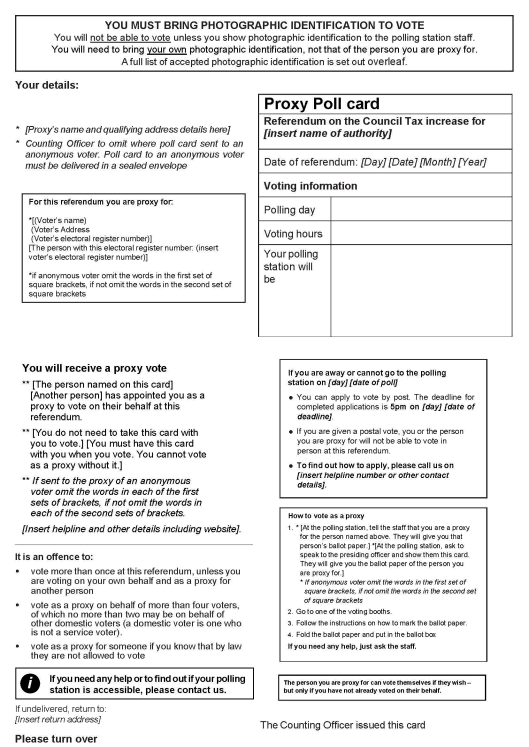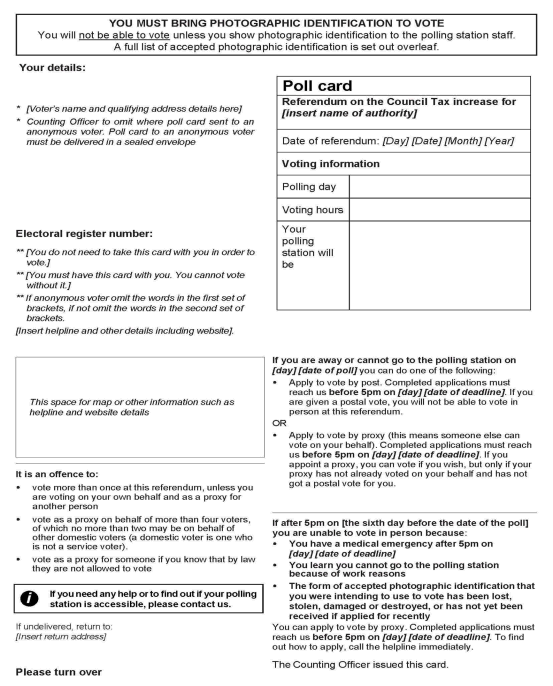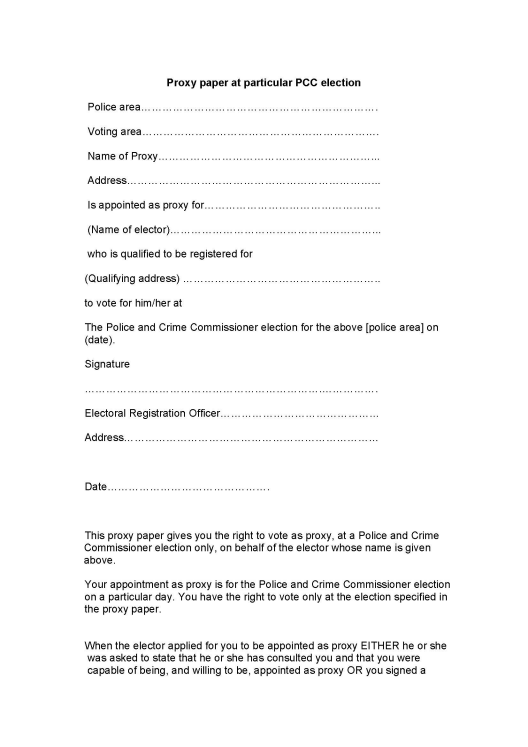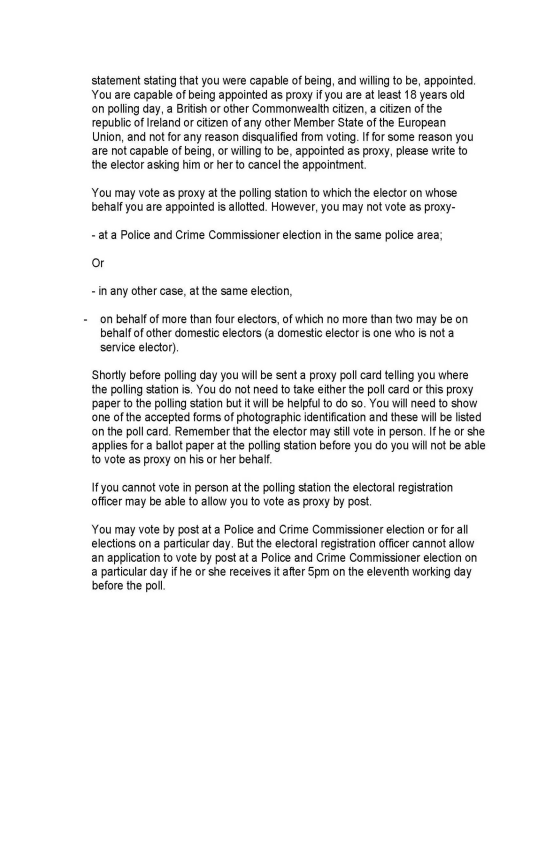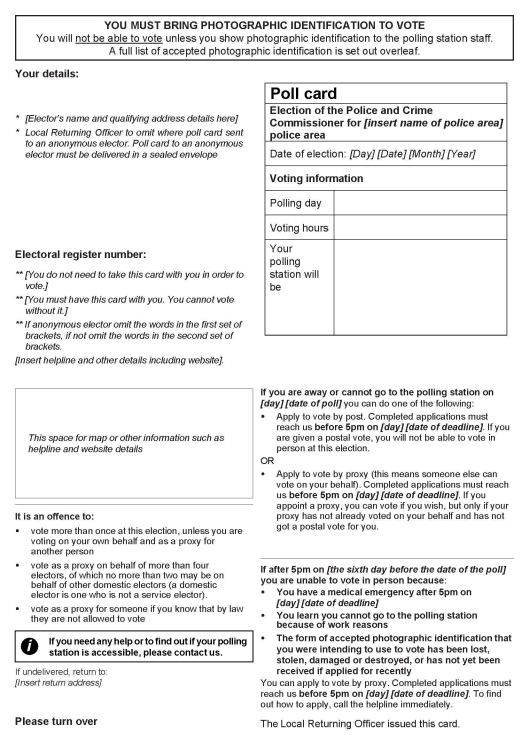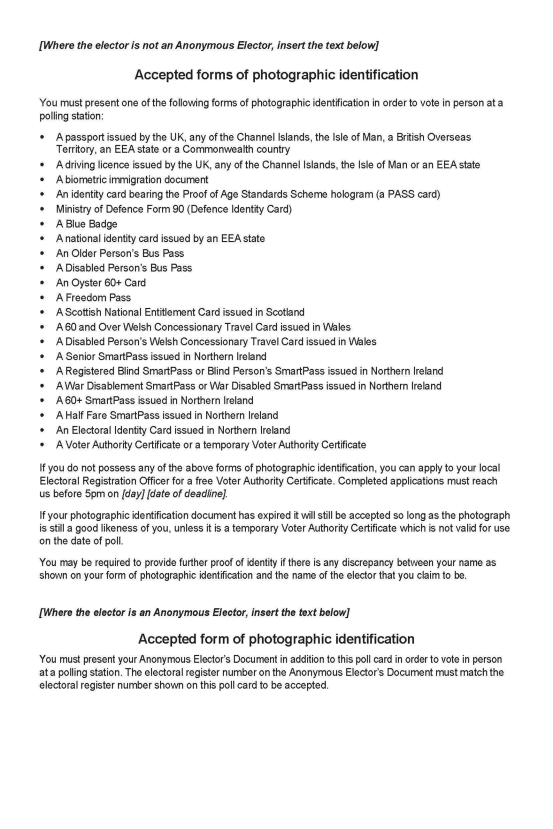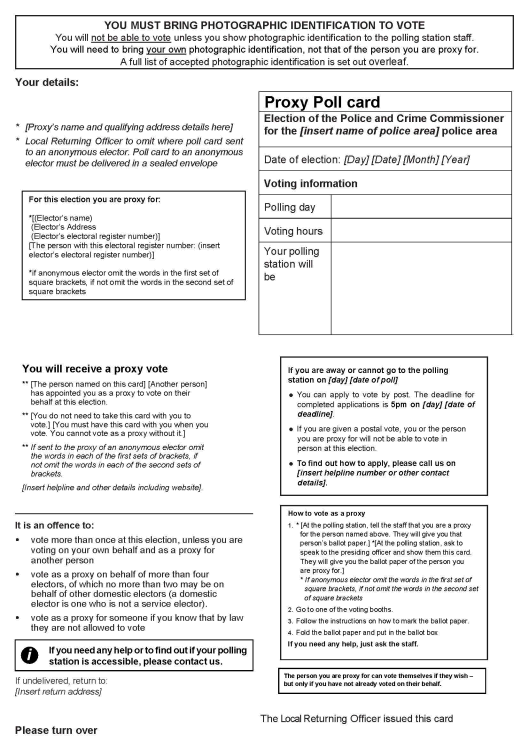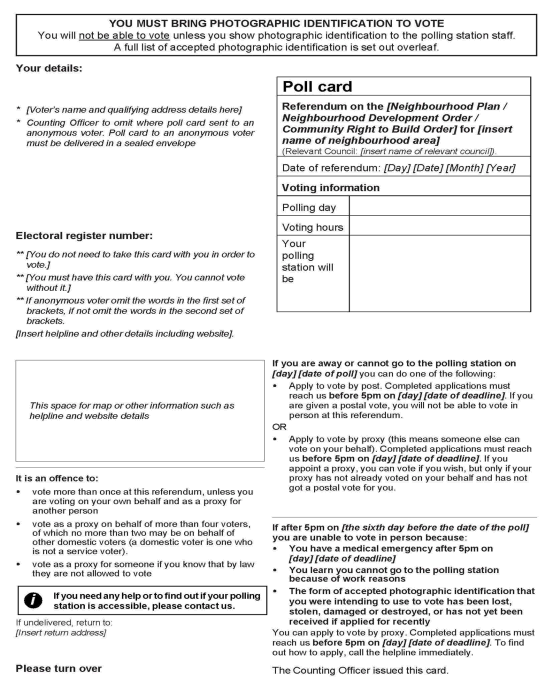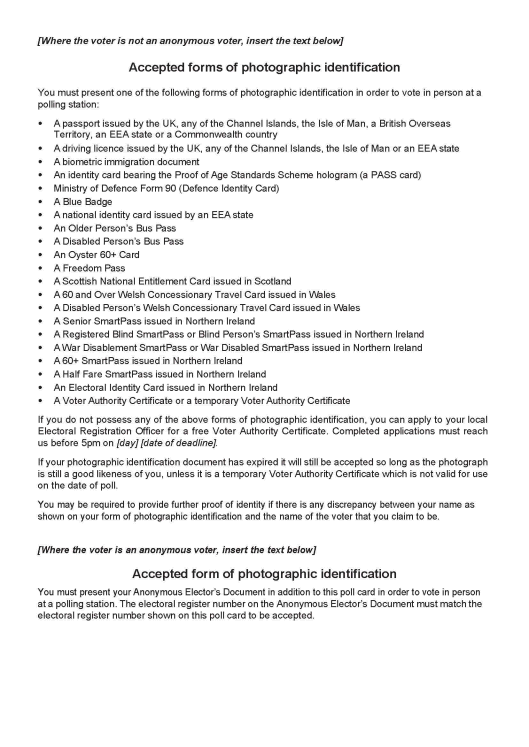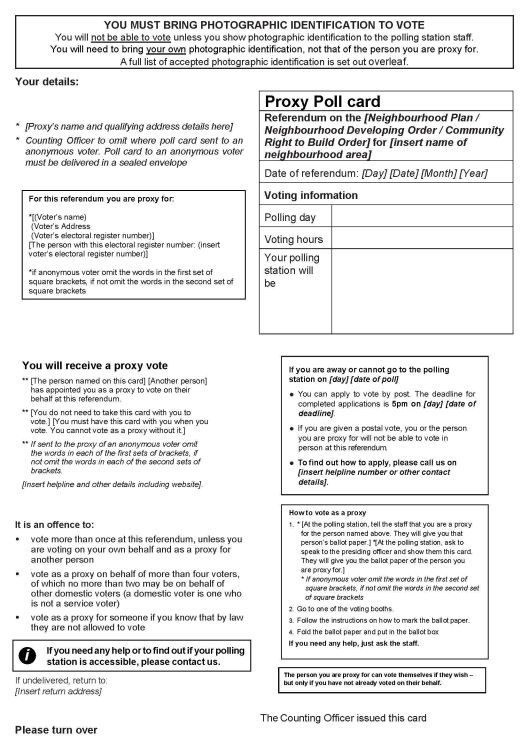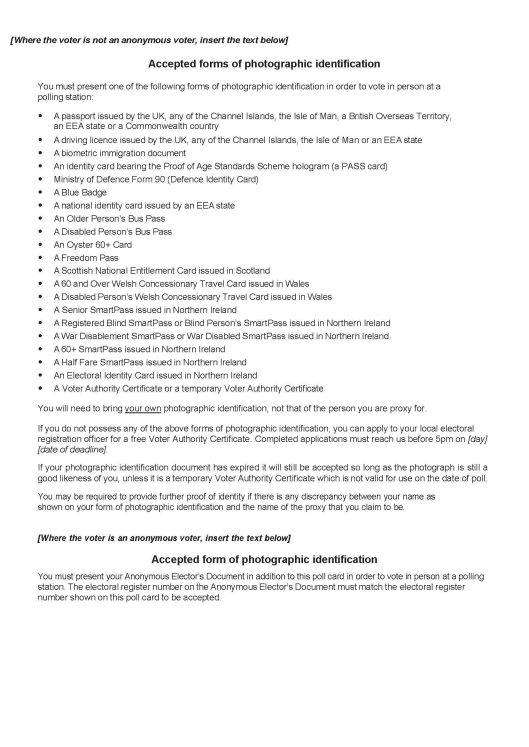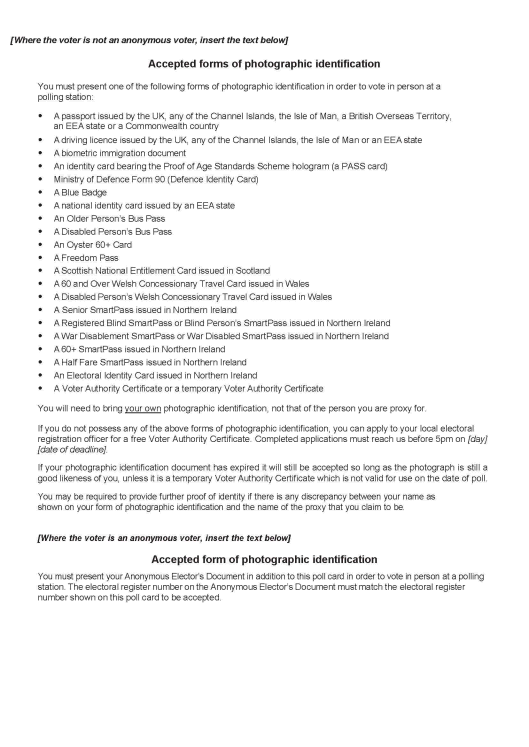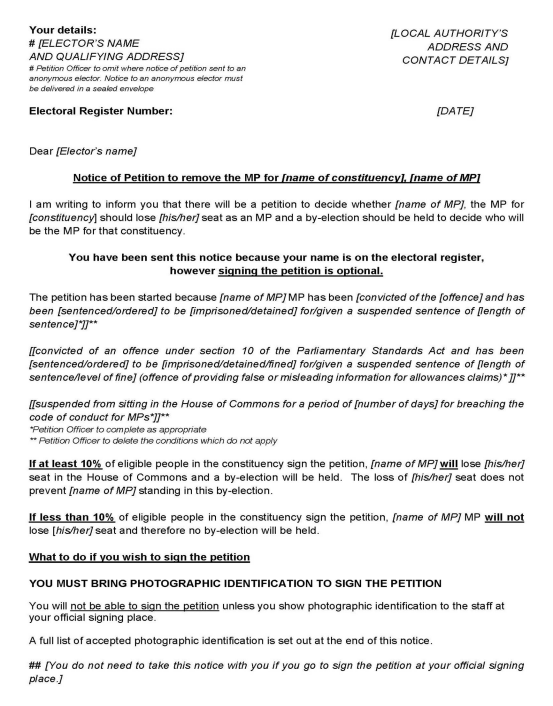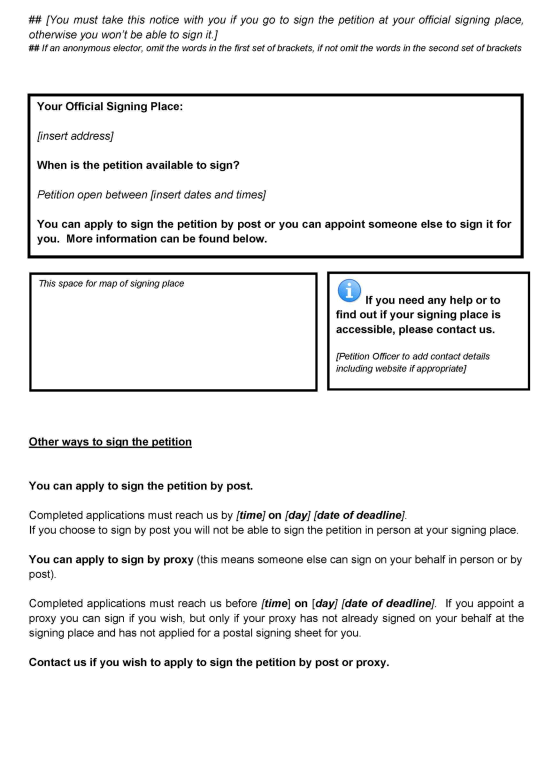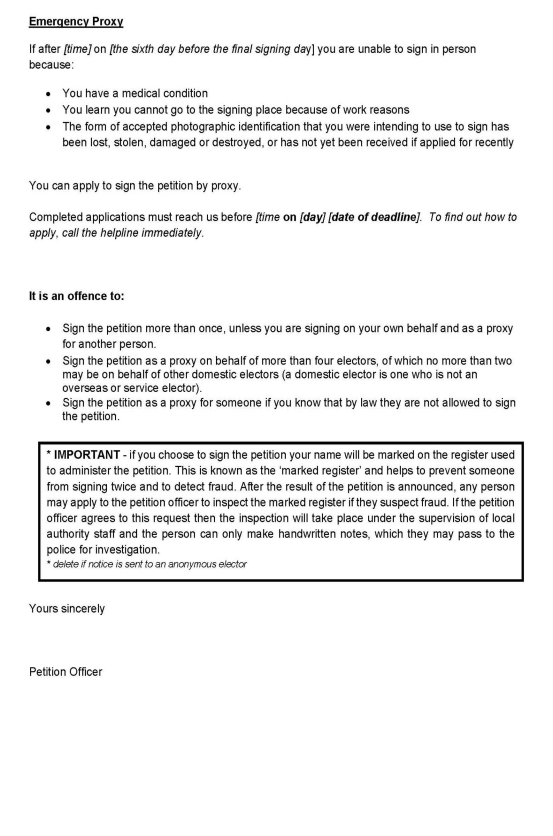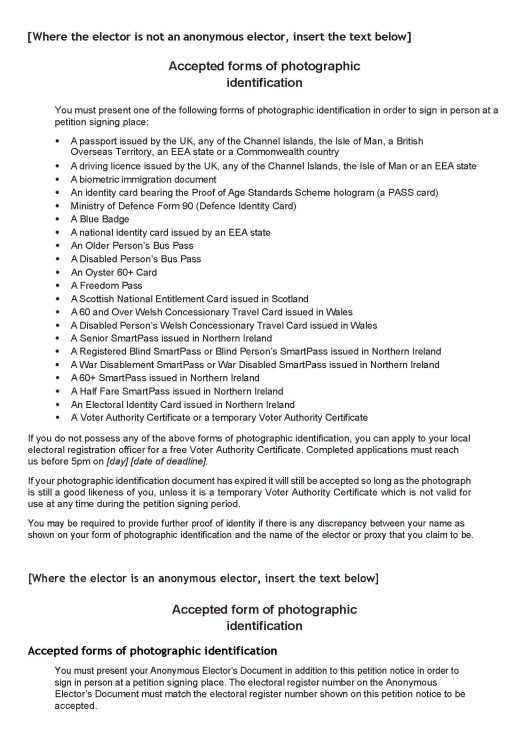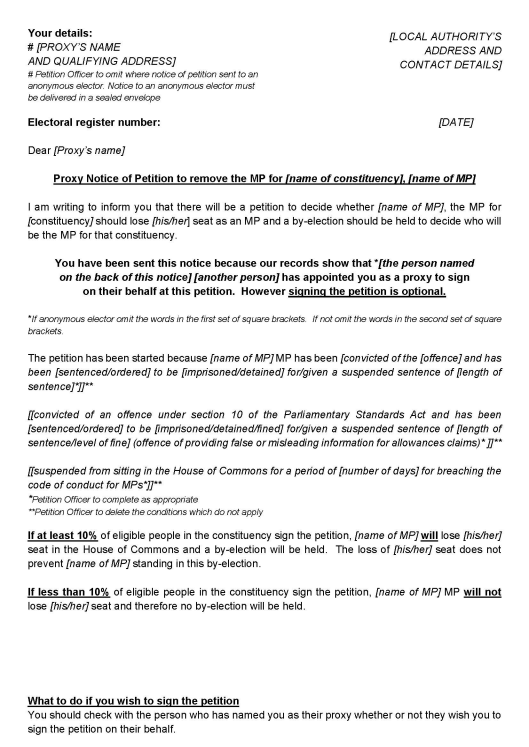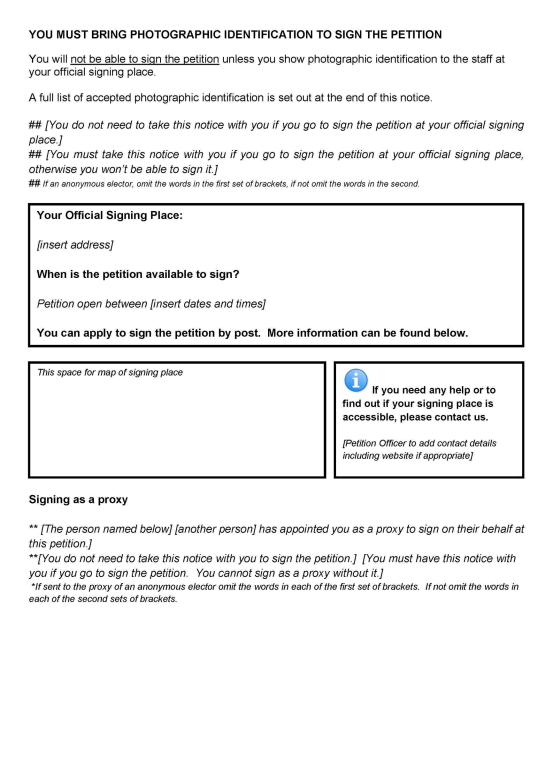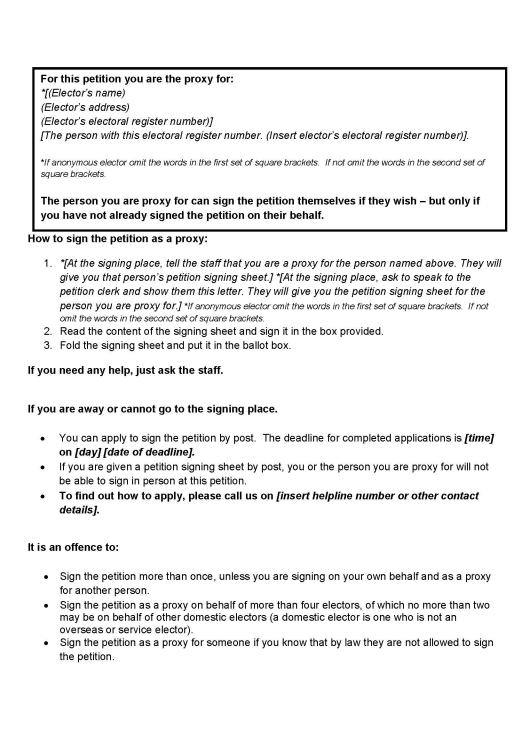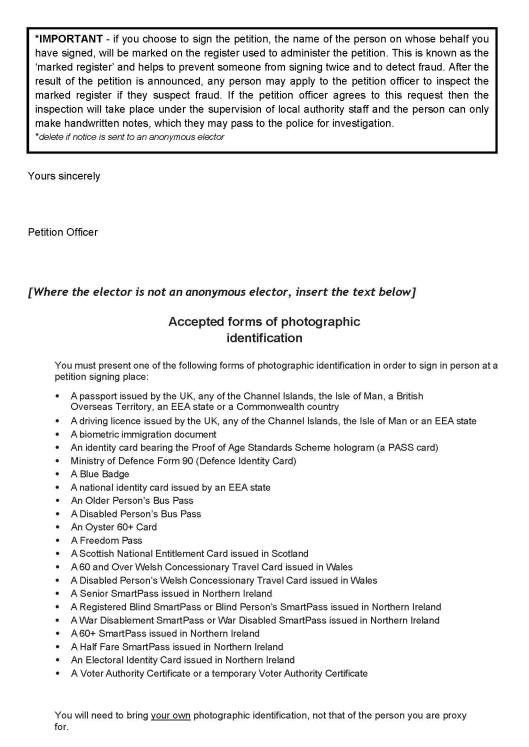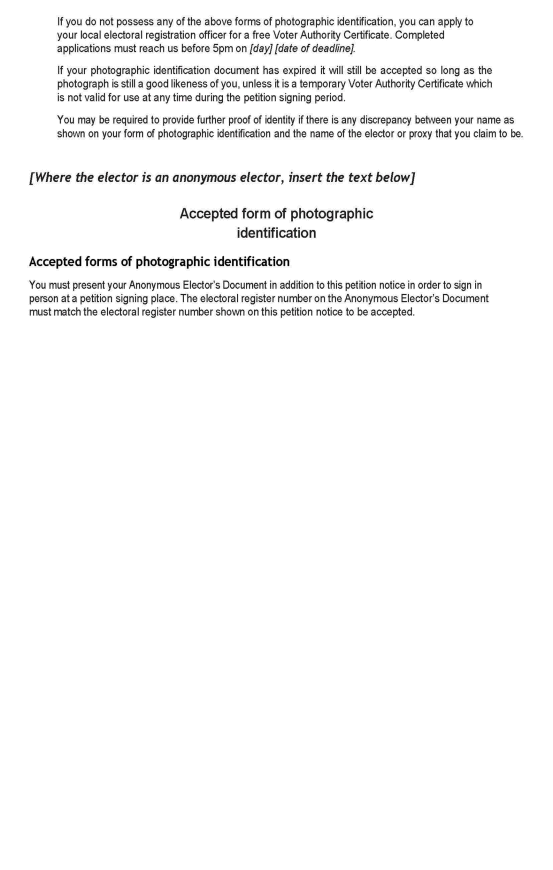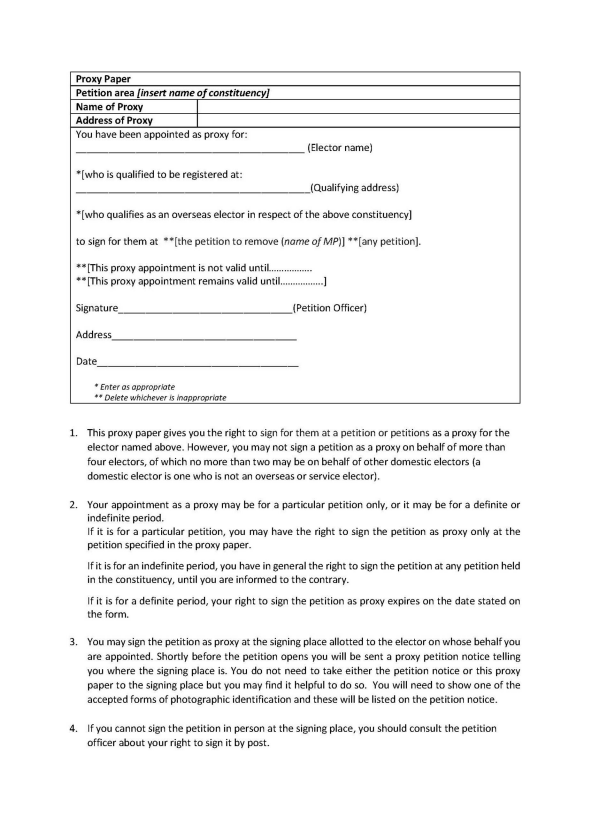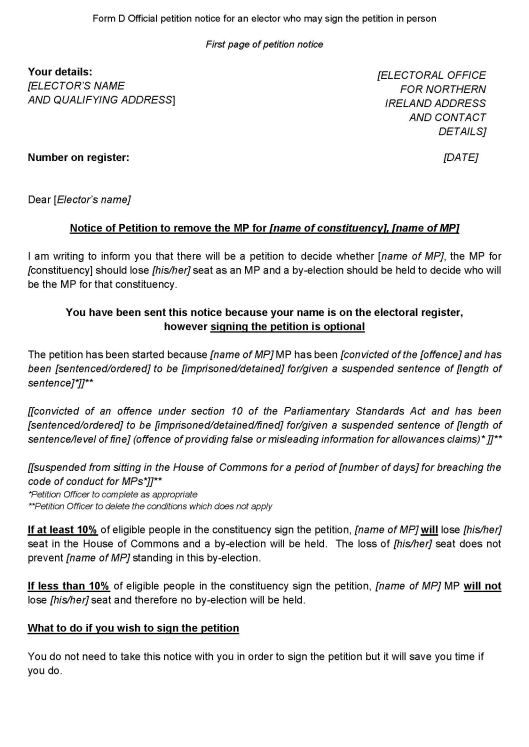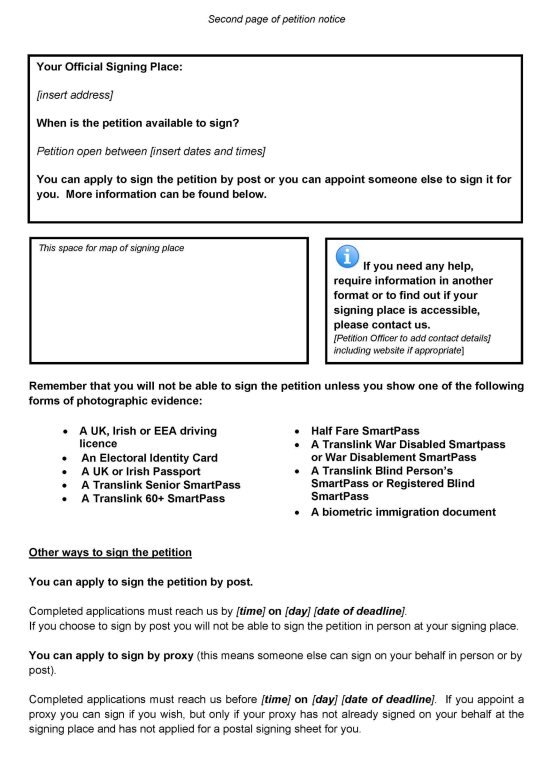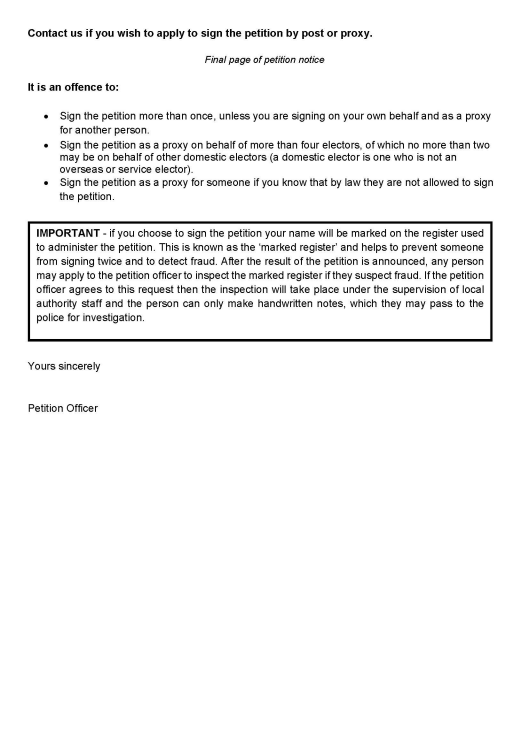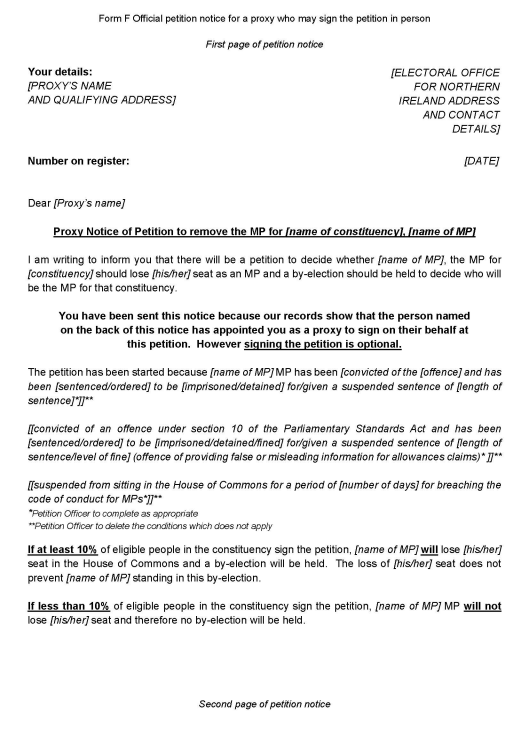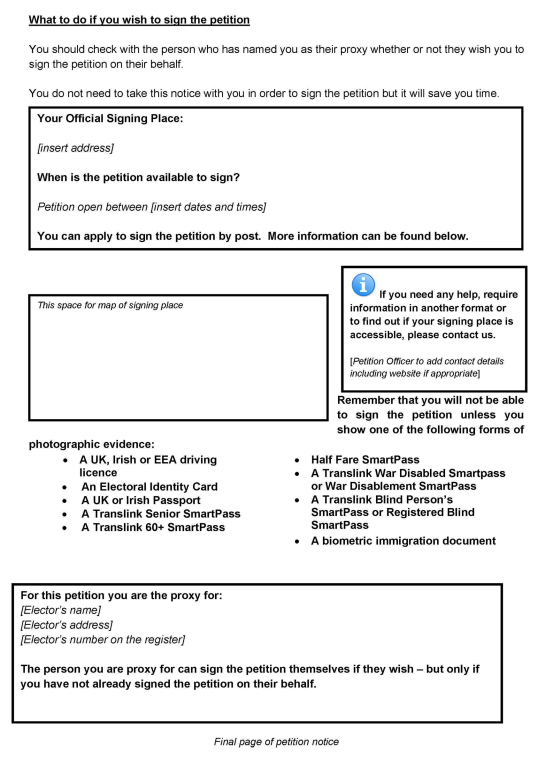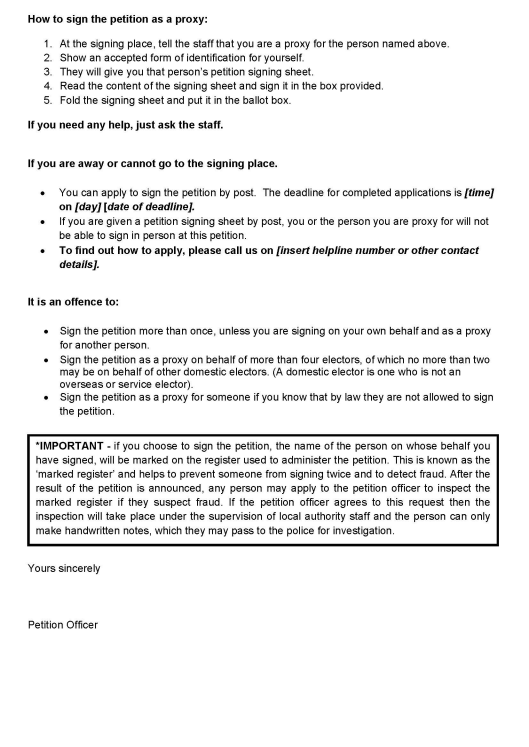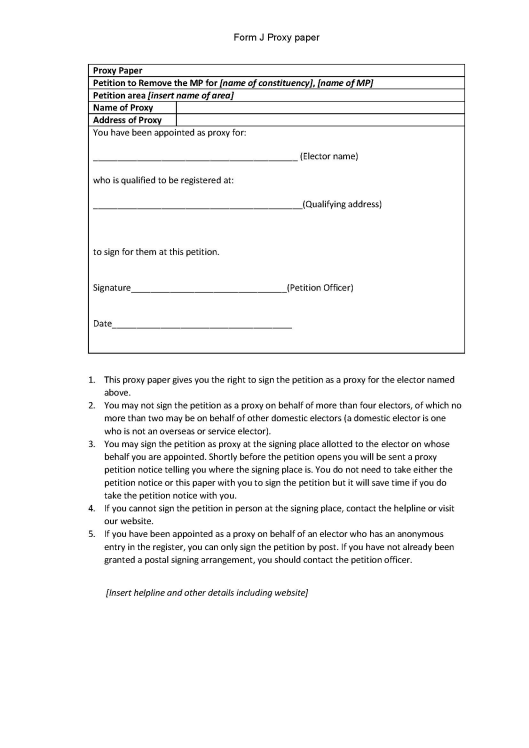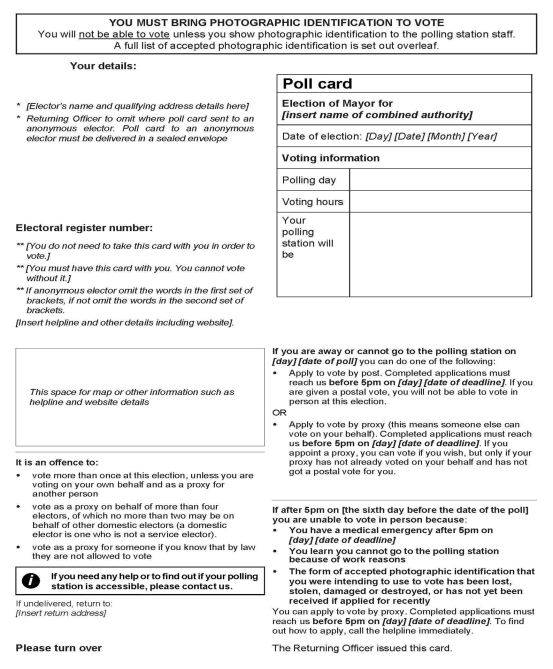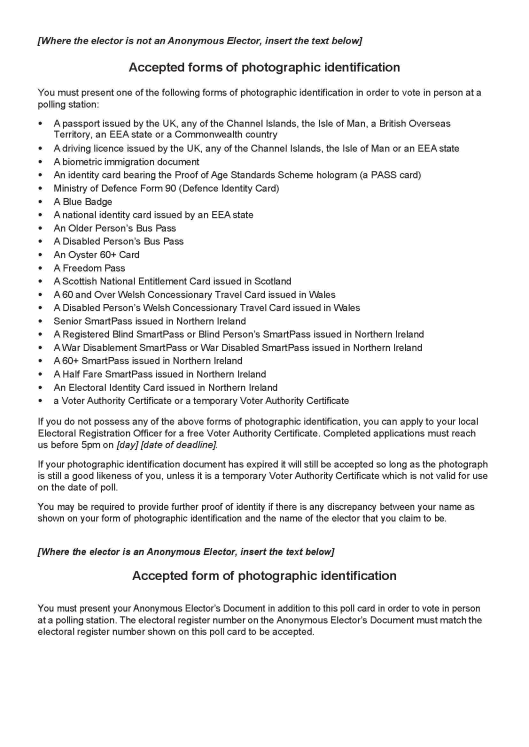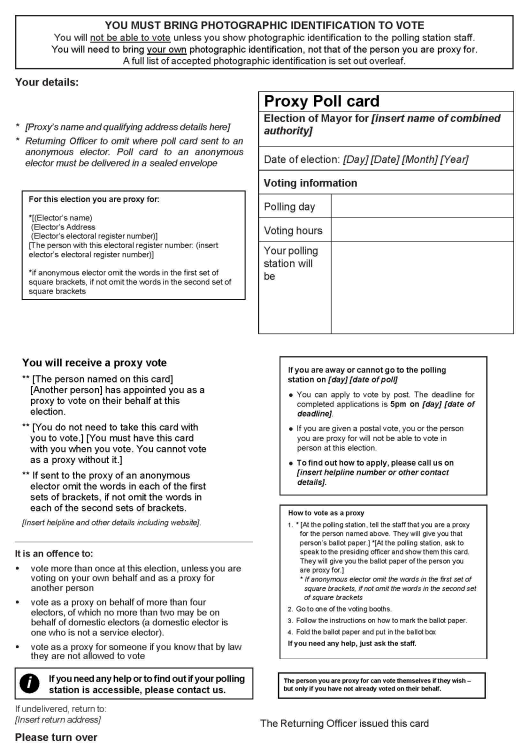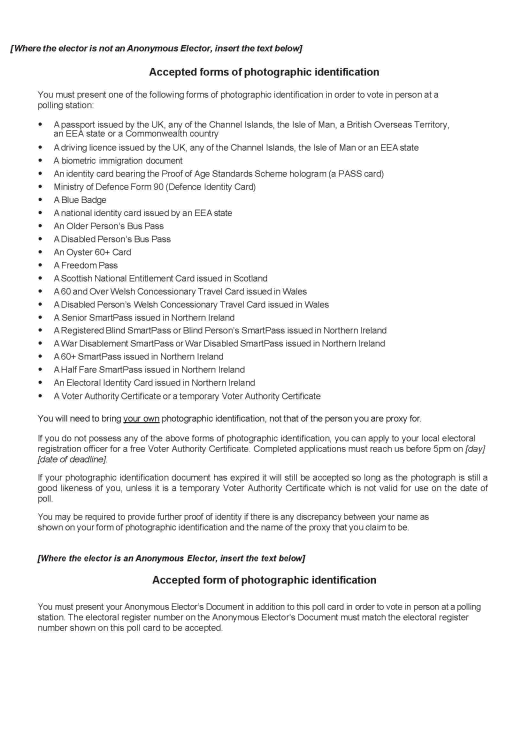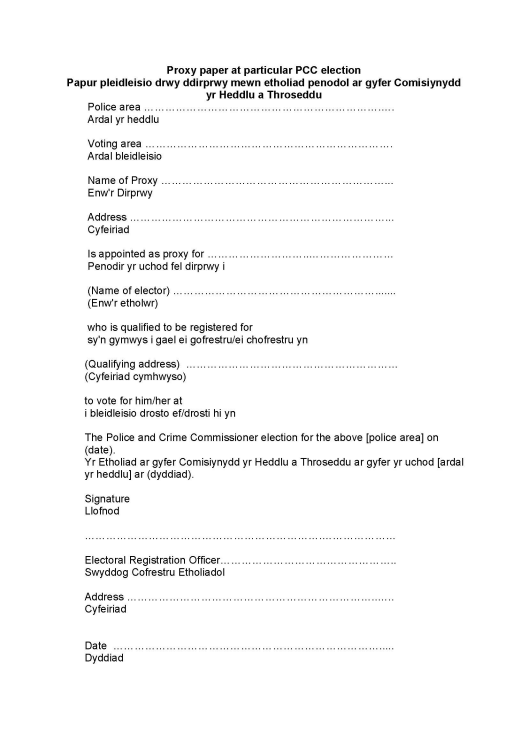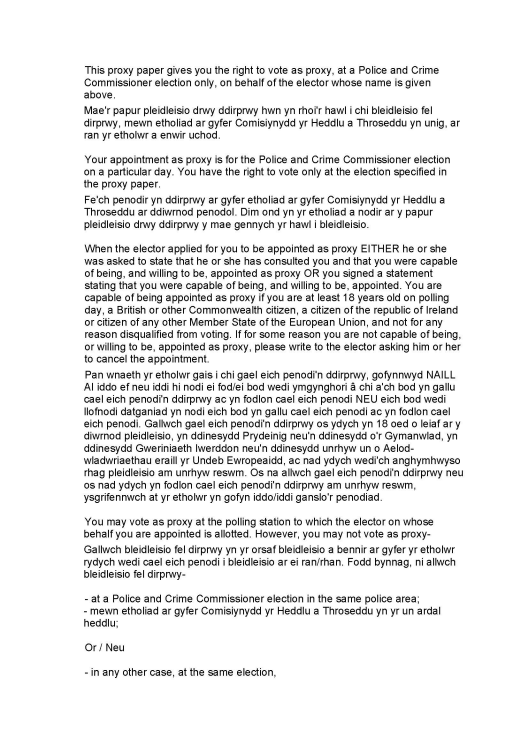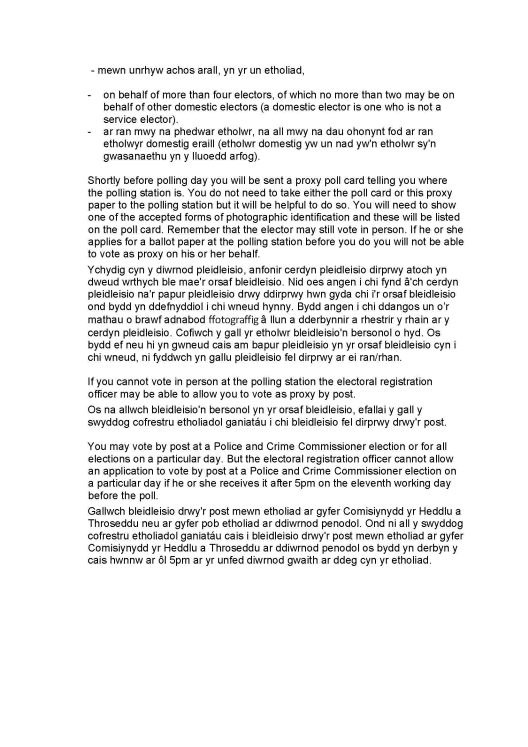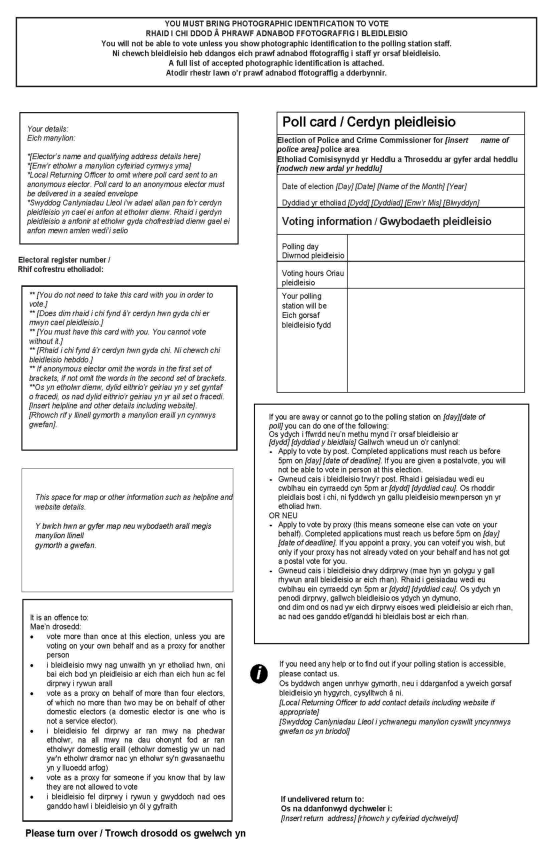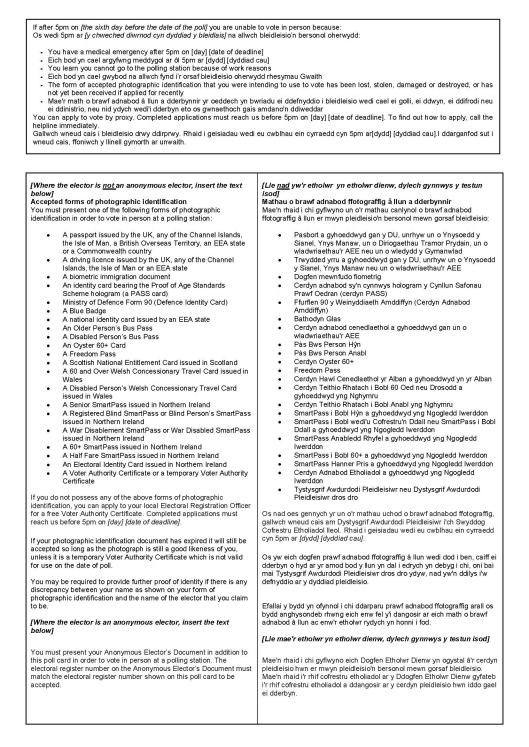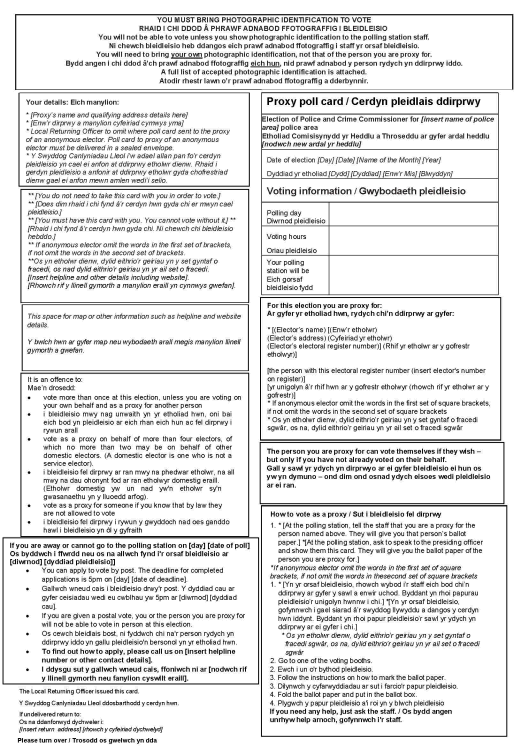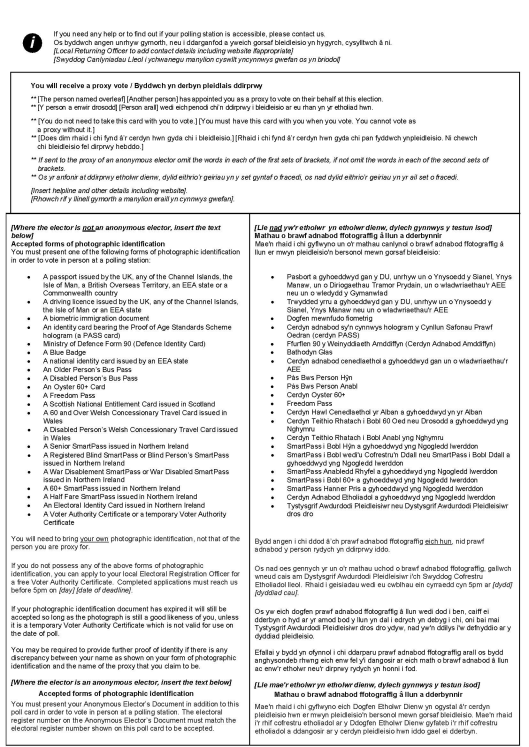Statutory Instruments
2023 No. 1147
Council Tax, England
Local Government, England
Police, England And Wales
Representation Of The People
Town And Country Planning, England
The Representation of the People (Postal and Proxy Voting etc.) (Amendment) Regulations 2023
Made
25th October 2023
Coming into force in accordance with regulation 1(2) to (4)
The Secretary of State makes these Regulations in exercise of the powers conferred by the provisions specified in Schedule 1 to these Regulations.
The Secretary of State has consulted—
(a)the Electoral Commission, in accordance with section 53(5)(a) of the Representation of the People Act 1983(1), paragraph 16(5) of Schedule 4B to the Town and Country Planning Act 1990(2), section 52ZQ(6) of the Local Government Finance Act 1992(3), section 9HE(4) of the Local Government Act 2000(4), section 7(1) and (2)(e), (hc) and (k) of the Political Parties, Elections and Referendums Act 2000(5), and paragraph 12(4) of Schedule 5B to the Local Democracy, Economic Development and Construction Act 2009(6),
(b)the Information Commissioner and such other persons as the Secretary of State considers appropriate, in accordance with section 53(5)(b) and (c) of the Representation of the People Act 1983,
(c)the Scottish Ministers, in accordance with section 15(5C) of the Representation of the People Act 1985(7), and
(d)the Welsh Ministers, in accordance with section 15(5D) of the Representation of the People Act 1985(8).
A draft of these Regulations has been laid before, and approved by a resolution of, each House of Parliament in accordance with section 201(2) of the Representation of the People Act 1983(9), section 333(3A) of the Town and Country Planning Act 1990(10), section 52ZQ(7) of the Local Government Finance Act 1992, section 105(6) of the Local Government Act 2000(11), section 117(2) of the Local Democracy, Economic Development and Construction Act 2009(12), section 154(2)(b) of the Police Reform and Social Responsibility Act 2011(13) and section 21(6) of the Recall of MPs Act 2015(14).
PART 1Introduction
Citation, commencement, extent, transitional provisions and savings
1.—(1) These Regulations may be cited as the Representation of the People (Postal and Proxy Voting etc.) (Amendment) Regulations 2023.
(2) Subject to paragraph (3), these Regulations come into force on 31st October 2023.
(3) The following provisions come into force on 31st January 2024—
(a)regulations 6(b), 11(b), 12, 13 and 14(3), (5), (7) and (9);
(b)regulation 15, except for paragraph (5)(a)(i), (b) and (c);
(c)regulation 16, except for paragraph (5)(a)(i), (b) and (c);
(d)regulation 17(3)(b), (5)(a) to (c) except paragraph (5)(b)(i)(bb), and (6) to (8);
(e)regulation 18, except for paragraph (5)(a)(i), (b) and (c);
(f)in regulation 19, paragraphs (4), (7)(b), (16)(b) and, except so far as it substitutes Form J in Parts 1 and 3 of Schedule 2 to the 2016 Regulations, paragraph (18);
(g)regulation 20;
(h)regulation 21, except so far as it substitutes Form 1 in Schedule 3 to the Police and Crime Commissioner Elections (Welsh Forms) Order 2021(15);
(i)in Schedule 2, paragraphs 4(1), 6, 8(1), 9(1), 11(1), 12, 13(1), 15(1), 16, 17(1), 19(2), 20, 21(1), 23(1), 28(1), 29, 30(1), 32(1), 34(2), 37(1), 41(1) and 42(1).
(4) This Part extends to England and Wales, Scotland and Northern Ireland.
(5) In Parts 2 to 4—
(a)the amendments made by regulation 19(13) and (15) extend to England and Wales and Scotland;
(b)otherwise, any amendment made has the same extent as the provision amended.
(6) Schedule 2 (transitional provisions and savings) has effect.
PART 2Amendment of the Representation of the People (England and Wales) Regulations 2001
Introduction to Part 2
2. The Representation of the People (England and Wales) Regulations 2001(16) are amended in accordance with this Part.
Amendment of Part 1 (general, interpretation and miscellaneous)
3.—(1) Part 1 (general, interpretation and miscellaneous) is amended as follows.
(2) In regulation 3 (interpretation)—
(a)in paragraph (1)—
(i)for the definition of “digital service” substitute—
““digital service” means the Individual Electoral Registration Digital Service, which is the digital service provided by the Secretary of State for Levelling Up, Housing and Communities for (amongst other purposes) the purpose of—
processing online applications under sections 10ZC and 10ZD of the 1983 Act(17) and online relevant absent voting applications,
verifying information under regulations 29ZA and 56B, and
data matching under regulation 32ZBB in respect of the annual canvass for a register of parliamentary electors or local government electors in England or Wales;”;
(ii)after the definition of “registration officer” insert—
““relevant absent voting application” has the meaning given in paragraph 1A(7)(a)(i) of Schedule 2 to the 1983 Act(18);”;
(b)after paragraph (3A) insert—
“(3B) A document provided in accordance with regulation 51(9) or 56C may be transmitted by an applicant to a registration officer by electronic means.”.
(3) In regulation 5 (communication of applications, notices etc.)—
(a)in paragraph (1), after “notice” insert “, relevant attestation”;
(b)after paragraph (2), insert—
“(3) In paragraph (1), “relevant attestation” means an attestation under regulation 56C(6).”.
(4) In regulation 6 (electronic signatures and related certificates) after paragraph (3) insert—
“(4) This regulation does not apply in relation to a relevant absent voting application, for which the general requirements are set out in regulation 51.”.
Amendment of Part 3 (registration)
4.—(1) Part 3 (registration) is amended as follows.
(2) In regulation 26 (applications for registration)—
(a)in paragraph (11), after “receives” insert “, subject to paragraph (12),”;
(b)after paragraph (11) insert—
“(12) Where an application made through the digital service in accordance with paragraph (9) includes the applicant’s national insurance number the Secretary of State—
(a)may send the registration officer that application without the national insurance number, and
(b)where the Secretary of State does so, must indicate to the registration officer that a national insurance number was included when the application was made by the applicant.”.
(3) In regulation 29ZB (processing of information provided in connection with an application under section 10ZC or 10ZD)—
(a)in paragraph (2)(a), at the end insert “transmitted to the registration officer by the Secretary of State”;
(b)in paragraph (5)—
(i)omit the “or” after sub-paragraph (a);
(ii)after sub-paragraph (a) insert—
“(aa)in the case of information disclosed under regulation 29ZA, for the purposes of determining—
(i)a relevant absent voting application made by the same applicant where that information is used by the Secretary of State to complete in part the relevant absent voting application by virtue of regulation 51(7)(a),
(ii)an application for an absent vote made under Part 1 of Schedule 2 to the Police and Crime Commissioner Elections Order 2012(19) by the same applicant where that information is used by the Secretary of State to complete in part that application by virtue of paragraph 11(5A)(a) of Schedule 2 to that Order,
(iii)an application for absent signing made under Part 4 of the Recall of MPs Act 2015 (Recall Petition) Regulations 2016(20) by the same applicant where that information is used by the Secretary of State to complete in part that application by virtue of regulation 60(6A)(a) of those Regulations, or
(iv)an identity document application, as defined by regulation 3(1) of the Voter Identification Regulations 2022(21), made by the same applicant where that information is used by the Secretary of State to complete in part that application by virtue of regulation 5(2) of those Regulations, or”.
Amendment of Part 4 (absent voters)
5.—(1) Part 4 (absent voters) is amended as follows.
(2) In regulation 50 (interpretation of Part 4), after the definition of “allotted polling station” insert—
““the maximum period” means the period specified in paragraph 3(1A)(a) or (1B)(a) of Schedule 4(22).”.
(3) In regulation 51 (general requirements for applications for an absent vote)—
(a)in paragraph (2), after sub-paragraph (a) insert—
“(aa)for a relevant absent voting application, the applicant’s national insurance number or, if they are not able to provide that information, the reason why they are not able to do so;”;
(b)in paragraph (4), after “indefinite period” insert “, the maximum period”;
(c)after paragraph (6) insert—
“(7) Where, by virtue of arrangements made by the Secretary of State, a relevant absent voting application may be made through the digital service—
(a)the Secretary of State may complete the application in part using information provided by the applicant as part of an application, or partially completed application, under section 10ZC or 10ZD of the 1983 Act for registration in, or alteration of, a register of electors made through or completed using the digital service;
(b)where the application is required to contain a signature, the application must contain a compliant photograph or electronic scan of the applicant’s signature;
(c)the Secretary of State must—
(i)request that the applicant provide their most recent previous name (if they have one), and
(ii)provide an explanation of the purpose for which the information will be used.
(8) In paragraph (7)(b), “compliant photograph or electronic scan of the applicant’s signature” means—
(a)the signature contained in the photograph or electronic scan complies with the requirements of sub-paragraph (a) of paragraph (3A), and
(b)the photograph or electronic scan of the signature is sufficiently clear and unambiguous so as to comply with the requirements of paragraph (3A).
(9) Where an applicant is unable to provide a national insurance number in accordance with paragraph (2)(aa), the applicant may provide as part of the application a copy of any of the documents listed in regulation 56C(2) to (4).
(10) The Secretary of State must send to the registration officer—
(a)subject to paragraph (11), any relevant absent voting application the Secretary of State receives,
(b)the applicant’s previous name (if any provided),
(c)any copy documentation provided by the applicant in accordance with paragraph (9), and
(d)a reference number unique to that application.
(11) Where a relevant absent voting application made through the digital service in accordance with paragraph (7) includes the applicant’s national insurance number the Secretary of State—
(a)may send the registration officer that application without the national insurance number, and
(b)where the Secretary of State does so, must indicate to the registration officer that a national insurance number was included when the application was made by the applicant.”.
(4) In regulation 52 (additional requirements for applications for the appointment of a proxy)—
(a)in paragraph (1), omit “together with his family relationship, if any, with the applicant,”;
(b)after paragraph (1) insert—
“(1ZA) If the application for the appointment of a proxy is for the purposes of voting by proxy at a local government election in Wales, the application must also state the family relationship, if any, of the proxy with the applicant.”.
(5) In regulation 55 (additional requirements for applications for a proxy vote in respect of a particular election), after paragraph (5) insert—
“(5A) Where an application under paragraph 4(2) of Schedule 4(23) is made after 5pm on the sixth day before the date of the poll at the election for which it is made because the circumstances set out in paragraph (3F)(a) of regulation 56 apply, the application must (in addition to providing any other information required by this Part) state that it is being made because of those circumstances.”.
(6) In regulation 55B (additional requirements for application for an emergency proxy vote in respect of a particular parliamentary election or local government election in England: grounds relating to voter identification)—
(a)in paragraph (1), for “paragraph (2)” substitute “paragraphs (2) and (2A)”;
(b)after paragraph (2) insert—
“(2A) This regulation does not apply where regulation 56(3D) applies to an application by virtue only of the circumstances set out in paragraph (3F).”.
(7) In regulation 56 (closing date for applications)—
(a)in paragraph (3D), after “voter identification” insert “or in the circumstances set out in paragraph (3F)”;
(b)after paragraph (3E) insert—
“(3F) The circumstances are that—
(a)the applicant submitted the application because an earlier application submitted by that applicant under paragraph 3(2) or 6(7) of Schedule 4 is to be disregarded for the purposes of the election referred to in paragraph (3D) because that earlier application—
(i)was submitted prior to the deadline of 5pm on the sixth day before the date of the poll at the election referred to in paragraph (3D),
(ii)was submitted via the digital service, and
(iii)was not received by the registration officer until after the deadline of 5pm on the sixth day before the date of the poll at the election referred to in paragraph (3D) due to a technical defect in the digital service, or
(b)the application referred to in paragraph (3D) meets the conditions specified in paragraphs (i), (ii) and (iii) of sub-paragraph (a).”.
(8) After regulation 56A (grounds relating to voter identification) insert—
“Verification of information provided in a relevant absent voting application
56B.—(1) On receipt of a relevant absent voting application made otherwise than through the digital service, a registration officer must disclose the applicant’s name or names, address, date of birth and national insurance number (“the first stage information”) to the Secretary of State for Levelling Up, Housing and Communities in such format and through such an infrastructure system as the Secretary of State for Levelling Up, Housing and Communities may have notified to the registration officer in writing.
(2) Following receipt of the first stage information from the registration officer or, in the case of an application made through or partially completed using the digital service, from an applicant, the Secretary of State for Levelling Up, Housing and Communities may disclose the first stage information to the Secretary of State for Work and Pensions.
(3) Where the first stage information has been disclosed to the Secretary of State for Work and Pensions under paragraph (2), the Secretary of State for Work and Pensions may compare it against—
(a)the name, address, date of birth and national insurance number of individuals appearing in the following types of data kept by the Secretary of State—
(i)data kept for the purposes of functions relating to social security (including such information kept on behalf of the Department for Social Development), and
(ii)data relating to working tax credit, child tax credit and child benefit (being information kept on behalf of His Majesty’s Revenue and Customs), and
(b)any other information contained in such types of data which relates to the information disclosed under paragraph (2).
(4) The Secretary of State for Work and Pensions may disclose the results of the comparison of the first stage information (“the second stage information”) to the Secretary of State for Levelling Up, Housing and Communities.
(5) On receipt of the second stage information, the Secretary of State for Levelling Up, Housing and Communities may disclose that information—
(a)to the Secretary of State for Work and Pensions, or
(b)to the registration officer to whom the application has been made or, in the case of an application made through the digital service, the registration officer appointed for the register to which the application relates.
(6) Paragraph (3) applies to the second stage information where it has been disclosed to the Secretary of State for Work and Pensions under paragraph (5)(a) as it applies to the first stage information disclosed under paragraph (2).
(7) The Secretary of State for Work and Pensions may disclose the results of the comparison of the second stage information (“the third stage information”) to the Secretary of State for Levelling Up, Housing and Communities.
(8) On receipt of the third stage information, the Secretary of State for Levelling Up, Housing and Communities may—
(a)compare the third stage information against the information provided in the relevant absent voting application, and
(b)notify the registration officer to whom the application has been made or, in the case of an application made through the digital service, the registration officer appointed for the register to which the application relates, as to whether the comparison in sub-paragraph (a) resulted in a match.
(9) The registration officer must take into account any information disclosed by, or notification received from, the Secretary of State for Levelling Up, Housing and Communities in accordance with this regulation when determining the application.
(10) This regulation does not apply in relation to an application under paragraph 4(2) of Schedule 4—
(a)which is received by the registration officer after 5pm on the sixth day before the date of the poll at the election for which it is made, and
(b)where regulation 56(3A) or (3D) applies.
(11) In paragraph (1)—
(a)“infrastructure system” has the meaning given in Schedule 3A to the Communications Act 2003(24);
(b)the reference to the applicant’s address is a reference to the address contained in the application in accordance with regulation 51(2)(b).
Power to request additional evidence in relation to relevant absent voting applications where registration officer considers it necessary
56C.—(1) This regulation applies where, upon receipt of a relevant absent voting application, a registration officer considers additional evidence is necessary to verify the identity of the applicant.
(2) The registration officer may require that the applicant give them a copy, or where the registration officer considers it appropriate, the original, of one of the following documents—
(a)the applicant’s passport;
(b)the applicant’s identity card issued in the European Economic Area;
(c)the applicant’s biometric immigration document issued in the United Kingdom in accordance with regulations made under section 5 of the Borders Act 2007(25);
(d)the applicant’s electoral identity card issued in Northern Ireland;
(e)the applicant’s photocard driving licence granted in the United Kingdom or driving licence granted by a Crown Dependency, which bears a photograph of the applicant.
(3) Where an applicant is not able to give one of the documents in paragraph (2), the registration officer may require that the applicant give them a copy, or where the registration officer considers it appropriate, the original, of—
(a)one of the following documents, which, except in relation to paragraph (vii), must have been issued in the United Kingdom or Crown Dependencies—
(i)the applicant’s birth certificate;
(ii)the applicant’s marriage or civil partnership certificate;
(iii)the applicant’s adoption certificate;
(iv)the applicant’s firearms certificate granted under the Firearms Act 1968(26);
(v)the record of a decision on bail made in respect of the applicant in accordance with section 5(1) of the Bail Act 1976(27);
(vi)the applicant’s driving licence, which is not in the form of a photocard;
(vii)the applicant’s driving licence granted other than in the United Kingdom or Crown Dependencies, which bears a photograph of the applicant and which must be valid for at least 12 months from the date the applicant entered the United Kingdom, and
(b)two other documents, each of which may be either from sub-paragraph (a) or from paragraph (4).
(4) Where the applicant is not able to give documents in accordance with paragraph (3), the registration officer may require that the applicant give them a copy, or where the registration officer considers it appropriate, the original, of four documents, each of which may be any of the following kinds of evidence and which must bear the applicant’s full name—
(a)a financial statement, including but not limited to—
(i)a mortgage statement;
(ii)a bank or building society statement or a letter from a bank or building society confirming that the applicant has opened an account with that bank or building society;
(iii)a credit card statement;
(iv)a pension statement;
(b)a council tax demand letter or statement;
(c)a utility bill;
(d)a Form P45 or Form P60 issued to the applicant by their employer or former employer;
(e)a statement of benefits or entitlement to benefits, such as a statement of child benefit, within the meaning of section 141 of the Social Security Contributions and Benefits Act 1992(28), or a letter confirming that the applicant is entitled to housing benefit, within the meaning of section 130 of that Act(29).
(5) Where the applicant is registered, or has applied to be registered, in pursuance of an overseas elector’s declaration—
(a)paragraph (3) applies as if, in sub-paragraph (a)(vii), the words from “and which must” to “Kingdom” were omitted;
(b)paragraph (4) applies as if after “kinds of evidence” there were inserted “, must have been issued in the United Kingdom or Crown Dependencies”.
(6) If an applicant is unable to give the documentary evidence required under paragraphs (2) to (4), the registration officer may require that the applicant give an attestation which must—
(a)confirm that the applicant is the person named in the application,
(b)be in writing and signed by a qualifying attestor,
(c)state the qualifying attestor’s full name, date of birth, occupation, residential address and (if different) the address in respect of which the qualifying attestor is registered as an elector,
(d)state—
(i)where the qualifying attestor is registered in pursuance of an overseas elector’s declaration, the attestor’s British passport number together with its date and place of issue;
(ii)otherwise—
(aa)where the qualifying attestor is registered in respect of an address in Northern Ireland and has been allocated a digital registration number in accordance with section 10B of the 1983 Act (register of electors in Northern Ireland: digital registration number)(30), that digital registration number;
(bb)in all other cases, the qualifying attestor’s electoral number,
(e)include an explanation as to the qualifying attestor’s ability to confirm that the applicant is the person named in the application, including (but not limited to) the qualifying attestor’s connection to the applicant and the length of time that that connection has existed,
(f)include—
(i)an indication that the qualifying attestor is aware of section 13D(1) of the 1983 Act (offence of provision of false information to a registration officer) (31), and
(ii)a declaration by the qualifying attestor that all information provided in the attestation is true, and
(g)state the date on which it is made.
(7) In paragraph (6), a “qualifying attestor” is a person—
(a)where the applicant is or is to be registered in pursuance of an overseas elector’s declaration, who is aged 18 or over,
(b)who is not the spouse, civil partner, parent, grandparent, brother, sister, child or grandchild of the applicant,
(c)who is registered as an elector and, except where the applicant is or is to be registered in pursuance of an overseas elector’s declaration, who is registered as an elector in a local authority area in England or Wales,
(d)except where the person is registered in pursuance of an overseas elector’s declaration, whom the registration officer is satisfied is of good standing in the community, and
(e)who has not already signed a relevant identity attestation for two other applicants since, whichever is the later,—
(i)the date on which the revised register in which the qualifying attestor’s name appears was last published under section 13(1) of the 1983 Act(32);
(ii)the date on which a notice specifying the qualifying attestor’s entry in the register was issued under (as the case may be) section 13A(2), 13AB(2), 13B or 13BC of that Act(33) (and if there has been more than one such notice, the date on which the last one was issued).
(8) In paragraph (7)(e), a “relevant identity attestation” is an attestation provided in accordance with—
(a)paragraph (6);
(b)regulation 26B(6);
(c)regulation 26B(6) or 56C(6) of the Representation of the People (Scotland) Regulations 2001(34);
(d)paragraph 16C(5) of Schedule 2 to the Police and Crime Commissioner Elections Order 2012;
(e)regulation 72B(6) of the Recall of MPs Act 2015 (Recall Petition) Regulations 2016;
(f)regulation 7(6) of the Voter Identification Regulations 2022.
(9) Paragraphs (2) to (6) do not apply where the applicant is registered, or has applied to be registered, in a register of parliamentary electors or a register of local government electors in England in pursuance of the following declarations—
(a)a service declaration on the grounds that the applicant is a Crown servant or the spouse or civil partner of a Crown servant;
(b)a service declaration on the grounds that the applicant is a member of the forces;
(c)a service declaration on the grounds that the applicant is the spouse or civil partner of a member of the forces.
(10) In the case of an application to which paragraph (9)(a) or (c) applies, the registration officer may require that the applicant give them a copy, or where the registration officer considers it appropriate, the original, of one of the following documents, which has been certified by a Crown servant or British Council employee or an officer of the forces, who is not the applicant’s spouse or civil partner—
(a)the applicant’s passport;
(b)the applicant’s identity card issued in the European Economic Area.
(11) In the case of an application to which paragraph (9)(b) applies, the registration officer may require that the applicant give an attestation which must—
(a)confirm that the applicant is the person named in the application,
(b)be in writing and signed by an officer of the forces who is not the spouse, civil partner, parent, grandparent, brother, sister, child or grandchild of the applicant,
(c)state the full name, address and rank of the person signing the attestation and the service (whether naval, military or air forces) in which they serve, and
(d)state the date on which it is made.
(12) In this regulation—
“Crown Dependency” means the Bailiwick of Jersey, the Bailiwick of Guernsey or the Isle of Man;
“member of the forces” has the same meaning as in section 59(1) of the 1983 Act(35);
“officer of the forces” means a member of the forces who is an officer.
(13) This regulation does not apply in relation to an application under paragraph 4(2) of Schedule 4—
(a)which is received by the registration officer after 5pm on the sixth day before the date of the poll at the election for which it is made, and
(b)where regulation 56(3A) or (3D) applies.
Processing of information provided in connection with a relevant absent voting application
56D.—(1) If a person provides an original document under regulation 56C, the registration officer must make a copy of that document and return the original document to the person who provided it.
(2) In respect of any relevant absent voting application, the registration officer must retain until the application has been determined—
(a)the application form or, in the case of an application made through the digital service, the information contained in the application transmitted to the registration officer by the Secretary of State;
(b)any other information or documents provided to the registration officer in connection with the application or, in the case of original documents which are returned under paragraph (1), a copy of such documents.
(3) Subject to paragraph (4), the registration officer may retain the application form, information and documents in paragraph (2) after the application has been determined but, if they do so, must delete the applicant’s national insurance number from the application form, information and documents in paragraph (2) by no later than the date which is 13 months from the date on which the registration officer determined the relevant absent voting application.
(4) The requirement to delete the national insurance number in paragraph (3) does not apply where the application, information and documents in paragraph (2) are required for the purpose of any civil or criminal proceedings.
(5) Information disclosed under regulation 56B must not be disclosed to any other person, except—
(a)for the purpose of determining the relevant absent voting application in connection with which the information was disclosed, or
(b)for the purpose of any civil or criminal proceedings.
(6) A person who discloses information in breach of paragraph (5) is guilty of an offence and liable—
(a)on conviction on indictment, to imprisonment for a term not exceeding two years, or to a fine (or both);
(b)on summary conviction, to imprisonment for a term not exceeding the general limit in a magistrates’ court, or to a fine (or both).
(7) Any information disclosed under regulation 56B must be processed in accordance with any requirements as to the processing of information that may have been imposed by the Secretary of State for Levelling Up, Housing and Communities in writing in advance of that processing, including requirements as to the transfer, storage, destruction and security of that information.
(8) In this regulation, “copy” includes an electronic copy.”.
(9) In regulation 57 (grant or refusal of applications)—
(a)after paragraph (1) insert—
“(1A) Where a registration officer grants an application to vote by post at a parliamentary election or a local government election in England, the notification under paragraph (1) must include—
(a)where the postal vote entitlement is for a particular election, the date of the poll for which the elector’s entitlement to vote by post has been granted;
(b)otherwise, the date on which the elector’s entitlement to vote by post ends.”;
(b)in paragraph (3), at the end insert “in respect of the appointment of a proxy for the purpose of voting at a local government election or local government elections in Wales”;
(c)after paragraph (3) insert—
“(3A) The form of proxy paper in Form E1 is prescribed for the purposes of paragraph 6(9) of Schedule 4 in respect of the appointment of a proxy for the purpose of voting—
(a)at a parliamentary election, or at parliamentary elections;
(b)at a local government election, or at local government elections, in England.”;
(d)after paragraph (6) insert—
“(7) Paragraphs (8) to (10) apply where—
(a)an application under Schedule 4 relates to voting at a parliamentary election or at a local government election in England, and
(b)either—
(i)paragraph (2) of regulation 51AA applies to that application, or would have applied if paragraph (3) of that regulation were ignored, or
(ii)paragraph (1) of regulation 51B applies to that application, or would have applied if paragraph (2) of that regulation were ignored.
(8) A notification under paragraph (1) or (4A) to one of the following types of applicants must also include a statement that ballot papers will be sent to the postal ballot delivery address—
(a)an applicant registered in pursuance of an overseas elector’s declaration;
(b)an applicant registered in pursuance of a service declaration;
(c)an applicant registered in pursuance of a declaration of local connection (within the meaning of section 7B of the 1983 Act(36));
(d)an applicant who is a merchant seaman (within the meaning of section 6 of the 1983 Act(37));
(e)an applicant who has an anonymous entry.
(9) Where sub-paragraphs (a) to (e) of paragraph (8) do not apply to the applicant, the registration officer must, in addition to notifying the applicant in accordance with paragraphs (1), (4), (4A) or (5), notify the applicant in writing that—
(a)the application has been granted, refused or disregarded, and
(b)where the application has been granted, ballot papers will be sent to the postal ballot delivery address.
(10) A notification under paragraph (9) must be delivered to—
(a)where paragraph (7)(b)(ii) applies and the notification is to be delivered to a person shown as voting by post in the record kept under paragraph 7(6) of Schedule 4(38), the address shown in that record;
(b)otherwise—
(i)the address stated in the application in accordance with regulation 51(2)(b), or
(ii)the proxy’s address stated in the application in accordance with regulation 51(2)(c).
(11) In paragraphs (8) and (9), the “postal ballot delivery address” means—
(a)where paragraph (7)(b)(i) applies, the address stated in the application in accordance with regulation 51(2)(d);
(b)where paragraph (7)(b)(ii) applies, the different address described in regulation 51B(1).”.
(10) After regulation 60 (inquiries by registration officer) insert—
“Requirement to notify certain electors and proxies that postal vote entitlement is to end
60ZA.—(1) This regulation applies in respect of an elector or proxy who remains entitled to vote by post at a parliamentary election or at a local government election in England by virtue of an entitlement which was granted for the maximum period (“the relevant person”).
(2) The registration officer must, before the end of the maximum period, send to the relevant person—
(a)a notice informing the relevant person of the date on which the relevant person’s entitlement to vote by post is to end, and
(b)information about how to make a fresh application to vote by post (as elector or, as the case may be, as proxy).”.
(11) In regulation 60A (requirement to provide fresh signatures at five yearly intervals), before paragraph (1) insert—
“(A1) This regulation does not apply to an elector or proxy so far as that elector or proxy remains entitled to vote by post at a parliamentary election or at a local government election in England.”.
(12) In regulation 61 (records and lists kept under Schedule 4), in paragraph (7) after “regulation 56(3A)” insert “or (3D)”.
Amendment of Schedule 3 (forms)
6. In Schedule 3 (forms)—
(a)in the arrangement of forms—
(i)in the entry for Form E, after “proxy paper” insert “(local government elections in Wales)”;
(ii)after that entry insert—
“Form E1: Proxy paper (parliamentary elections and local government elections in England)”;
(b)for Form A (official poll card to be sent to an elector voting in person) and Form B (official proxy poll card to be sent to an appointed proxy voting in person) substitute the corresponding forms as set out in Schedule 3;
(c)in Form E—
(i)omit “Constituency”;
(ii)omit “*[” in the first place it occurs;
(iii)omit “]” in the first place it occurs;
(iv)omit “*[who qualifies as an overseas elector in respect of the above constituency]”;
(v)for “*[parliamentary] *[local government]” in both places it occurs substitute “local government”;
(vi)for “*[constituency] *[electoral area]” in both places it occurs substitute “electoral area”;
(vii)in the section titled “Your right to vote as proxy”, in paragraph (2), omit “parliamentary, or”;
(d)after Form E, insert new Form E1 as set out in Schedule 3.
PART 3Amendment of the Representation of the People (Scotland) Regulations 2001
Introduction to Part 3
7. The Representation of the People (Scotland) Regulations 2001 are amended in accordance with this Part.
Amendment of Part 1 (general, interpretation and miscellaneous)
8.—(1) Part 1 (general, interpretation and miscellaneous) is amended as follows.
(2) In regulation 3 (interpretation)—
(a)in paragraph (1)—
(i)for the definition of “digital service” substitute—
““digital service” means the Individual Electoral Registration Digital Service, which is the digital service provided by the Secretary of State for Levelling Up, Housing and Communities for (amongst other purposes) the purpose of—
processing online applications under sections 10ZC and 10ZD of the 1983 Act and online relevant absent voting applications,
verifying information under regulations 29ZA and 56B, and
data matching under regulation 32ZBB in respect of the annual canvass for a register;”;
(ii)after the definition of “registration officer” insert—
““relevant absent voting application” has the meaning given in paragraph 1A(7)(a)(i) of Schedule 2 to the 1983 Act;”;
(b)after paragraph (3A) insert—
“(3B) A document provided in accordance with regulation 51(9) or 56C may be transmitted by an applicant to a registration officer by electronic means.”.
(3) In regulation 5 (communication of applications, notices etc.)—
(a)in paragraph (1), after “notice” insert “, relevant attestation”;
(b)after paragraph (2), insert—
“(3) In paragraph (1), “relevant attestation” means an attestation under regulation 56C(6).”.
(4) In regulation 6 (electronic signatures and related certificates) after paragraph (3) insert—
“(4) This regulation does not apply in relation to a relevant absent voting application, for which the general requirements are set out in regulation 51.”.
Amendment of Part 3 (registration)
9.—(1) Part 3 (registration) is amended as follows.
(2) In regulation 26 (applications for registration)—
(a)in paragraph (11), after “receives” insert “, subject to paragraph (12),”;
(b)after paragraph (11) insert—
“(12) Where an application made through the digital service in accordance with paragraph (9) includes the applicant’s national insurance number the Secretary of State—
(a)may send the registration officer that application without the national insurance number, and
(b)where the Secretary of State does so, must indicate to the registration officer that a national insurance number was included when the application was made by the applicant.”.
(3) In regulation 29ZB (processing of information provided in connection with an application under section 10ZC or 10ZD)—
(a)in paragraph (2)(a), at the end insert “transmitted to the registration officer by the Secretary of State”;
(b)in paragraph (5)—
(i)omit the “or” after sub-paragraph (a);
(ii)after sub-paragraph (a) insert—
“(aa)in the case of information disclosed under regulation 29ZA, for the purposes of determining—
(i)a relevant absent voting application made by the same applicant where that information is used by the Secretary of State to complete in part the relevant absent voting application by virtue of regulation 51(7)(a),
(ii)an application for an absent vote made under Part 1 of Schedule 2 to the Police and Crime Commissioner Elections Order 2012 by the same applicant where that information is used by the Secretary of State to complete in part that application by virtue of paragraph 11(5A)(a) of Schedule 2 to that Order,
(iii)an application for absent signing made under Part 4 of the Recall of MPs Act 2015 (Recall Petition) Regulations 2016 by the same applicant where that information is used by the Secretary of State to complete in part that application by virtue of regulation 60(6A)(a) of those Regulations, or
(iv)an identity document application, as defined by regulation 3(1) of the Voter Identification Regulations 2022, made by the same applicant where that information is used by the Secretary of State to complete in part that application by virtue of regulation 5(2) of those Regulations, or”.
Amendment of Part 4 (absent voters)
10.—(1) Part 4 (absent voters) is amended as follows.
(2) In regulation 50 (interpretation of Part 4), after the definition of “allotted polling station” insert—
““the maximum period” means the period specified in paragraph 3(1A)(a) or (1B)(a) of Schedule 4.”.
(3) In regulation 51 (general requirements for applications for an absent vote)—
(a)in paragraph (2), after sub-paragraph (a) insert—
“(aa)for a relevant absent voting application, the applicant’s national insurance number or, if they are not able to provide that information, the reason why they are not able to do so;”;
(b)in paragraph (4), after “indefinite period” insert “, the maximum period”;
(c)after paragraph (6) insert—
“(7) Where, by virtue of arrangements made by the Secretary of State, a relevant absent voting application may be made through the digital service—
(a)the Secretary of State may complete the application in part using information provided by the applicant as part of an application, or partially completed application, under section 10ZC or 10ZD of the 1983 Act for registration in, or alteration of, a register of electors made through or completed using the digital service;
(b)where the application is required to contain a signature, the application must contain a compliant photograph or electronic scan of the applicant’s signature;
(c)the Secretary of State must—
(i)request that the applicant provide their most recent previous name (if they have one), and
(ii)provide an explanation of the purpose for which the information will be used.
(8) In paragraph (7)(b), “compliant photograph or electronic scan of the applicant’s signature” means—
(a)the signature contained in the photograph or electronic scan complies with the requirements of sub-paragraph (a) of paragraph (3A), and
(b)the photograph or electronic scan of the signature is sufficiently clear and unambiguous so as to comply with the requirements of paragraph (3A).
(9) Where an applicant is unable to provide a national insurance number in accordance with paragraph (2)(aa), the applicant may provide as part of the application a copy of any of the documents listed in regulation 56C(2) to (4).
(10) The Secretary of State must send to the registration officer—
(a)subject to paragraph (11), any relevant absent voting application the Secretary of State receives,
(b)the applicant’s previous name (if any provided),
(c)any copy documentation provided by the applicant in accordance with paragraph (9), and
(d)a reference number unique to that application.
(11) Where a relevant absent voting application made through the digital service in accordance with paragraph (7) includes the applicant’s national insurance number the Secretary of State—
(a)may send the registration officer that application without the national insurance number, and
(b)where the Secretary of State does so, must indicate to the registration officer that a national insurance number was included when the application was made by the applicant.”.
(4) In regulation 52 (additional requirements for applications for the appointment of a proxy)—
(a)in paragraph (1), omit “together with his family relationship, if any, with the applicant,”;
(b)after paragraph (1) insert—
“(1ZA) If the application for the appointment of a proxy is for the purposes of voting at a local government election, the application must also state the family relationship if any, of the proxy with the applicant.”.
(5) In regulation 55 (additional requirements for applications for a proxy vote in respect of a particular election), after paragraph (4) insert—
“(5) Where an application under paragraph 4(2) of Schedule 4 is made after 5pm on the sixth day before the date of the poll at the election for which it is made because the circumstances set out in paragraph (3F)(a) of regulation 56 apply, the application must (in addition to providing any other information required by this Part) state that it is being made because of those circumstances.”.
(6) In regulation 55B (additional requirements for application for an emergency proxy vote in respect of a particular parliamentary election: grounds relating to voter identification)—
(a)in paragraph (1), for “paragraph (2)” substitute “paragraphs (2) and (2A)”;
(b)after paragraph (2) insert—
“(2A) This regulation does not apply where regulation 56(3D) applies to an application by virtue only of the circumstances set out in paragraph (3F).”.
(7) In regulation 56 (closing date for applications)—
(a)in paragraph (3D), after “voter identification” insert “or in the circumstances set out in paragraph (3F)”;
(b)after paragraph (3E) insert—
“(3F) The circumstances are that—
(a)the applicant submitted the application because an earlier application submitted by that applicant under paragraph 3(2) or 6(7) of Schedule 4 is to be disregarded for the purposes of the election referred to in paragraph (3D) because that earlier application—
(i)was submitted prior to the deadline of 5pm on the sixth day before the date of the poll at the election referred to in paragraph (3D),
(ii)was submitted via the digital service, and
(iii)was not received by the registration officer until after the deadline of 5pm on the sixth day before the date of the poll at the election referred to in paragraph (3D) due to a technical defect in the digital service, or
(b)the application referred to in paragraph (3D) meets the conditions specified in paragraphs (i), (ii) and (iii) of sub-paragraph (a).”.
(8) After regulation 56A (grounds relating to voter identification) insert—
“Verification of information provided in a relevant absent voting application
56B.—(1) On receipt of a relevant absent voting application made otherwise than through the digital service, a registration officer must disclose the applicant’s name or names, address, date of birth and national insurance number (“the first stage information”) to the Secretary of State for Levelling Up, Housing and Communities in such format and through such an infrastructure system as the Secretary of State for Levelling Up, Housing and Communities may have notified to the registration officer in writing.
(2) Following receipt of the first stage information from the registration officer or, in the case of an application made through or partially completed using the digital service, from an applicant, the Secretary of State for Levelling Up, Housing and Communities may disclose the first stage information to the Secretary of State for Work and Pensions.
(3) Where the first stage information has been disclosed to the Secretary of State for Work and Pensions under paragraph (2), the Secretary of State for Work and Pensions may compare it against—
(a)the name, address, date of birth and national insurance number of individuals appearing in the following types of data kept by the Secretary of State—
(i)data kept for the purposes of functions relating to social security (including such information kept on behalf of the Department for Social Development), and
(ii)data relating to working tax credit, child tax credit and child benefit (being information kept on behalf of His Majesty’s Revenue and Customs), and
(b)any other information contained in such types of data which relates to the information disclosed under paragraph (2).
(4) The Secretary of State for Work and Pensions may disclose the results of the comparison of the first stage information (“the second stage information”) to the Secretary of State for Levelling Up, Housing and Communities.
(5) On receipt of the second stage information, the Secretary of State for Levelling Up, Housing and Communities may disclose that information—
(a)to the Secretary of State for Work and Pensions, or
(b)to the registration officer to whom the application has been made or, in the case of an application made through the digital service, the registration officer appointed for the register to which the application relates.
(6) Paragraph (3) applies to the second stage information where it has been disclosed to the Secretary of State for Work and Pensions under paragraph (5)(a) as it applies to the first stage information disclosed under paragraph (2).
(7) The Secretary of State for Work and Pensions may disclose the results of the comparison of the second stage information (“the third stage information”) to the Secretary of State for Levelling Up, Housing and Communities.
(8) On receipt of the third stage information, the Secretary of State for Levelling Up, Housing and Communities may—
(a)compare the third stage information against the information provided in the relevant absent voting application, and
(b)notify the registration officer to whom the application has been made or, in the case of an application made through the digital service, the registration officer appointed for the register to which the application relates, as to whether the comparison in sub-paragraph (a) resulted in a match.
(9) The registration officer must take into account any information disclosed by, or notification received from, the Secretary of State for Levelling Up, Housing and Communities in accordance with this regulation when determining the application.
(10) This regulation does not apply in relation to an application under paragraph 4(2) of Schedule 4—
(a)which is received by the registration officer after 5pm on the sixth day before the date of the poll at the election for which it is made, and
(b)where regulation 56(3A) or (3D) applies.
(11) In paragraph (1)—
(a)“infrastructure system” has the meaning given in Schedule 3A to the Communications Act 2003;
(b)the reference to the applicant’s address is a reference to the address contained in the application in accordance with regulation 51(2)(b).
Power to request additional evidence in relation to relevant absent voting applications where registration officer considers it necessary
56C.—(1) This regulation applies where, upon receipt of a relevant absent voting application, a registration officer considers additional evidence is necessary to verify the identity of the applicant.
(2) The registration officer may require that the applicant give them a copy, or where the registration officer considers it appropriate, the original, of one of the following documents—
(a)the applicant’s passport;
(b)the applicant’s identity card issued in the European Economic Area;
(c)the applicant’s biometric immigration document issued in the United Kingdom in accordance with regulations made under section 5 of the Borders Act 2007;
(d)the applicant’s electoral identity card issued in Northern Ireland;
(e)the applicant’s photocard driving licence granted in the United Kingdom or driving licence granted by a Crown Dependency, which bears a photograph of the applicant.
(3) Where an applicant is not able to give one of the documents in paragraph (2), the registration officer may require that the applicant give them a copy, or where the registration officer considers it appropriate, the original, of—
(a)one of the following documents, which, except in relation to paragraph (vii), must have been issued in the United Kingdom or Crown Dependencies—
(i)the applicant’s birth certificate;
(ii)the applicant’s marriage or civil partnership certificate;
(iii)the applicant’s adoption certificate;
(iv)the applicant’s firearms certificate granted under the Firearms Act 1968;
(v)the record of a decision on bail made in respect of the applicant in accordance with section 5(1) of the Bail Act 1976;
(vi)the applicant’s driving licence, which is not in the form of a photocard;
(vii)the applicant’s driving licence granted other than in the United Kingdom or Crown Dependencies, which bears a photograph of the applicant and which must be valid for at least 12 months from the date the applicant entered the United Kingdom, and
(b)two other documents, each of which may be either from sub-paragraph (a) or from paragraph (4).
(4) Where the applicant is not able to give documents in accordance with paragraph (3), the registration officer may require that the applicant give them a copy, or where the registration officer considers it appropriate, the original, of four documents, each of which may be any of the following kinds of evidence and which must bear the applicant’s full name—
(a)a financial statement, including but not limited to—
(i)a mortgage statement;
(ii)a bank or building society statement or a letter from a bank or building society confirming that the applicant has opened an account with that bank or building society;
(iii)a credit card statement;
(iv)a pension statement;
(b)a council tax demand letter or statement;
(c)a utility bill;
(d)a Form P45 or Form P60 issued to the applicant by their employer or former employer;
(e)a statement of benefits or entitlement to benefits, such as a statement of child benefit, within the meaning of section 141 of the Social Security Contributions and Benefits Act 1992, or a letter confirming that the applicant is entitled to housing benefit, within the meaning of section 130 of that Act.
(5) Where the applicant is registered, or has applied to be registered, in pursuance of an overseas elector’s declaration, paragraphs (3) and (4) apply with the following modifications—
(a)paragraph (3) applies as if, in sub-paragraph (a)(vii), the words from “and which must” to “Kingdom” were omitted;
(b)paragraph (4) applies as if after “kinds of evidence” there were inserted “, must have been issued in the United Kingdom or Crown Dependencies”.
(6) If an applicant is unable to give the documentary evidence required under paragraphs (2) to (4), the registration officer may require that the applicant give an attestation which must—
(a)confirm that the applicant is the person named in the application,
(b)be in writing and signed by a qualifying attestor,
(c)state the qualifying attestor’s full name, date of birth, occupation, residential address and (if different) the address in respect of which the qualifying attestor is registered as an elector,
(d)state—
(i)where the qualifying attestor is registered in pursuance of an overseas elector’s declaration, the attestor’s British passport number together with its date and place of issue;
(ii)otherwise—
(aa)where the qualifying attestor is registered in respect of an address in Northern Ireland and has been allocated a digital registration number in accordance with section 10B of the 1983 Act (register of electors in Northern Ireland: digital registration number), that digital registration number;
(bb)in all other cases, the qualifying attestor’s electoral number,
(e)include an explanation as to the qualifying attestor’s ability to confirm that the applicant is the person named in the application, including (but not limited to) the qualifying attestor’s connection to the applicant and the length of time that that connection has existed,
(f)include—
(i)an indication that the qualifying attestor is aware of section 13D(1) of the 1983 Act (offence of provision of false information to a registration officer), and
(ii)a declaration by the qualifying attestor that all information provided in the attestation is true, and
(g)state the date on which it is made.
(7) In paragraph (6), a “qualifying attestor” is a person—
(a)where the applicant is or is to be registered in pursuance of an overseas elector’s declaration, who is aged 18 or over,
(b)who is not the spouse, civil partner, parent, grandparent, brother, sister, child or grandchild of the applicant,
(c)who is registered as an elector, and, except where the applicant is or is to be registered in pursuance of an overseas elector’s declaration, who is registered as an elector in a local authority area in Scotland,
(d)except where the person is registered in pursuance of an overseas elector’s declaration, whom the registration officer is satisfied is of good standing in the community, and
(e)who has not already signed a relevant identity attestation for two other applicants since, whichever is the later,—
(i)the date on which the revised register in which the qualifying attestor’s name appears was last published under section 13(1) of the 1983 Act;
(ii)the date on which a notice specifying the qualifying attestor’s entry in the register was issued under (as the case may be) section 13A(2), 13AB(2), 13B or 13BC of that Act (and if there has been more than one such notice, the date on which the last one was issued).
(8) In paragraph (7)(e), a “relevant identity attestation” is an attestation provided in accordance with—
(a)paragraph (6);
(b)regulation 26B(6);
(c)regulation 26B(6) or 56C(6) of the Representation of the People (England and Wales) Regulations 2001;
(d)paragraph 16C(5) of Schedule 2 to the Police and Crime Commissioner Elections Order 2012;
(e)regulation 72B(6) of the Recall of MPs Act 2015 (Recall Petition) Regulations 2016;
(f)regulation 7(6) of the Voter Identification Regulations 2022.
(9) Paragraphs (2) to (6) do not apply where the applicant is registered, or has applied to be registered, in a register of parliamentary electors or a register of local government electors in England in pursuance of the following declarations—
(a)a service declaration on the grounds that the applicant is a Crown servant or the spouse or civil partner of a Crown servant;
(b)a service declaration on the grounds that the applicant is a member of the forces;
(c)a service declaration on the grounds that the applicant is the spouse or civil partner of a member of the forces.
(10) In the case of an application to which paragraph (9)(a) or (c) applies, the registration officer may require that the applicant give them a copy, or where the registration officer considers it appropriate, the original, of one of the following documents, which has been certified by a Crown servant or British Council employee or an officer of the forces, who is not the applicant’s spouse or civil partner—
(a)the applicant’s passport;
(b)the applicant’s identity card issued in the European Economic Area.
(11) In the case of an application to which paragraph (9)(b) applies, the registration officer may require that the applicant give an attestation which must—
(a)confirm that the applicant is the person named in the application,
(b)be in writing and signed by an officer of the forces who is not the spouse, civil partner, parent, grandparent, brother, sister, child or grandchild of the applicant,
(c)state the full name, address and rank of the person signing the attestation and the service (whether naval, military or air forces) in which they serve, and
(d)state the date on which it is made.
(12) In this regulation—
“Crown Dependency” means the Bailiwick of Jersey, the Bailiwick of Guernsey or the Isle of Man;
“member of the forces” has the same meaning as in section 59(1) of the 1983 Act;
“officer of the forces” means a member of the forces who is an officer.
(13) This regulation does not apply in relation to an application under paragraph 4(2) of Schedule 4—
(a)which is received by the registration officer after 5pm on the sixth day before the date of the poll at the election for which it is made, and
(b)where regulation 56(3A) or (3D) applies.
Processing of information provided in connection with a relevant absent voting application
56D.—(1) If a person provides an original document under regulation 56C, the registration officer must make a copy of that document and return the original document to the person who provided it.
(2) In respect of any relevant absent voting application, the registration officer must retain until the application has been determined—
(a)the application form, or, in the case of an application made through the digital service, the information contained in the application transmitted to the registration officer by the Secretary of State;
(b)any other information or documents provided to the registration officer in connection with the application or, in the case of original documents which are returned under paragraph (1), a copy of such documents.
(3) Subject to paragraph (4), the registration officer may retain the application form, information and documents in paragraph (2) after the application has been determined but, if they do so, must delete the applicant’s national insurance number from the application form, information and documents in paragraph (2) by no later than the date which is 13 months from the date on which the registration officer determined the relevant absent voting application.
(4) The requirement to delete the national insurance number in paragraph (3) does not apply where the application, information and documents in paragraph (2) are required for the purpose of any civil or criminal proceedings.
(5) Information disclosed under regulation 56B must not be disclosed to any other person, except—
(a)for the purpose of determining the relevant absent voting application in connection with which the information was disclosed, or
(b)for the purpose of any civil or criminal proceedings.
(6) A person who discloses information in breach of paragraph (5) is guilty of an offence and liable—
(a)on conviction on indictment, to imprisonment for a term not exceeding two years, or to a fine (or both);
(b)on summary conviction, to imprisonment for a term not exceeding 12 months, or to a fine not exceeding the statutory maximum (or both).
(7) Any information disclosed under regulation 56B must be processed in accordance with any requirements as to the processing of information that may have been imposed by the Secretary of State for Levelling Up, Housing and Communities in writing in advance of that processing, including requirements as to the transfer, storage, destruction and security of that information.
(8) In this regulation, “copy” includes an electronic copy.”.
(9) In regulation 57 (grant or refusal of applications)—
(a)after paragraph (1) insert—
“(1A) Where a registration officer grants an application to vote by post at a parliamentary election, the notification under paragraph (1) must include—
(a)where the postal vote entitlement is for a particular election, the date of the poll for which the elector’s entitlement to vote by post has been granted;
(b)otherwise, the date on which the elector’s entitlement to vote by post ends.”;
(b)in paragraph (3), at the end insert “in respect of the appointment of a proxy for the purpose of voting at a local government election or local government elections”;
(c)after paragraph (3) insert—
“(3A) The form of proxy paper in Form E1 is prescribed for the purposes of paragraph 6(9) of Schedule 4 in respect of the appointment of a proxy for the purpose of voting at a parliamentary election, or at parliamentary elections.”;
(d)after paragraph (6) insert—
“(6A) Paragraphs (6B) to (6D) apply where—
(a)an application under Schedule 4 relates to voting at a parliamentary election, and
(b)either—
(i)paragraph (2) of regulation 51AA applies to that application, or would have applied if paragraph (3) of that regulation were ignored, or
(ii)paragraph (1) of regulation 51B applies to that application, or would have applied if paragraph (1A) of that regulation were ignored.
(6B) A notification under paragraph (1) or (4A) to one of the following types of applicants must also include a statement that ballot papers will be sent to the postal ballot delivery address—
(a)an applicant registered in pursuance of an overseas elector’s declaration;
(b)an applicant registered in pursuance of a service declaration;
(c)an applicant registered in pursuance of a declaration of local connection (within the meaning of section 7B of the 1983 Act);
(d)an applicant who is a merchant seaman (within the meaning of section 6 of the 1983 Act);
(e)an applicant who has an anonymous entry.
(6C) Where sub-paragraphs (a) to (e) of paragraph (6B) do not apply to the applicant, the registration officer must, in addition to notifying the applicant in accordance with paragraphs (1), (4), (4A) or (5), notify the applicant in writing that—
(a)the application has been granted, refused or disregarded, and
(b)where the application has been granted, ballot papers will be sent to the postal ballot delivery address.
(6D) A notification under paragraph (6C) must be delivered to—
(a)where paragraph (6A)(b)(ii) applies and the notification is to be delivered to a person shown as voting by post in the record kept under paragraph 7(6) of Schedule 4, the address shown in that record;
(b)otherwise—
(i)the address stated in the application in accordance with regulation 51(2)(b), or
(ii)the proxy’s address stated in the application in accordance with regulation 51(2)(c).
(6E) In paragraphs (6B) and (6C), the “postal ballot delivery address” means—
(a)where paragraph (6A)(b)(i) applies, the address stated in the application in accordance with regulation 51(2)(d);
(b)where paragraph (6A)(b)(ii) applies, the different address described in regulation 51B(1).”.
(10) After regulation 60 (inquiries by registration officer) insert—
“Requirement to notify certain electors and proxies that postal vote entitlement is to end
60ZA.—(1) This regulation applies in respect of an elector or proxy who remains entitled to vote by post at a parliamentary election by virtue of an entitlement which was granted for the maximum period (“the relevant person”).
(2) The registration officer must, before the end of the maximum period, send to the relevant person—
(a)a notice informing the relevant person of the date on which the relevant person’s entitlement to vote by post is to end, and
(b)information about how to make a fresh application to vote by post (as elector or, as the case may be, as proxy).”.
(11) In regulation 60A (requirement to provide fresh signatures at five yearly intervals), before paragraph (1) insert—
“(A1) This regulation does not apply to an elector or proxy so far as that elector or proxy remains entitled to vote by post at a parliamentary election.”.
(12) In regulation 61 (records and lists kept under Schedule 4), in paragraph (7) after “regulation 56(3A)” insert “or (3D)”.
Amendment of Schedule 3 (forms)
11. In Schedule 3 (forms)—
(a)in the arrangement of forms—
(i)in the entry for Form E, after “proxy paper” insert “(local government elections)”;
(ii)after that entry insert—
“Form E1: Proxy paper (parliamentary elections)”;
(b)for Form A (official poll card to be sent to an elector voting in person) and Form B (official proxy poll card to be sent to an appointed proxy voting in person) substitute the corresponding forms as set out in Schedule 4;
(c)in Form E—
(i)omit “Constituency”;
(ii)omit “*[” in the first place it occurs;
(iii)omit “]” in the first place it occurs;
(iv)omit “*[who qualifies as an overseas elector in respect of the above constituency]”;
(v)for “*[parliamentary] *[local government]” in both places it occurs substitute “local government”;
(vi)for “*[constituency] *[electoral area]” in both places it occurs substitute “electoral area”;
(vii)in the section titled “Your right to vote as proxy”, in paragraph (2), omit “parliamentary, or”;
(d)after Form E, insert new Form E1 as set out in Schedule 4.
PART 4Other amendments
Amendment of the Representation of the People (Scotland) Regulations 1986
12. In regulation 98 of the Representation of the People (Scotland) Regulations 1986 (modification of parliamentary elections rules)(39), in paragraph (8) after sub-paragraph (a) insert—
“(aa)in questions 2(e) and 3(e), for “in this election” substitute “in this Parliamentary election”;
(ab)in questions 2(f) and 3(f), after “today” insert “at this Parliamentary election”;”.
Amendment of the Representation of the People (Combination of Polls) (England and Wales) Regulations 2004
13. In Schedule 2 to the Representation of the People (Combination of Polls) (England and Wales) Regulations 2004 (modifications to parliamentary elections rules)(40), in paragraph 12(2), after paragraph (a) insert—
“(aa)in questions 2(e) and 3(e), for “in this election” substitute “in this Parliamentary election”;
(ab)in questions 2(f) and 3(f), after “today” insert “at this Parliamentary election”;”.
Amendment of the Local Authorities (Mayoral Elections) (England and Wales) Regulations 2007
14.—(1) The Local Authorities (Mayoral Elections) (England and Wales) Regulations 2007(41) are amended as follows.
(2) Schedule 1 (the mayoral elections rules) is amended in accordance with paragraphs (3) to (5).
(3) In rule 35 (questions to be put to voters)—
(a)in paragraph (1)—
(i)at the end of sub-paragraph (a), omit “and”;
(ii)in sub-paragraph (b), at the beginning insert “in relation to a mayoral election held in Wales,”;
(iii)at the end of sub-paragraph (b), insert “and”;
(iv)after sub-paragraph (b) insert—
“(c)in relation to a mayoral election held in England, must be put if—
(i)(where applicable) the person has answered the previous question in the manner indicated, and
(ii)the letter “R” appears after the question and the candidate or the candidate’s election or polling agent requires the question to be put:”;
(b)in the table following paragraph (1)—
(i)in entry 2 (proxy) and entry 3 (proxy for an anonymous elector), in the column headed “Question”—
(aa)in question (c) at the beginning insert “In relation to a mayoral election held in Wales:”;
(bb)after question (c) insert—
“(d)In relation to a mayoral election held in England: “Disregarding any parliamentary election or police and crime commissioner election, have you already voted as proxy at this election or any other election or referendum for which the day of poll is today, whether here or elsewhere in this electoral area or anywhere else in England, on behalf of four or more electors?” [R]
(e)If the person answers question (d) in the negative: “Disregarding any parliamentary election or police and crime commissioner election, have you already voted as proxy at this election or any other election or referendum for which the day of poll is today, whether here or elsewhere in this electoral area or anywhere else in England, on behalf of two or more electors?” [R]
(f)If the person answers question (e) in the affirmative: “Were two or more of the electors on whose behalf you have voted in this election, or any other election or referendum for which the day of poll is today, registered in a register of electors otherwise than in pursuance of a service declaration?” [R]
(g)If the person answers question (f) in the affirmative: “Is the elector (or are the electors) for whom you are voting today registered in a register of electors otherwise than in pursuance of a service declaration?” [R]”;
(ii)in entry 4, in the column headed “Person applying for ballot paper” at the beginning insert “In relation to a mayoral election held in Wales,”.
(4) In rule 57 (delivery and retention of documents), after paragraph (c) insert—
“(ca)in the case of a mayoral election held in England, the packet containing the completed ballot paper refusal list,”.
(5) In the Appendix of Forms, for Forms 8A (elector’s official poll card (for use at mayoral elections in England)) and 10A (official proxy poll card (for use at mayoral elections in England) substitute the corresponding forms in Part 1 of Schedule 5.
(6) Schedule 3 (mayoral election (combination of polls) rules) is amended in accordance with paragraphs (7) to (9).
(7) In rule 35 (questions to be put to voters)—
(a)in paragraph (1)—
(i)at the end of sub-paragraph (a), omit “and”;
(ii)in sub-paragraph (b), at the beginning insert “in relation to a mayoral election held in Wales,”;
(iii)at the end of sub-paragraph (b), insert “and”;
(iv)after sub-paragraph (b) insert—
“(c)in relation to a mayoral election held in England, must be put if—
(i)the person has answered the previous question in the manner indicated, and
(ii)the letter “R” appears after the question and the candidate or the candidate’s election or polling agent requires the question to be put:”;
(b)in the table following paragraph (1)—
(i)in entry 2 (proxy) and entry 3 (proxy for an anonymous elector), in the column headed “Question”—
(aa)in question (c) at the beginning insert “In relation to a mayoral election held in Wales:”;
(bb)after question (c) insert—
“(d)In relation to a mayoral election held in England: “Disregarding any parliamentary election or police and crime commissioner election, have you already voted as proxy at this election or any other election or referendum for which the day of poll is today, whether here or elsewhere in this electoral area or anywhere else in England, on behalf of four or more electors?” [R]
(e)If the person answers question (d) in the negative: “Disregarding any parliamentary election or police and crime commissioner election, have you already voted as proxy at this election or any other election or referendum for which the day of poll is today, whether here or elsewhere in this electoral area or anywhere else in England, on behalf of two or more electors?” [R]
(f)If the person answers question (e) in the affirmative: “Were two or more of the electors on whose behalf you have voted in this election, or any other election or referendum for which the day of poll is today, registered in a register of electors otherwise than in pursuance of a service declaration?” [R]
(g)If the person answers question (f) in the affirmative: “Is the elector (or are the electors) for whom you are voting today registered in a register of electors otherwise than in pursuance of a service declaration?” [R]”;
(ii)in entry 4, in the column headed “Person applying for ballot paper” at the beginning insert “In relation to a mayoral election held in Wales:”.
(8) In rule 57 (delivery and retention of documents), in paragraph (1), after sub-paragraph (c) insert—
“(ca)in the case of a mayoral election held in England, the packet containing the completed ballot paper refusal list,”.
(9) In the Appendix of Forms, for Forms 8A (elector’s official poll card (for use at mayoral elections in England)) and 10A (official proxy poll card (for use at mayoral elections in England) substitute the corresponding forms in Part 2 of Schedule 5.
The Local Authorities (Conduct of Referendums) (England) Regulations 2012
15.—(1) The Local Authorities (Conduct of Referendums) (England) Regulations 2012(42) are amended as follows.
(2) Schedule 3 (local government act referendum rules) is amended in accordance with paragraphs (3) and (4).
(3) In rule 24 (questions to be put to voters and proxies)—
(a)in paragraph (1)(b), after “put if” insert “the person has answered the previous question in the manner indicated (where applicable), and”;
(b)in the table following paragraph (1)—
(i)in entries 2 and 3, in the column headed “Question”, for question (c) substitute—
“(c)Disregarding any parliamentary election or police and crime commissioner election, have you already voted as proxy at this referendum or any other election or referendum for which the day of poll is today, whether here or elsewhere in this voting area or anywhere else in England, on behalf of four or more voters? [R]
(d)If the person answers question (c) in the negative: “Disregarding any parliamentary election or police and crime commissioner election, have you already voted as proxy at this referendum or any other election or referendum for which the day of poll is today, whether here or elsewhere in this voting area or anywhere else in England, on behalf of two or more voters?” [R]
(e)If the person answers question (d) in the affirmative: “Were two or more of the voters on whose behalf you have voted in this referendum, or any other election or referendum for which the day of poll is today, registered in a register of electors otherwise than in pursuance of a service declaration?” [R]
(f)If the person answers question (e) in the affirmative: “Is the voter (or are the voters) for whom you are voting today registered in a register of electors otherwise than in pursuance of a service declaration?” [R]”;
(ii)omit entry 4;
(c)in paragraph (2), for “3(a), (b) and (c)” substitute “3(a) and (b)”.
(4) In Part 8 (appendix of forms), for the form of the Official Poll Card (to be sent to a voter voting in person) and the Official Proxy Poll Card (to be sent to an appointed proxy voting in person) substitute the corresponding forms in Part 1 of Schedule 6.
(5) In Schedule 4 (application, with modifications, of Acts and subordinate legislation)—
(a)in Table 1 (Representation of the People Act 1983), in the entry for section 61 (other voting offences)(43), in the second column—
(i)after the modifications for subsection (1) insert—
“In subsection (1A)—
(a)omit paragraphs (a), (b), (e) and (f);
(b)after “local government election” and “local government elections” in each place they occur, insert “or referendum” or “or referendums” respectively;
(c)in paragraph (d)(ii), after “that election” insert “or referendum”.”;
(ii)in the modifications for subsections (2) to (4)—
(aa)for “subsections (2) to (4)” substitute “subsections (2) to (3A)”;
(bb)omit the text of substituted subsection (4);
(iii)after those modifications insert—
“In subsection (3B)—
(a)omit paragraphs (a)(i) and (ii) and (b);
(b)after “local government election” and “local government elections” in each place they occur, insert “or referendum” or “or referendums” respectively;
(c)in paragraph (a)(iv) and (c)(ii), after “those elections” insert “or referendums”.”;
(b)in Table 3 (Representation of the People Act 2000), in the entry for Schedule 4, in the second column—
(i)in the modifications to paragraphs 2 to 7, 7C and 7D(44)—
(aa)after “3(4)(a)(i),” insert “3(4)(aa), 3(5)(ca),”;
(bb)for “and 7(6)(a)(i)” substitute “, 7(6)(a)(i), 7(6)(aa) and 7(9)(ca)”;
(ii)after the modification for paragraphs 3(4)(a)(i) and 7(6)(a)(i) insert—
“In paragraphs 3(4)(aa), 3(5)(ca), 7(6)(aa) and 7(9)(ca), for “(or both)” substitute “or referendums, or at any combination of such polls”.”;
(c)in Table 6 (Representation of the People (England and Wales) Regulations 2001)—
(i)in the entry for regulation 3, in the second column, at the beginning insert—
“In paragraph (1), for the definition of “relevant absent voting application” substitute—
““relevant absent voting application” means an application (including a partially completed application) under paragraph 3, 4 or 6 of Schedule 4 to the Representation of the People Act 2000 as applied by the Local Authorities (Conduct of Referendums) (England) Regulations 2012;”.”;
(ii)in the entry for regulation 4(1)(b), for “Forms E” substitute “Forms E1”;
(iii)in the entry for regulation 52, in the second column insert—
“In paragraphs (A1), (1A)(a) and (2), after “local government election” insert “or referendum”.”;
(iv)in the entry for regulation 55B, in the first column, for “election” substitute “parliamentary election or local government election in England”;
(v)in the entry for regulation 56, in the second column, after the modifications for paragraph (3D) insert—
“In paragraph (3F)(a), after “election” in each place it occurs insert “or referendum”.”;
(vi)after the entry for regulation 56A insert—
| “Regulation 56B (verification of information provided in a relevant absent voting application) | |
| Regulation 56C (power to request additional evidence in relation to relevant absent voting applications where registration officer considers it necessary) | |
| Regulation 56D (processing of information provided in connection with a relevant absent voting application) ”; |
(vii)in the entry for regulation 57, for the second column substitute—
“In paragraph (3A)(b)—
(a)after “election” insert “or referendum”;
(b)after “elections” insert “or referendums”.
In paragraph (5) after “election” insert “or referendum”.
In paragraph (7), after “local government election” insert “or referendum”.”;
(viii)in the entry for Schedule 3, Form E, in the first column, for “Form E” substitute “Form E1”.
(6) Schedule 5 (the local government act referendums (combination of polls) rules) is amended in accordance with paragraphs (7) and (8).
(7) In rule 26 (questions to be put to voters and proxies)—
(a)in paragraph (1)(b), after “put if” insert “(where applicable) the person has answered the previous question in the manner indicated, and”;
(b)in the table following paragraph (1)—
(i)in entries 2 and 3, in the column headed “Question”, for question (c) substitute—
“(c)Disregarding any parliamentary election or police and crime commissioner election, have you already voted as proxy at this referendum or any other election or referendum for which the day of poll is today, whether here or elsewhere in this voting area or anywhere else in England, on behalf of four or more voters? [R]
(d)If the person answers question (c) in the negative: “Disregarding any parliamentary election or police and crime commissioner election, have you already voted as proxy at this referendum or any other election or referendum for which the day of poll is today, whether here or elsewhere in this voting area or anywhere else in England, on behalf of two or more voters?” [R]
(e)If the person answers question (d) in the affirmative: “Were two or more of the voters on whose behalf you have voted in this referendum, or any other election or referendum for which the day of poll is today, registered in a register of electors otherwise than in pursuance of a service declaration?” [R]
(f)If the person answers question (e) in the affirmative: “Is the voter (or are the voters) for whom you are voting today registered in a register of electors otherwise than in pursuance of a service declaration?” [R]”;
(ii)omit entry 4;
(c)in paragraph (2), for “3(a), (b) and (c)” substitute “3(a) and (b)”.
(8) In Part 8 (appendix of forms), for the form of the Official Poll Card (to be sent to a voter voting in person) and the Official Proxy Poll Card (to be sent to an appointed proxy voting in person) substitute the corresponding forms in Part 2 of Schedule 6.
The Local Authorities (Conduct of Referendums) (Council Tax Increases) (England) Regulations 2012
16.—(1) The Local Authorities (Conduct of Referendums) (Council Tax Increases) (England) Regulations 2012(45) are amended as follows.
(2) Schedule 3 (the local government finance act referendums rules) is amended in accordance with paragraphs (3) and (4).
(3) In rule 24 (questions to be put to voters and proxies)—
(a)in paragraph (1)(b), after “put if” insert “the person has answered the previous question in the manner indicated (where applicable), and”;
(b)in the table following paragraph (1)—
(i)in entries 2 and 3, in the column headed “Question”, for question (c) substitute—
“(c)Disregarding any parliamentary election or police and crime commissioner election, have you already voted as proxy at this referendum or any other election or referendum for which the day of poll is today, whether here or elsewhere in this voting area or anywhere else in England, on behalf of four or more voters? [R]
(d)If the person answers question (c) in the negative: “Disregarding any parliamentary election or police and crime commissioner election, have you already voted as proxy at this referendum or any other election or referendum for which the day of poll is today, whether here or elsewhere in this voting area or anywhere else in England, on behalf of two or more voters?” [R]
(e)If the person answers question (d) in the affirmative: “Were two or more of the voters on whose behalf you have voted in this referendum, or any other election or referendum for which the day of poll is today, registered in a register of electors otherwise than in pursuance of a service declaration?” [R]
(f)If the person answers question (e) in the affirmative: “Is the voter (or are the voters) for whom you are voting today registered in a register of electors otherwise than in pursuance of a service declaration?” [R]”;
(ii)omit entry 4;
(c)in paragraph (2), for “3(a), (b) and (c)” substitute “3(a) and (b)”.
(4) In Part 8 (appendix of forms), for the form of the Official Poll Card (to be sent to a voter voting in person) and the Official Proxy Poll Card (to be sent to an appointed proxy voting in person) substitute the corresponding forms in Part 1 of Schedule 7.
(5) In Schedule 4 (application, with modifications, of Acts and subordinate legislation)—
(a)in Table 1 (Representation of the People Act 1983), in the entry for section 61 (other voting offences), in the second column—
(i)after the modifications for subsection (1) insert—
“In subsection (1A)—
(a)omit paragraphs (a), (b), (e) and (f);
(b)after “local government election” and “local government elections” in each place they occur, insert “or referendum” or “or referendums” respectively;
(c)in paragraph (d)(ii), after “that election” insert “or referendum”.”;
(ii)in the modifications for subsections (2) to (4)—
(aa)for “subsections (2) to (4)” substitute “subsections (2) to (3A)”;
(bb)omit the text of substituted subsection (4);
(iii)after those modifications insert—
“In subsection (3B)—
(a)omit paragraphs (a)(i) and (ii) and (b);
(b)after “local government election” and “local government elections” in each place they occur, insert “or referendum” or “or referendums” respectively;
(c)in paragraph (a)(iv) and (c)(ii), after “those elections” insert “or referendums”.”;
(b)in Table 3 (Representation of the People Act 2000), in the entry for Schedule 4, in the second column—
(i)in the modifications to paragraphs 2 to 7, 7C and 7D—
(aa)after “3(4)(a)(i),” insert “3(4)(aa), 3(5)(ca),”;
(bb)for “and 7(6)(a)(i)” substitute “, 7(6)(a)(i), 7(6)(aa) and 7(9)(ca)”;
(ii)after the modification for paragraphs 3(4)(a)(i) and 7(6)(a)(i) insert—
“In paragraphs 3(4)(aa), 3(5)(ca), 7(6)(aa) and 7(9)(ca), for “(or both)” substitute “or referendums, or at any combination of such polls”.”;
(c)in Table 6 (Representation of the People (England and Wales) Regulations 2001)—
(i)in the entry for regulation 3, in the second column, at the beginning insert—
“In paragraph (1), for the definition of “relevant absent voting application” substitute—
““relevant absent voting application” means an application (including a partially completed application) under paragraph 3, 4 or 6 of Schedule 4 to the Representation of the People Act 2000 as applied by the Local Authorities (Conduct of Referendums) (Council Tax Increases) (England) Regulations 2012;”.”;
(ii)in the entry for regulation 4(1)(b), for “Forms E” substitute “Forms E1”;
(iii)in the entry for regulation 52, in the second column insert—
“In paragraphs (A1), (1A)(a) and (2), after “local government election” insert “or referendum”.”;
(iv)in the entry for regulation 55B, in the first column, for “election” substitute “parliamentary election or local government election in England”;
(v)in the entry for regulation 56, in the second column, after the modifications for paragraph (3D) insert—
“In paragraph (3F)(a), after “election” in each place it occurs insert “or referendum”.”;
(vi)after the entry for regulation 56A insert—
| “Regulation 56B (verification of information provided in a relevant absent voting application) | |
| Regulation 56C (power to request additional evidence in relation to relevant absent voting applications where registration officer considers it necessary) | |
| Regulation 56D (processing of information provided in connection with a relevant absent voting application)”; |
(vii)in the entry for regulation 57, for the second column substitute—
“In paragraph (3A)(b)—
(a)after “election” insert “or referendum”;
(b)after “elections” insert “or referendums”.
In paragraph (5) after “election” insert “or referendum”.
In paragraph (7), after “local government election” insert “or referendum”.”;
(viii)in the entry for Schedule 3, Form E, in the first column, for “Form E” substitute “Form E1”.
(6) Schedule 5 (local government finance Act referendums (combination of polls) rules) is amended in accordance with paragraphs (7) and (8).
(7) In rule 26 (questions to be put to voters and proxies)—
(a)in paragraph (1)(b), after “put if” insert “the person has answered the previous question in the manner indicated (where applicable), and”;
(b)in the table following paragraph (1)—
(i)in entries 2 and 3, in the column headed “Question”, for question (c) substitute—
“(c)Disregarding any parliamentary election or police and crime commissioner election, have you already voted as proxy at this referendum or any other election or referendum for which the day of poll is today, whether here or elsewhere in this voting area or anywhere else in England, on behalf of four or more voters? [R]
(d)If the person answers question (c) in the negative: “Disregarding any parliamentary election or police and crime commissioner election, have you already voted as proxy at this referendum or any other election or referendum for which the day of poll is today, whether here or elsewhere in this voting area or anywhere else in England, on behalf of two or more voters?” [R]
(e)If the person answers question (d) in the affirmative: “Were two or more of the voters on whose behalf you have voted in this referendum, or any other election or referendum for which the day of poll is today, registered in a register of electors otherwise than in pursuance of a service declaration?” [R]
(f)If the person answers question (e) in the affirmative: “Is the voter (or are the voters) for whom you are voting today registered in a register of electors otherwise than in pursuance of a service declaration?” [R]”;
(ii)omit entry 4;
(c)in paragraph (2), for “3(a), (b) and (c)” substitute “3(a) and (b)”.
(8) In Part 8 (appendix of forms), for the form of the Official Poll Card (to be sent to a voter voting in person) and the Official Proxy Poll Card (to be sent to an appointed proxy voting in person) substitute the corresponding forms in Part 2 of Schedule 7.
Amendment of the Police and Crime Commissioner Elections Order 2012
17.—(1) The Police and Crime Commissioner Elections Order 2012 is amended as follows.
(2) In article 2(1) (interpretation), after the definition of “Senedd election” insert—
““service declaration” means a declaration made by a person under and in accordance with section 15 of the 1983 Act (service declaration)(46);”.
(3) In article 18 (other voting offences)—
(a)after paragraph (1) insert—
“(1A) A person (“P”) is guilty of an offence if P applies for the appointment of a proxy to vote for P—
(a)at a PCC election, where P knows that the person to be appointed as a proxy to vote at that election, or at PCC elections, for four or more other electors;
(b)at a PCC election, where—
(i)P is or will be registered in a register of electors otherwise than in pursuance of a service declaration, and
(ii)P knows that the person to be appointed is already appointed as a proxy to vote at that election, or at PCC elections, for two or more other electors, none of whom is registered in a register of PCC electors in pursuance of a service declaration.”.
(b)for paragraph (4) substitute—
“(4) A person (“P”) is also guilty of an offence if P votes as a proxy—
(a)for more than four electors—
(i)at a PCC election;
(ii)where the polls for two or more PCC elections are held on the same day, at those elections taken together;
(b)for more than two electors—
(i)at a PCC election,
(ii)where the polls for two or more PCC elections are held on the same day, at those elections taken together,
where P knows that more than two of those electors are registered in a register of electors otherwise than in pursuance of a service declaration.”.
(4) In article 87 (sending of applications and notices: electronic signatures and related certificates), after paragraph (4) insert—
“(5) Paragraph (2) does not apply in relation to an application for an absent vote made under Part 1 of Schedule 2, for which the general requirements are set out in paragraph 11 of Part 2 of that Schedule.”.
(5) In Schedule 2 (absent voting in PCC elections)—
(a)in paragraph 3 (application to vote by post or by proxy at a particular PCC election)—
(i)in sub-paragraph (4)(a), after “electors” insert “, other than a relevant Welsh elector,”;
(ii)in sub-paragraph (5), after “person” in the first place it occurs insert “other than a relevant Welsh elector”;
(iii)after sub-paragraph (9) insert—
“(10) In this paragraph, “relevant Welsh elector” means a person who is entitled to vote as an elector at a PCC election by virtue of section 52(1C) of the 2011 Act(47).”;
(b)in paragraph 4 (absent voter lists)—
(i)in sub-paragraph (2)(a)—
(aa)after “persons” insert “other than relevant Welsh electors”;
(bb)omit “or (b)”;
(ii)in sub-paragraph (3)(a), after “persons” insert “other than relevant Welsh electors”;
(iii)after sub-paragraph (5) insert—
“(6) In this paragraph, “relevant Welsh elector” has the meaning given in paragraph 3(10).”;
(c)in paragraph 6 (proxies at PCC elections: entitlement to vote), for sub-paragraph (5) substitute—
“(5) A person—
(a)is not entitled to vote as proxy at a PCC election on behalf of more than two electors who do not fall within sub-paragraph (6), but
(b)subject to paragraph (a), is entitled to vote as proxy at a PCC election on behalf of up to four electors.
(6) An elector falls within this sub-paragraph if the elector is registered in the register of electors in pursuance of a service declaration.
(7) Where the polls for two or more PCC elections are held on the same day, references in sub-paragraph (5) to a PCC election are to all of those PCC elections taken together.”;
(d)before paragraph 11 insert—
“Interpretation
10A. In this Part, “digital service” means the Individual Electoral Registration Digital Service, which is the digital service provided by the Secretary of State for (amongst other purposes) the purpose of processing online applications for absent votes and for verifying information in accordance with paragraph 16B.”;
(e)in paragraph 11 (general requirements for applications for absent vote)—
(i)in sub-paragraph (1), after paragraph (a) insert—
“(aa)the applicant’s national insurance number or, if they are not able to provide that information, the reason why they are not able to do so,”;
(ii)after sub-paragraph (5) insert—
“(5A) Where, by virtue of arrangements made by the Secretary of State, an application for an absent vote under Part 1 may be made through the digital service—
(a)the Secretary of State may complete the application in part using information provided by the applicant as part of an application, or partially completed application, under section 10ZC or 10ZD of the 1983 Act for registration in, or alteration of, a register of electors made through or completed using the digital service;
(b)where the application is required to contain a signature, the application must contain a compliant photograph or electronic scan of the applicant’s signature;
(c)the Secretary of State must—
(i)request that the applicant provide their most recent previous name (if they have one), and
(ii)provide an explanation of the purpose for which the information will be used.
(5B) In sub-paragraph (5A)(b) “compliant photograph or electronic scan of the applicant’s signature” means—
(a)the signature contained in the photograph or electronic scan complies with the requirements of paragraph (a) of sub-paragraph (3), and
(b)the photograph or electronic scan of the signature is sufficiently clear and unambiguous so as to comply with the requirements of sub-paragraph (3).”;
(iii)after sub-paragraph (7) insert—
“(8) Where an applicant is unable to provide a national insurance number in accordance with sub-paragraph (1)(aa), the applicant may provide as part of the application a copy of any of the documents listed in paragraph 16C(2) to (4).
(9) The Secretary of State must send to the appropriate registration officer—
(a)subject to sub-paragraph (10), any application the Secretary of State receives via the digital service,
(b)the applicant’s previous name (if any provided),
(c)any copy documentation provided by the applicant in accordance with sub-paragraph (8), and
(d)a reference number unique to that application.
(10) Where an application made through the digital service in accordance with paragraph (5A) includes the applicant’s national insurance number the Secretary of State—
(a)may send the registration officer that application without the national insurance number, and
(b)where the Secretary of State does so, must indicate to the registration officer that a national insurance number was included when the application was made by the applicant.”;
(f)in paragraph 14 (additional requirements: applications for the appointment of a proxy in respect of a particular PCC election)—
(i)in sub-paragraph (2), omit “together with the person’s family relationship (if any) with P”;
(ii)after sub-paragraph (7) insert—
“(7A) Where an application under paragraph 3(2) is made after 5pm on the sixth day before the date of the poll at the PCC election for which it is made because the circumstances set out in sub-paragraph (2E) of paragraph 16 apply, the application must (in addition to providing any other information required by this Part) state that it is being made because of those circumstances.
(7B) Paragraph 16(5) applies for the purposes of sub-paragraph (7A) as it applies for the purposes of paragraph 16.”;
(g)in paragraph 14A (additional requirements: applications for the appointment of a proxy on grounds relating to voter identification), in the heading for “relation” substitute “relating”;
(h)in paragraph 16 (closing date for applications)—
(i)in sub-paragraph (2) after paragraph (aa) insert—
“(ab)in the circumstances set out in sub-paragraph (2E), or”;
(ii)after sub-paragraph (2D) insert—
“(2E) The circumstances are that the application was—
(a)submitted prior to the deadline of 5pm on the sixth day before the date of the poll at the PCC election for which it was made,
(b)submitted via the digital service, and
(c)not received by the registration officer until after the deadline of 5pm on the sixth day before the date of the poll at the PCC election for which it was made due to a technical defect in the digital service.”;
(i)after paragraph 16A (grounds relating to voter identification) insert—
“Verification of information provided in an application for absent vote
16B.—(1) On receipt of an application for an absent vote under Part 1 made otherwise than through the digital service, a registration officer must disclose the applicant’s name or names, address, date of birth and national insurance number (“the first stage information”) to the Secretary of State for Levelling Up, Housing and Communities in such format and through such an infrastructure system as the Secretary of State for Levelling Up, Housing and Communities may have notified to the registration officer in writing.
(2) Following receipt of the first stage information from the registration officer or, in the case of an application made through or partially completed using the digital service, from an applicant, the Secretary of State for Levelling Up, Housing and Communities may disclose the first stage information to the Secretary of State for Work and Pensions.
(3) Where the first stage information has been disclosed to the Secretary of State for Work and Pensions under sub-paragraph (2), the Secretary of State for Work and Pensions may compare it against—
(a)the name, address, date of birth and national insurance number of individuals appearing in the following types of data kept by the Secretary of State—
(i)data kept for the purposes of functions relating to social security (including such information kept on behalf of the Department for Social Development); and
(ii)data relating to working tax credit, child tax credit and child benefit (being information kept on behalf of His Majesty’s Revenue and Customs); and
(b)any other information contained in such types of data which relates to the information disclosed under sub-paragraph (2).
(4) The Secretary of State for Work and Pensions may disclose the results of the comparison of the first stage information (“the second stage information”) to the Secretary of State for Levelling Up, Housing and Communities.
(5) On receipt of the second stage information, the Secretary of State for Levelling Up, Housing and Communities may disclose that information—
(a)to the Secretary of State for Work and Pensions, or
(b)to the registration officer to whom the application has been made or, in the case of an application made through the digital service, the registration officer appointed for the register to which the application relates.
(6) Sub-paragraph (3) applies to the second stage information where it has been disclosed to the Secretary of State for Work and Pensions under sub-paragraph (5)(a) as it applies to the first stage information disclosed under sub-paragraph (2).
(7) The Secretary of State for Work and Pensions may disclose the results of the comparison of the second stage information (“the third stage information”) to the Secretary of State for Levelling Up, Housing and Communities.
(8) On receipt of the third stage information, the Secretary of State for Levelling Up, Housing and Communities may—
(a)compare the third stage information against the information provided in the relevant application for an absent vote, and
(b)notify the registration officer to whom the application has been made or, in the case of an application made through the digital service, the registration officer appointed for the register to which the application relates, as to whether the comparison in paragraph (a) resulted in a match.
(9) The registration officer must take into account any information disclosed by, or notification received from, the Secretary of State for Levelling Up, Housing and Communities in accordance with this regulation when determining the application.
(10) This paragraph does not apply in relation to an application under paragraph 3(2)—
(a)which is received by the registration officer after 5pm on the sixth day before the date of the poll at the PCC election for which it is made, and
(b)where paragraph 16(2) or (2C) applies.
(11) In this paragraph—
(a)“infrastructure system” has the meaning given in Schedule 3A to the Communications Act 2003;
(b)the reference in sub-paragraph (1) to the applicant’s address is a reference to the address contained in the application in accordance with paragraph 11(1)(b).
Power to request additional evidence in relation to absent vote applications where registration officer considers it necessary
16C.—(1) This paragraph applies where, upon receipt of an application for an absent vote under Part 1, a registration officer considers additional evidence is necessary to verify the identity of the applicant.
(2) The registration officer may require that the applicant give them a copy, or where the registration officer considers it appropriate, the original, of one of the following documents—
(a)the applicant’s passport;
(b)the applicant’s identity card issued in the European Economic Area;
(c)the applicant’s biometric immigration document issued in the United Kingdom in accordance with regulations made under section 5 of the Borders Act 2007;
(d)the applicant’s electoral identity card issued in Northern Ireland; or
(e)the applicant’s photocard driving licence granted in the United Kingdom or driving licence granted by a Crown Dependency, which bears a photograph of the applicant.
(3) Where an applicant is not able to give one of the documents in sub-paragraph (2), the registration officer may require that the applicant give them a copy, or where the registration officer considers it appropriate, the original, of—
(a)one of the following documents, which, except in relation to sub-paragraph (vii), must have been issued in the United Kingdom or Crown Dependencies—
(i)the applicant’s birth certificate;
(ii)the applicant’s marriage or civil partnership certificate;
(iii)the applicant’s adoption certificate;
(iv)the applicant’s firearms certificate granted under the Firearms Act 1968;
(v)the record of a decision on bail made in respect of the applicant in accordance with section 5(1) of the Bail Act 1976;
(vi)the applicant’s driving licence, which is not in the form of a photocard; or
(vii)the applicant’s driving licence granted other than in the United Kingdom or Crown Dependencies, which bears a photograph of the applicant and which must be valid for at least 12 months from the date the applicant entered the United Kingdom; and
(b)two other documents, each of which may be either from paragraph (a) or from sub-paragraph (4).
(4) Where the applicant is not able to give documents in accordance with sub-paragraph (3), the registration officer may require that the applicant give them a copy, or where the registration officer considers it appropriate, the original, of four documents, each of which may be any of the following kinds of evidence and which must bear the applicant’s full name—
(a)a financial statement, including but not limited to—
(i)a mortgage statement;
(ii)a bank or building society statement or a letter from a bank or building society confirming that the applicant has opened an account with that bank or building society;
(iii)a credit card statement;
(iv)a pension statement;
(b)a council tax demand letter or statement;
(c)a utility bill;
(d)a Form P45 or Form P60 issued to the applicant by their employer or former employer;
(e)a statement of benefits or entitlement to benefits, such as a statement of child benefit, within the meaning of section 141 of the Social Security Contributions and Benefits Act 1992, or a letter confirming that the applicant is entitled to housing benefit, within the meaning of section 130 of that Act.
(5) If an applicant is unable to give the documentary evidence required under sub-paragraphs (2) to (4), the registration officer may require that the applicant give an attestation which must—
(a)confirm that the applicant is the person named in the application,
(b)be in writing and signed by a qualifying attestor,
(c)state the qualifying attestor’s full name, date of birth, occupation, residential address and (if different) the address in respect of which the qualifying attestor is registered as an elector,
(d)state—
(i)where the qualifying attestor is registered in pursuance of an overseas elector’s declaration, the attestor’s British passport number together with its date and place of issue;
(ii)otherwise, the qualifying attestor’s electoral number,
(e)include an explanation as to the qualifying attestor’s ability to confirm that the applicant is the person named in the application, including (but not limited to) the qualifying attestor’s connection to the applicant and the length of time that that connection has existed,
(f)include—
(i)an indication that the qualifying attestor is aware of section 13D(1) of the 1983 Act (offence of provision of false information to a registration officer), and
(ii)a declaration by the qualifying attestor that all information provided in the attestation is true, and
(g)state the date on which it is made.
(6) In sub-paragraph (5), a “qualifying attestor” is a person—
(a)who is not the spouse, civil partner, parent, grandparent, brother, sister, child or grandchild of the applicant,
(b)who is registered as an elector in a local authority area in England or Wales
(c)except where the person is registered in pursuance of an overseas elector’s declaration, whom the registration officer is satisfied is of good standing in the community, and
(d)who has not already signed a relevant identity attestation for two other applicants since, whichever is the later,—
(i)the date on which the revised register in which the qualifying attestor’s name appears was last published under section 13(1) of the 1983 Act; or
(ii)the date on which a notice specifying the qualifying attestor’s entry in the register was issued under (as the case may be) section 13A(2), 13AB(2), 13B or 13BC of that Act (and if there has been more than one such notice, the date on which the last one was issued).
(7) In sub-paragraph (6)(d), a “relevant identity attestation” is an attestation provided in accordance with—
(a)sub-paragraph (5);
(b)regulation 26B(6) or 56C(6) of the 2001 Regulations;
(c)regulation 26B(6) or 56C(6) of the Representation of the People (Scotland) Regulations 2001;
(d)regulation 72B(6) of the Recall of MPs Act 2015 (Recall Petition) Regulations 2016;
(e)regulation 7(6) of the Voter Identification Regulations 2022.
(8) Sub-paragraphs (2) to (6) do not apply where the applicant is registered, or has applied to be registered, in the register of electors in pursuance of the following declarations—
(a)a service declaration on the grounds that the applicant is a Crown servant or the spouse or civil partner of a Crown servant;
(b)a service declaration on the grounds that the applicant is a member of the forces; or
(c)a service declaration on the grounds that the applicant is the spouse or civil partner of a member of the forces.
(9) In the case of an application to which sub-paragraph (8)(a) or (c) applies, the registration officer may require that the applicant give them a copy, or where the registration officer considers it appropriate, the original, of one of the following documents, which has been certified by a Crown servant or British Council employee or an officer of the forces, who is not the applicant’s spouse or civil partner—
(a)the applicant’s passport; or
(b)the applicant’s identity card issued in the European Economic Area.
(10) In the case of an application to which sub-paragraph (8)(b) applies, the registration officer may require that the applicant give an attestation which must—
(a)confirm that the applicant is the person named in the application;
(b)be in writing and signed by an officer of the forces who is not the spouse, civil partner, parent, grandparent, brother, sister, child or grandchild of the applicant;
(c)state the full name, address and rank of the person signing the attestation and the service (whether naval, military or air forces) in which they serve; and
(d)state the date on which it is made.
(11) In this paragraph—
“Crown Dependency” means the Bailiwick of Jersey, the Bailiwick of Guernsey or the Isle of Man;
“Crown servant” has the meaning given by regulation 14 of the 2001 Regulations;
“member of the forces” has the same meaning as in section 59(1) of the 1983 Act;
“officer of the forces” means a member of the forces who is an officer.
(12) This paragraph does not apply in relation to an application under paragraph 3(2)—
(a)which is received by the registration officer after 5pm on the sixth day before the date of the poll at the election for which it is made, and
(b)where paragraph 16(2) or (2C) applies.
Processing of information provided in connection with an application for an absent vote
16D.—(1) If a person provides an original document under paragraph 16C, the registration officer must make a copy of that document and return the original document to the person who provided it.
(2) In respect of an application for an absent vote under Part 1, the registration officer must retain until the application has been determined—
(a)the application form or, in the case of an application made through the digital service, the information contained in the application transmitted to the registration officer by the Secretary of State;
(b)any other information or documents provided to the registration officer in connection with the application or, in the case of original documents which are returned under paragraph (1), a copy of such documents.
(3) Subject to paragraph (4), the registration officer may retain the application form, information and documents in paragraph (2) after the application has been determined but, if they do so, must delete the applicant’s national insurance number from the application form, information and documents in paragraph (2) by no later than the date which is 13 months from the date on which the registration officer determined the application.
(4) The requirement to delete the national insurance number in paragraph (3) does not apply where the application, information and documents in paragraph (2) are required for the purpose of any civil or criminal proceedings.
(5) Information disclosed under paragraph 16B must not be disclosed to any other person, except—
(a)for the purpose of determining the application for an absent vote in connection with which the information was disclosed, or
(b)for the purpose of any civil or criminal proceedings.
(6) A person who discloses information in breach of sub-paragraph (5) is guilty of an offence and liable—
(a)on conviction on indictment, to imprisonment for a term not exceeding two years, or to a fine (or both);
(b)on summary conviction, to imprisonment for a term not exceeding the general limit in a magistrates’ court, or to a fine (or both).
(7) Any information disclosed under paragraph 16B must be processed in accordance with any requirements as to the processing of information that may have been imposed by the Secretary of State for Levelling Up, Housing and Communities in writing in advance of that processing, including requirements as to the transfer, storage, destruction and security of that information.
(8) In this paragraph, “copy” includes an electronic copy.”;
(j)in paragraph 17 (grant or refusal of applications)—
(i)in sub-paragraph (1), at the end insert “of that decision and the date of the poll of the PCC election for which the applicant may vote by post”;
(ii)after sub-paragraph (4) insert—
“(4A) Sub-paragraphs (4B) to (4E) apply where—
(a)sub-paragraph (2) of paragraph 12 applies to an application, or would have applied if paragraph (3) of that paragraph were ignored, or
(b)sub-paragraph (2) of paragraph 13 applies to an application, or would have applied if paragraph (3) of that paragraph were ignored.
(4B) A notification under sub-paragraphs (1) or (4) to one of the following types of applicants must also include a statement that ballot papers will be sent to the postal ballot delivery address—
(a)an applicant registered in pursuance of a service declaration;
(b)an applicant registered in pursuance of a declaration of local connection (within the meaning of section 7B of the 1983 Act);
(c)an applicant who is a merchant seaman (within the meaning of section 6 of the 1983 Act);
(d)an applicant who has an anonymous entry.
(4C) Where paragraphs (a) to (d) of sub-paragraph (4B) do not apply to the applicant, the registration officer must, in addition to notifying the applicant in accordance with sub-paragraphs (1), (3), (4) or (6), notify the applicant in writing that—
(a)the application has been granted, refused or disregarded, and
(b)where the application has been granted, ballot papers will be sent to the postal ballot delivery address.
(4D) A notification under sub-paragraph (4C) must be delivered to—
(a)where both sub-paragraphs (4)(b) and (4A)(b) apply, the address shown in the record kept under paragraph 7(6) of Schedule 4 to the Representation of the People Act 2000;
(b)otherwise—
(i)the address stated in the application in accordance with paragraph 11(1)(b), or
(ii)the proxy’s address stated in the application in accordance with paragraph 11(1)(c).
(4E) In sub-paragraphs (4B) and (4C), the “postal ballot delivery address” means—
(a)where sub-paragraph (4A)(a) applies, the address stated in the application in accordance with paragraph 11(1)(d);
(b)where sub-paragraph (4A)(b) applies, the different address described in paragraph 13(1).”;
(k)in paragraph 20 (absent voting lists: supply of copies etc), in sub-paragraph (6) after “16(2)” insert “or (2C)”;
(l)in paragraph 60, for Form 1 (proxy paper) substitute the corresponding form set out in Part 1 of Schedule 8.
(6) Schedule 3 (rules for the conduct of PCC elections where poll not taken together with poll at another election) is amended in accordance with paragraphs (7) and (8).
(7) In rule 37 (questions to be put to voters)—
(a)in paragraph (1)(b), after “put if” insert “the person has answered the previous question in the manner indicated (where applicable), and”;
(b)in the table following paragraph (1)—
(i)in entries 2 and 3, in the column headed “Questions”, for question (c) substitute—
“(c)Have you already voted as proxy at this election or any other police and crime commissioner election for which the day of poll is today, whether here or elsewhere in this police area or in any other police area, on behalf of four or more electors? [R]
(d)If the person answers question (c) in the negative: “Have you already voted as a proxy at this election or any other police and crime commissioner election for which the day of poll is today, whether here or elsewhere in this police area or in any other police area, on behalf of two or more electors?” [R]
(e)If the person answers question (d) in the affirmative: “Were two or more of the electors on whose behalf you have voted in this election, or any other police and crime commissioner election for which the day of poll is today, registered in a register of electors otherwise than in pursuance of a service declaration?” [R]
(f)If the person answers question (e) in the affirmative: “Is the elector (or are the electors) for whom you are voting today registered in a register of electors otherwise than in pursuance of a service declaration?” [R]”;
(ii)omit entry 4.
(8) In rule 70 (forms), for form 11 (official poll card) and form 13 (official proxy poll card) substitute the corresponding forms in Part 2 of Schedule 8.
Amendment of the Neighbourhood Planning (Referendums) Regulations 2012
18.—(1) The Neighbourhood Planning (Referendums) Regulations 2012(48) are amended as follows.
(2) Schedule 3 (neighbourhood planning referendums rules) is amended in accordance with paragraphs (3) and (4).
(3) In rule 25 (questions to be put to voters and proxies)—
(a)in paragraph (1)(b), after “put if” insert “the person has answered the previous question in the manner indicated (where applicable), and”;
(b)in the table following paragraph (1)—
(i)in entries 2 and 3, in the column headed “Question”, for question (c) substitute—
“(c)Disregarding any parliamentary election or police and crime commissioner election, have you already voted as proxy at this referendum or any other election or referendum for which the day of poll is today, whether here or elsewhere in this voting area or anywhere else in England, on behalf of four or more voters? [R]
(d)If the person answers question (c) in the negative: “Disregarding any parliamentary election or police and crime commissioner election, have you already voted as proxy at this referendum or any other election or referendum for which the day of poll is today, whether here or elsewhere in this voting area or anywhere else in England, on behalf of two or more voters?” [R]
(e)If the person answers question (d) in the affirmative: “Were two or more of the voters on whose behalf you have voted in this referendum, or any other election or referendum for which the day of poll is today, registered in a register of electors otherwise than in pursuance of a service declaration?” [R]
(f)If the person answers question (e) in the affirmative: “Is the voter (or are the voters) for whom you are voting today registered in a register of electors otherwise than in pursuance of a service declaration?” [R]”;
(ii)omit entry 4;
(c)in paragraph (2), for “3(a), (b) and (c)” substitute “3(a) and (b)”.
(4) In Part 8 (appendix of forms), for form 7 (official poll card (to be sent to a voter voting in person)) and form 9 (official proxy poll card (to be sent to an appointed proxy voting in person)) substitute the corresponding forms in Part 1 of Schedule 9.
(5) In Schedule 4 (application, with modification, of other Acts and subordinate legislation)—
(a)in Table 1 (Representation of the People Act 1983), in the entry for section 61 (other voting offences), in the second column—
(i)after the modifications for subsection (1) insert—
“In subsection (1A)—
(a)omit paragraphs (a), (b), (e) and (f);
(b)after “local government election” and “local government elections” in each place they occur, insert “or referendum” or “or referendums” respectively;
(c)in paragraph (d)(ii), after “that election” insert “or referendum”.”;
(ii)in the modifications for subsections (2) to (4)—
(aa)for “subsections (2) to (4)” substitute “subsections (2) to (3A)”;
(bb)omit the text of substituted subsection (4);
(iii)after those modifications insert—
“In subsection (3B)—
(a)omit paragraphs (a)(i) and (ii) and (b);
(b)after “local government election” and “local government elections” in each place they occur, insert “or referendum” or “or referendums” respectively;
(c)in paragraph (a)(iv) and (c)(ii), after “those elections” insert “or referendums”.”;
(b)in Table 3 (Representation of the People Act 2000), in the entry for Schedule 4, in the second column—
(i)in the modifications to paragraphs 2 to 7, 7C and 7D—
(aa)after “3(4)(a)(i),” insert “3(4)(aa), 3(5)(ca),”;
(bb)for “and 7(6)(a)(i)” substitute “, 7(6)(a)(i), 7(6)(aa) and 7(9)(ca)”;
(ii)after the modification for paragraphs 3(4)(a)(i) and 7(6)(a)(i) insert—
“In paragraphs 3(4)(aa), 3(5)(ca), 7(6)(aa) and 7(9)(ca), for “(or both)” substitute “or referendums, or at any combination of such polls”.”;
(c)in Table 6 (Representation of the People (England and Wales) Regulations 2001)—
(i)in the entry for regulation 3, in the second column, at the beginning insert—
“In paragraph (1), for the definition of “relevant absent voting application” substitute—
““relevant absent voting application” means an application (including a partially completed application) under paragraph 3, 4 or 6 of Schedule 4 to the Representation of the People Act 2000 as applied by the Neighbourhood Planning (Referendums) Regulations 2012;”.”;
(ii)in the entry for regulation 4(1)(b), for “Forms E” substitute “Forms E1”;
(iii)in the entry for regulation 52, in the second column insert—
“In paragraphs (A1), (1A)(a) and (2), after “local government election” insert “or referendum”.”;
(iv)in the entry for regulation 55B, in the first column, for “election” substitute “parliamentary election or local government election in England”;
(v)in the entry for regulation 56, in the second column, after the modifications for paragraph (3D) insert—
“In paragraph (3F)(a), after “election” in each place it occurs insert “or referendum”.”;
(vi)after the entry for regulation 56A insert—
| “Regulation 56B (verification of information provided in a relevant absent voting application) | |
| Regulation 56C (power to request additional evidence in relation to relevant absent voting applications where registration officer considers it necessary) | |
| Regulation 56D (processing of information provided in connection with a relevant absent voting application)”; |
(vii)in the entry for regulation 57, for the second column substitute—
“In paragraph (3A)(b)—
(a)after “election” insert “or referendum”;
(b)after “elections” insert “or referendums”.
In paragraph (5) after “election” insert “or referendum”.
In paragraph (7), after “local government election” insert “or referendum”.”;
(viii)in the entry for Schedule 3, Form E, in the first column, for “Form E” substitute “Form E1”.
(6) Schedule 5 (neighbourhood planning referendums (combination of polls) rules) is amended in accordance with paragraphs (7) and (8).
(7) In rule 25 (questions to be put to voters and proxies)—
(a)in paragraph (1)(b), after “put if” insert “the person has answered the previous question in the manner indicated (where applicable), and”;
(b)in the table following paragraph (1)—
(i)in entries 2 and 3, in the column headed “Question”, for question (c) substitute—
“(c)Disregarding any parliamentary election or police and crime commissioner election, have you already voted as proxy at this referendum or any other election or referendum for which the day of poll is today, whether here or elsewhere in this voting area or anywhere else in England, on behalf of four or more voters? [R]
(d)If the person answers question (c) in the negative: “Disregarding any parliamentary election or police and crime commissioner election, have you already voted as proxy at this referendum or any other election or referendum for which the day of poll is today, whether here or elsewhere in this voting area or anywhere else in England, on behalf of two or more voters?” [R]
(e)If the person answers question (d) in the affirmative: “Were two or more of the voters on whose behalf you have voted in this referendum, or any other election or referendum for which the day of poll is today, registered in a register of electors otherwise than in pursuance of a service declaration?” [R]
(f)If the person answers question (e) in the affirmative: “Is the voter (or are the voters) for whom you are voting today registered in a register of electors otherwise than in pursuance of a service declaration?” [R]”;
(ii)omit entry 4;
(c)in paragraph (2), for “3(a), (b) and (c)” substitute “3(a) and (b)”.
(8) In Part 8 (appendix of forms), for form 8 (official poll card (to be sent to a voter voting in person)) and form 10 (official proxy poll card (to be sent to an appointed proxy voting in person)) substitute the corresponding forms in Part 2 of Schedule 9.
The Recall of MPs Act 2015 (Recall Petition) Regulations 2016
19.—(1) The Recall of MPs Act 2015 (Recall Petition) Regulations 2016 are amended as follows.
(2) In regulation 2 (application), in paragraph (2), after sub-paragraph (ja) insert—
“(jb) regulation 72A (verification of information provided in an application for absent signing);
(jc)regulation 72B (power to request additional evidence in relation to absent signing applications where registration officer considers it necessary);
(jd)regulation 72C (processing of information provided in connection with absent signing applications);
(je)regulation 73A (notification postal signing entitlement is to end);”.
(3) In regulation 3 (interpretation), in paragraph (1)—
(a)after the definition of “declaration of identity” insert—
““digital service” means the Individual Electoral Registration Digital Service, which is the digital service provided by the Secretary of State for the purpose (amongst other purposes) of processing online applications for absent signing at a particular petition in England, Wales or Scotland and for verifying information in accordance with regulation 72A;”;
(b)for the definition of “overseas elector’s declaration” substitute—
““overseas elector’s declaration” means a declaration made under section 2 of the 1985 Act (registration of British citizens overseas)(49);”.
(4) In regulation 25 (questions to be put to persons signing the petition)—
(a)in the table following paragraph (1)—
(i)in entry 2, in the column headed “Questions”, for question (c) substitute—
“(c)“Have you already signed this petition as a proxy, whether here or elsewhere in this constituency, on behalf of four or more persons entitled to sign?”
(d)If the person answers question (c) in the negative: “Have you already signed this petition as a proxy, whether here or elsewhere in this constituency, on behalf of two or more persons entitled to sign?”
(e)If the person answers question (d) in the affirmative: “Were two or more of the persons on whose behalf you have signed this petition registered in a register of electors otherwise than in pursuance of an overseas elector’s declaration or a service declaration?”
(f)If the person answers question (e) in the affirmative: “Is the person (or are the persons) for whom you are signing today registered in a register of electors otherwise than in pursuance of an overseas elector’s declaration or a service declaration?”
(g)At a petition held in Northern Ireland: “What is your date of birth?””;
(ii)in entry 3, in the column headed “Questions”, for question (c) substitute—
“(c)“Have you already signed this petition as a proxy, whether here or elsewhere in this constituency, on behalf of four or more persons entitled to sign?”
(d)If the person answers question (c) in the negative: “Have you already signed this petition as a proxy, whether here or elsewhere in this constituency, on behalf of two or more persons entitled to sign?”
(e)If the person answers question (d) in the affirmative: “Were two or more of the persons on whose behalf you have signed this petition registered in a register of electors otherwise than in pursuance of an overseas elector’s declaration or a service declaration?”
(f)If the person answers question (e) in the affirmative: “Is the person (or are the persons) for whom you are signing today registered in a register of electors otherwise than in pursuance of an overseas elector’s declaration or a service declaration?””;
(iii)omit entry 4;
(b)in paragraph (2), for “3(a) to (c)” substitute “3(a) and (b)”.
(5) In regulation 50 (entitlement to sign by post or proxy), in paragraph (4)—
(a)for “for a definite period and that period” substitute “and the period for which the resulting entitlement to vote by post”;
(b)omit “definite” in the second place it occurs.
(6) In regulation 51 (absent signing at any petition for a definite or indefinite period: England, Wales and Scotland)—
(a)in paragraph (1), omit “(whether for an indefinite period or for a particular period specified in that person’s application)”;
(b)after paragraph (1) insert—
“(1A) Any grant of an application under paragraph (1) is to be for—
(a)the period ending with the third 31st January following the date on which the application is granted, or
(b)any shorter period specified in the application.
(1B) But where the person is registered in the register of parliamentary electors in pursuance of an overseas elector’s declaration, paragraph (1A) does not apply and instead any grant of an application is to be for—
(a)the period ending with the date on which, in accordance with section 2(2)(a) of the 1985 Act, the person’s entitlement to remain registered in that register ends, or
(b)any shorter period specified in the application.”;
(c)for paragraph (4)(a) substitute—
“(a)where the applications were to sign the petition—
(i)by post, the period for which that application was granted;
(ii)by proxy, whether that was for an indefinite or a particular period (specifying that period);”;
(d)in paragraph (7), omit “(whether for an indefinite period or for a particular period specified in his application)”;
(e)after paragraph (7) insert—
“(7A) The following apply to an application under paragraph (7) as they apply to an application under paragraph (1)—
(a)where the applicant is registered in the register of parliamentary electors in pursuance of an overseas elector’s declaration, paragraph (1B);
(b)otherwise, paragraph (1A).”;
(f)in paragraph (9), omit “definite” in both places it occurs.
(7) In regulation 57 (proxies at petitions)—
(a)in paragraph (3), before sub-paragraph (a) insert—
“(za)is not registered in a register of parliamentary electors,”;
(b)for paragraph (5) substitute—
“(5) A person—
(a)is not entitled to sign a petition as proxy on behalf of more than two persons who do not fall within paragraph (5A), but
(b)subject to sub-paragraph (a), is entitled to sign such a petition on behalf of up to four persons.
(5A) A person falls within this paragraph if the person is registered in the register in pursuance of an overseas elector’s declaration or as a service voter.”.
(8) In regulation 58 (signing the petition as a proxy)—
(a)after paragraph (6) insert—
“(6A) Any grant of an application under paragraph (5) to sign by post as proxy at recall petitions in England, Wales or Scotland is to be for—
(a)the period ending with the third 31st January following the date on which the application is granted, or
(b)any shorter period specified in the application.”;
(b)in paragraph (7), for sub-paragraph (a) substitute—
“(a)the period for which the applicant may sign recall petitions by post as proxy; and”.
(9) In regulation 60 (general requirements for applications for absent signing)—
(a)in paragraph (1), after sub-paragraph (a) insert—
“(aa)the applicant’s national insurance number or, if they are not able to provide that information, the reason why they are not able to do so;”;
(b)after paragraph (6) insert—
“(6A) Where, by virtue of arrangements made by the Secretary of State, an application under Chapter 1 of this Part for absent signing at a particular petition in England, Wales or Scotland may be made through the digital service—
(a)the Secretary of State may complete the application in part using information provided by the applicant as part of an application, or partially completed application, under section 10ZC or 10ZD of the 1983 Act for registration in, or alteration of, a register of electors made through or completed using the digital service;
(b)where the application is required to contain a signature, the application must contain a compliant photograph or electronic scan of the applicant’s signature;
(c)the Secretary of State must—
(i)request that the applicant provide their most recent previous name (if they have one), and
(ii)provide an explanation of the purpose for which the information will be used.
(6B) In sub-paragraph (6A)(b) “compliant photograph or electronic scan of the applicant’s signature” means—
(a)the signature contained in the photograph or electronic scan complies with the requirements of paragraph (a) of sub-paragraph (3), and
(b)the photograph or electronic scan of the signature is sufficiently clear and unambiguous so as to comply with the requirements of sub-paragraph (3).
(6C) Where an applicant is unable to provide a national insurance number in accordance with paragraph (1)(aa), the applicant may provide as part of the application a copy of any of the documents listed in regulation 72B(2) to (4).
(6D) The Secretary of State must send to the appropriate registration officer—
(a)subject to paragraph (6E), any application the Secretary of State receives via the digital service,
(b)the applicant’s previous name (if any provided),
(c)any copy documentation provided by the applicant in accordance with paragraph (6C), and
(d)a reference number unique to that application.
(6E) Where an application made through the digital service in accordance with paragraph (6A) includes the applicant’s national insurance number the Secretary of State—
(a)may send the registration officer that application without the national insurance number, and
(b)where the Secretary of State does so, must indicate to the registration officer that a national insurance number was included when the application was made by the applicant.”;
(c)in paragraph (7), in sub-paragraph (b), for “(1)(f)” substitute “(1)(aa) and (f)”.
(10) In regulation 63 (additional requirements for applications for the appointment of a proxy)—
(a)in paragraph (1), omit “together with that person’s family relationship, if any, with the applicant,”;
(b)after paragraph (1) insert—
“(1A) An application for the appointment of a proxy under regulation 52 or 54 must also include the date of birth of the person that the applicant wishes to appoint as proxy.”.
(11) In regulation 68 (additional requirements for applications for a proxy signature in respect of a particular petition: England and Wales and Scotland), after paragraph (6) insert—
“(6A) Where an application under regulation 53(2) is made after 5pm on the sixth day before the last day of the signing period for the petition for which it is made because the circumstances set out in paragraph (4C)(a) of regulation 71 apply, the application must (in addition to providing any other information required by this Part) state that it is being made because of those circumstances.”.
(12) In regulation 71 (closing date for applications: England and Wales and Scotland)—
(a)in paragraph (4A), after “identification” insert “or in the circumstances set out in paragraph (4C)”;
(b)after paragraph (4B) insert—
“(4C) The circumstances are that—
(a)the applicant submitted the application because an earlier application submitted by that applicant under regulation 51(2) or 57(6) is to be disregarded for the purposes of the petition referred to in paragraph (3) because that earlier application was—
(i)submitted prior to the deadline of 5pm on the sixth day before the last day of the signing period for the petition referred to in paragraph (3),
(ii)submitted via the digital service, and
(iii)not received by the registration officer until after the deadline of 5pm on the sixth day before the last day of the signing period for the petition referred to in paragraph (3) due to a technical defect in the digital service, or
(b)the application referred to in paragraph (3) meets the conditions specified in paragraphs (i), (ii) and (iii) of sub-paragraph (a).”.
(13) After regulation 72 (closing date for applications: Northern Ireland) insert—
“Verification of information provided in an application for absent signing
72A.—(1) On receipt of an application made under Part 4 for absent signing at a particular petition in England, Wales or Scotland made otherwise than through the digital service, a registration officer must disclose the applicant’s name or names, address, date of birth and national insurance number (“the first stage information”) to the Secretary of State for Levelling Up, Housing and Communities in such format and through such an infrastructure system as the Secretary of State for Levelling Up, Housing and Communities may have notified to the registration officer in writing.
(2) Following receipt of the first stage information from the registration officer or, in the case of an application made through or partially completed using the digital service, from an applicant, the Secretary of State for Levelling Up, Housing and Communities may disclose the first stage information to the Secretary of State for Work and Pensions.
(3) Where the first stage information has been disclosed to the Secretary of State for Work and Pensions under paragraph (2), the Secretary of State for Work and Pensions may compare it against—
(a)the name, address, date of birth and national insurance number of individuals appearing in the following types of data kept by the Secretary of State—
(i)data kept for the purposes of functions relating to social security (including such information kept on behalf of the Department for Social Development); and
(ii)data relating to working tax credit, child tax credit and child benefit (being information kept on behalf of His Majesty’s Revenue and Customs); and
(b)any other information contained in such types of data which relates to the information disclosed under paragraph (2).
(4) The Secretary of State for Work and Pensions may disclose the results of the comparison of the first stage information (“the second stage information”) to the Secretary of State for Levelling Up, Housing and Communities.
(5) On receipt of the second stage information, the Secretary of State for Levelling Up, Housing and Communities may disclose that information—
(a)to the Secretary of State for Work and Pensions, or
(b)to the registration officer to whom the application has been made or, in the case of an application made through the digital service, the registration officer appointed for the register to which the application relates.
(6) Paragraph (3) applies to the second stage information where it has been disclosed to the Secretary of State for Work and Pensions under paragraph (5)(a) as it applies to the first stage information disclosed under paragraph (2).
(7) The Secretary of State for Work and Pensions may disclose the results of the comparison of the second stage information (“the third stage information”) to the Secretary of State for Levelling Up, Housing and Communities.
(8) On receipt of the third stage information, the Secretary of State for Levelling Up, Housing and Communities may—
(a)compare the third stage information against the information provided in the relevant absent voting application, and
(b)notify the registration officer to whom the application has been made or, in the case of an application made through the digital service, the registration officer appointed for the register to which the application relates, as to whether the comparison in sub-paragraph (a) resulted in a match.
(9) The registration officer must take into account any information disclosed by, or notification received from, the Secretary of State for Levelling Up, Housing and Communities in accordance with this regulation when determining the application.
(10) This regulation does not apply in relation to an application under Part 4 for absent signing at a particular petition—
(a)which is received by the registration officer after 5pm on the sixth day before the last day of the signing period for the petition for which it is made, and
(b)where regulation 71(4) or (4A) applies.
(11) In this regulation—
(a)“infrastructure system” has the meaning given in Schedule 3A to the Communications Act 2003;
(b)the reference in paragraph (1) to the applicant’s address is a reference to the address contained in the application in accordance with regulation 60(1)(b).
Power to request additional evidence in relation to absent signing applications where registration officer considers it necessary
72B.—(1) This regulation applies where, upon receipt of an application under Part 4 for absent signing at a particular petition in England, Wales or Scotland, a registration officer considers additional evidence is necessary to verify the identity of the applicant.
(2) The registration officer may require that the applicant give them a copy, or where the registration officer considers it appropriate, the original, of one of the following documents—
(a)the applicant’s passport;
(b)the applicant’s identity card issued in the European Economic Area;
(c)the applicant’s biometric immigration document issued in the United Kingdom in accordance with regulations made under section 5 of the Borders Act 2007;
(d)the applicant’s electoral identity card issued in Northern Ireland; or
(e)the applicant’s photocard driving licence granted in the United Kingdom or driving licence granted by a Crown Dependency, which bears a photograph of the applicant.
(3) Where an applicant is not able to give one of the documents in paragraph (2), the registration officer may require that the applicant give them a copy, or where the registration officer considers it appropriate, the original, of—
(a)one of the following documents, which, except in relation to paragraph (vii), must have been issued in the United Kingdom or Crown Dependencies—
(i)the applicant’s birth certificate;
(ii)the applicant’s marriage or civil partnership certificate;
(iii)the applicant’s adoption certificate;
(iv)the applicant’s firearms certificate granted under the Firearms Act 1968;
(v)the record of a decision on bail made in respect of the applicant in accordance with section 5(1) of the Bail Act 1976;
(vi)the applicant’s driving licence, which is not in the form of a photocard; or
(vii)the applicant’s driving licence granted other than in the United Kingdom or Crown Dependencies, which bears a photograph of the applicant and which must be valid for at least 12 months from the date the applicant entered the United Kingdom; and
(b)two other documents, each of which may be either from sub-paragraph (a) or from paragraph (4).
(4) Where the applicant is not able to give documents in accordance with paragraph (3), the registration officer may require that the applicant give them a copy, or where the registration officer considers it appropriate, the original, of four documents, each of which may be any of the following kinds of evidence and which must bear the applicant’s full name—
(a)a financial statement, including but not limited to—
(i)a mortgage statement;
(ii)a bank or building society statement or a letter from a bank or building society confirming that the applicant has opened an account with that bank or building society;
(iii)a credit card statement;
(iv)a pension statement;
(b)a council tax demand letter or statement;
(c)a utility bill;
(d)a Form P45 or Form P60 issued to the applicant by their employer or former employer;
(e)a statement of benefits or entitlement to benefits, such as a statement of child benefit, within the meaning of section 141 of the Social Security Contributions and Benefits Act 1992, or a letter confirming that the applicant is entitled to housing benefit, within the meaning of section 130 of that Act.
(5) Where the applicant is registered, or has applied to be registered, in a register of parliamentary electors in pursuance of an overseas elector’s declaration—
(a)paragraph (3) applies as if, in sub-paragraph (a)(vii), the words from “and which must” to “Kingdom” were omitted;
(b)paragraph (4) applies as if after “kinds of evidence” there were inserted “, must have been issued in the United Kingdom or Crown Dependencies”.
(6) If an applicant is unable to give the documentary evidence required under paragraphs (2) to (4), the registration officer may require that the applicant give an attestation which must—
(a)confirm that the applicant is the person named in the application,
(b)be in writing and signed by a qualifying attestor,
(c)state the qualifying attestor’s full name, date of birth, occupation, residential address and (if different) the address in respect of which the qualifying attestor is registered as an elector,
(d)state—
(i)where the qualifying attestor is registered in pursuance of an overseas elector’s declaration, the attestor’s British passport number together with its date and place of issue;
(ii)otherwise—
(aa)where the qualifying attestor is registered in respect of an address in Northern Ireland and has been allocated a digital registration number in accordance with section 10B of the 1983 Act (register of electors in Northern Ireland: digital registration number), that digital registration number,
(bb)in all other cases, the qualifying attestor’s electoral number,
(e)include an explanation as to the qualifying attestor’s ability to confirm that the applicant is the person named in the application, including (but not limited to) the qualifying attestor’s connection to the applicant and the length of time that that connection has existed,
(f)include—
(i)an indication that the qualifying attestor is aware of section 13D(1) of the 1983 Act (offence of provision of false information to a registration officer), and
(ii)a declaration by the qualifying attestor that all information provided in the attestation is true, and
(g)state the date on which it is made.
(7) In paragraph (6), a “qualifying attestor” is a person—
(a)where the applicant is or is to be registered in pursuance of an overseas elector’s declaration, who is aged 18 or over,
(b)who is not the spouse, civil partner, parent, grandparent, brother, sister, child or grandchild of the applicant,
(c)who is—
(i)where the applicant is or is to be registered in pursuance of an overseas elector’s declaration, registered as an elector,
(ii)otherwise—
(aa)where the applicant is or is to be registered in a local authority area in England or Wales, registered as an elector in a local authority in England or Wales,
(bb)where the applicant is or is to be registered in a local authority area in Scotland, registered as an elector in a local authority area in Scotland,
(d)except where the person is registered in pursuance of an overseas elector’s declaration, whom the registration officer is satisfied is of good standing in the community, and
(e)who has not already signed a relevant identity attestation for two other applicants since, whichever is the later,—
(i)the date on which the revised register in which the qualifying attestor’s name appears was last published under section 13(1) of the 1983 Act; or
(ii)the date on which a notice specifying the qualifying attestor’s entry in the register was issued under (as the case may be) section 13A(2), 13AB(2), 13B or 13BC of that Act (and if there has been more than one such notice, the date on which the last one was issued).
(8) In paragraph (7)(e), a “relevant identity attestation” is an attestation provided in accordance with—
(a)sub-paragraph (6);
(b)regulation 26B(6) or 56C(6) of the 2001 Regulations;
(c)regulation 26B(6) or 56C(6) of the Representation of the People (Scotland) Regulations 2001;
(d)paragraph 16C(5) of Schedule 2 to the Police and Crime Commissioner Elections Order 2012;
(e)regulation 7(6) of the Voter Identification Regulations 2022.
(9) Paragraphs (2) to (6) do not apply where the applicant is registered, or has applied to be registered, in the register of electors in pursuance of the following declarations—
(a)a service declaration on the grounds that the applicant is a Crown servant or the spouse or civil partner of a Crown servant;
(b)a service declaration on the grounds that the applicant is a member of the forces; or
(c)a service declaration on the grounds that the applicant is the spouse or civil partner of a member of the forces.
(10) In the case of an application to which paragraph (9)(a) or (c) applies, the registration officer may require that the applicant give them a copy, or where the registration officer considers it appropriate, the original, of one of the following documents, which has been certified by a Crown servant or British Council employee or an officer of the forces, who is not the applicant’s spouse or civil partner—
(a)the applicant’s passport; or
(b)the applicant’s identity card issued in the European Economic Area.
(11) In the case of an application to which paragraph (9)(b) applies, the registration officer may require that the applicant give an attestation which must—
(a)confirm that the applicant is the person named in the application;
(b)be in writing and signed by an officer of the forces who is not the spouse, civil partner, parent, grandparent, brother, sister, child or grandchild of the applicant;
(c)state the full name, address and rank of the person signing the attestation and the service (whether naval, military or air forces) in which they serve; and
(d)state the date on which it is made.
(12) In this regulation—
“Crown Dependency” means the Bailiwick of Jersey, the Bailiwick of Guernsey or the Isle of Man;
“Crown servant” has the meaning given by regulation 14 of the 2001 Regulations;
“member of the forces” has the same meaning as in section 59(1) of the 1983 Act;
“officer of the forces” means a member of the forces who is an officer.
(13) This paragraph does not apply in relation to an application under Part 4 for absent signing at a particular petition—
(a)which is received by the registration officer after 5pm on the sixth day before the last day of the signing period for the petition for which it is made, and
(b)where regulation 71(4) or (4A) applies.
Processing of information provided in connection with absent signing applications
72C.—(1) If a person provides an original document under regulation 72B, the registration officer must make a copy of that document and return the original document to the person who provided it.
(2) In respect of an application under Part 4 for absent signing at a particular petition in England, Wales or Scotland, the registration officer must retain until the application has been determined—
(a)the application form or, in the case of an application made through the digital service, the information contained in the application transmitted to the registration officer by the Secretary of State;
(b)any other information or documents provided to the registration officer in connection with the application or, in the case of original documents which are returned under paragraph (1), a copy of such documents.
(3) Subject to paragraph (4), the registration officer may retain the application form, information and documents in paragraph (2) after the application has been determined but, if they do so, must delete the applicant’s national insurance number from the application form, information and documents in paragraph (2) by no later than the date which is 13 months from the date on which the registration officer determined the application for absent signing.
(4) The requirement to delete the national insurance number in paragraph (3) does not apply where the application, information and documents in paragraph (2) are required for the purpose of any civil or criminal proceedings.
(5) Information disclosed under regulation 72A must not be disclosed to any other person, except—
(a)for the purpose of determining the application for absent signing in connection with which the information was disclosed, or
(b)for the purpose of any civil or criminal proceedings.
(6) A person who discloses information in breach of paragraph (5) is guilty of an offence and liable—
(a)on conviction on indictment, to imprisonment for a term not exceeding two years, or to a fine (or both);
(b)on summary conviction—
(i)in England and Wales, to imprisonment for a term not exceeding the general limit in a magistrates’ court, or to a fine (or both);
(ii)in Scotland, to imprisonment for a term not exceeding 12 months or to a fine not exceeding the statutory maximum (or both).
(7) Any information disclosed under regulation 72A must be processed in accordance with any requirements as to the processing of information that may have been imposed by the Secretary of State for Levelling Up, Housing and Communities in writing in advance of that processing, including requirements as to the transfer, storage, destruction and security of that information.
(8) In this regulation, “copy” includes an electronic copy.”.
(14) In regulation 73 (grant or refusal of applications)—
(a)for paragraph (1) substitute—
“(1) Where the registration officer grants an application to sign the petition by post, the registration officer must notify the applicant of—
(a)that decision,
(b)where the entitlement to sign by post is for a particular petition, the date on which the signing period for that petition ends, and
(c)where the application relates to the signing of a petition or petitions in England, Wales or Scotland and the entitlement to sign by post is for a particular period, the date on which the entitlement ends.”;
(b)after paragraph (8) insert—
“(9) Paragraphs (10) to (12) apply where—
(a)regulation 61 applies to an application to sign by post, or would have applied if paragraph (3) of that regulation were ignored, or
(b)regulation 62 applies to such an application, or would have applied if paragraph (3) of that regulation were ignored.
(10) A notification under paragraph (1) or (4) to one of the following types of applicants must also include a statement that a signing sheet will be sent to the signing sheet delivery address—
(a)an applicant registered in pursuance of an overseas elector’s declaration;
(b)an applicant registered in pursuance of a service declaration;
(c)an applicant registered in pursuance of a declaration of local connection (within the meaning of section 7B of the 1983 Act);
(d)an applicant who is a merchant seaman (within the meaning of section 6 of the 1983 Act);
(e)an applicant who has an anonymous entry.
(11) Where sub-paragraphs (a) to (e) of paragraph (10) do not apply to the applicant, the registration officer must, in addition to notifying the applicant in accordance with paragraphs (1), (3), (4) or (7), notify the applicant in writing that—
(a)the application has been granted, refused or disregarded, and
(b)where the application has been granted, that a signing sheet will be sent to the signing sheet delivery address.
(12) A notification under paragraph (11) must be delivered to—
(a)where paragraph (9)(b) applies and the notification is to be delivered to—
(i)a person shown as voting by post in the record kept under paragraph 7(6) of Schedule 4 or section 9(6) of the 1985 Act(50), or
(ii)a person shown as signing by post in the record kept under regulation 58(7),
the address shown in that record;
(b)otherwise—
(i)the address stated in the application in accordance with regulation 60(1)(b), or
(ii)the proxy’s address stated in the application in accordance with regulation 60(1)(c).
(13) In paragraphs (10) and (11), the “signing sheet delivery address” means—
(a)where paragraph (9)(a) applies, the address stated in the application in accordance with regulation 60(1)(d);
(b)where paragraph (9)(b) applies, the different address described in regulation 62(2).”.
(15) After regulation 73 insert—
“Notification postal signing entitlement is to end
73A.—(1) This regulation applies in respect of a person who remains entitled to sign petitions held in England, Wales or Scotland by virtue of a postal signing entitlement which was granted for the maximum period (“the relevant person”).
(2) The registration officer must, before the end of the maximum period, send to the relevant person—
(a)a notice informing the person of the date on which the person’s entitlement to sign by post is to end, and
(b)information about how to make a fresh application to sign by post (as a person on the person’s own behalf or, as the case may be, as proxy).
(3) In this regulation—
“maximum period” means the period described in regulation 51(1A)(a) or (1B)(a) or 58(6A)(a);
“postal signing entitlement” means an entitlement to sign by post at recall petitions resulting from the grant of an application under regulation 51(1) or (7) or 58(5).”.
(16) In regulation 119 (other signing offences)—
(a)after paragraph (1) insert—
“(1A) A person (“P”) is guilty of an offence if P applies for the appointment of a proxy to sign a petition for P—
(a)where P knows that the person to be appointed is already appointed as proxy to sign that petition for four or more other persons;
(b)where—
(i)P is or will be registered in the register otherwise than in pursuance of an overseas electors declaration or as a service voter; and
(ii)P knows that the person to be appointed is already appointed as proxy to sign that petition, or petitions, for two or more other persons none of whom is registered in the register in pursuance of an overseas elector’s declaration or as a service voter;
(c)where P knows that the person to be appointed is already appointed as proxy to sign a petition or petitions for four or more other persons;
(d)where—
(i)P is or will be registered in the register otherwise than in pursuance of an overseas electors declaration or as a service voter; and
(ii)P knows that the person to be appointed is already appointed to sign a petition or petitions, for two or more other persons none of whom is registered in the register in pursuance of an overseas elector’s declaration or as a service voter. ”;
(b)for paragraph (4) substitute—
“(4) A person (“P”) is guilty of an offence if P signs a petition as proxy—
(a)for more than four persons, or
(b)for more than two persons where P knows that more than two of those persons are registered in the register otherwise than in pursuance of an overseas elector’s declaration or as a service voter.”.
(17) In regulation 143 (electronic signatures and related certificates), for paragraph (4) substitute—
“(4) This regulation does not apply—
(a)in relation to an application made under Part 4 for absent signing at a particular petition in England, Wales or Scotland, for which the general requirements are set out in regulation 60, or
(b)to the provision of signatures under regulation 27 (signing procedure: England and Wales and Scotland) or regulation 28 (signing procedure: Northern Ireland) which must be given by hand.”.
(18) In Schedule 2 (forms)—
(a)in Part 1 (United Kingdom), for Form D (official petition notice for an elector who may sign the petition in person), Form F (official petition notice for a proxy who may sign the petition in person) and Form J (proxy paper) substitute the corresponding forms in Part 1 of Schedule 10;
(b)in Part 3 (Northern Ireland), for Form D (official petition notice for an elector who may sign the petition in person), Form F (official petition notice for a proxy who may sign the petition in person) and Form J (proxy paper) substitute the corresponding forms in Part 2 of Schedule 10.
Amendment of the Combined Authorities (Mayoral Elections) Order 2017
20.—(1) The Combined Authorities (Mayoral Elections) Order 2017(51) is amended as follows.
(2) Schedule 1 (combined authority mayoral elections rules) is amended in accordance with paragraphs (3) and (4).
(3) In rule 35 (questions to be put to voters)—
(a)in paragraph (1)(b), after “put if” insert “(where applicable) the person has answered the previous question in the manner indicated, and”;
(b)in the table following paragraph (1)—
(i)in entries 2 and 3, in the column headed “Question”, for question (c) substitute—
“(c)Disregarding any parliamentary election or police and crime commissioner election, have you already voted as proxy at this election or any other election or referendum for which the day of poll is today, whether here or elsewhere in this electoral area or anywhere else in England, on behalf of four or more electors? [R]
(d)If the person answers question (c) in the negative: “Disregarding any parliamentary election or police and crime commissioner election, have you already voted as proxy at this election or any other election or referendum for which the day of poll is today, whether here or elsewhere in this electoral area or anywhere else in England, on behalf of two or more electors?” [R]
(e)If the person answers question (d) in the affirmative: “Were two or more of the electors on whose behalf you have voted in this election, or any other election or referendum for which the day of poll is today, registered in a register of electors otherwise than in pursuance of a service declaration?” [R]
(f)If the person answers question (e) in the affirmative: “Is the elector (or are the electors) for whom you are voting today registered in a register of electors otherwise than in pursuance of a service declaration?” [R]”;
(ii)omit entry 4;
(c)in paragraph (2), for “3(a), (b) and (c)” substitute “3(a) and (b)”.
(4) In Part 9 (appendix of forms), for Form 8 (elector’s official poll card) and Form 10 (official proxy poll card) substitute the corresponding forms in Part 1 of Schedule 11.
(5) In Schedule 2 (modifications of Acts and statutory instrument), in paragraph 1 (the Representation of the People Act 1983), in sub-paragraph (15)—
(a)in paragraph (b), the inserted subsection (3B) is renumbered as subsection (3AA);
(b)in paragraph (ba), for “(3B)” substitute “(3AA)”.
(6) Schedule 3 (combined authority mayoral elections (combination of polls) rules) is amended in accordance with paragraphs (7) and (8).
(7) In rule 35 (questions to be put to voters)—
(a)in paragraph (1)(b), after “put if” insert “the person has answered the previous question in the manner indicated (where applicable), and”;
(b)in the table following paragraph (1)—
(i)in entries 2 and 3, in the column headed “Question”, for question (c) substitute—
“(c)Disregarding any parliamentary election or police and crime commissioner election, have you already voted as proxy at this election or any other election or referendum for which the day of poll is today, whether here or elsewhere in this electoral area or anywhere else in England, on behalf of four or more electors? [R]
(d)If the person answers question (c) in the negative: “Disregarding any parliamentary election or police and crime commissioner election, have you already voted as proxy at this election or any other election or referendum for which the day of poll is today, whether here or elsewhere in this electoral area or anywhere else in England, on behalf of two or more electors?” [R]
(e)If the person answers question (d) in the affirmative: “Were two or more of the electors on whose behalf you have voted in this election, or any other election or referendum for which the day of poll is today, registered in a register of electors otherwise than in pursuance of a service declaration?” [R]
(f)If the person answers question (e) in the affirmative: “Is the elector (or are the electors) for whom you are voting today registered in a register of electors otherwise than in pursuance of a service declaration?” [R]”;
(ii)omit entry 4;
(c)in paragraph (2), for “3(a), (b) and (c)” substitute “3(a) and (b)”.
(8) In Part 9 (appendix of forms), for Form 8 (elector’s official poll card) and Form 10 (official proxy poll card) substitute the corresponding forms in Part 2 of Schedule 11.
Amendment of the Police and Crime Commissioner Elections (Welsh Forms) Order 2021
21. In the Police and Crime Commissioner Elections (Welsh Forms) Order 2021—
(a)in Schedule 1 (Welsh versions of forms of words), for Part 2 substitute the new Part 2 as set out in Part 1 of Schedule 12;
(b)in Schedule 3 (Welsh and English versions of prescribed forms), for Form 1 (proxy paper), Form 11 (official poll card) and Form 13 (official proxy poll card) substitute the corresponding forms set out in Part 2 of Schedule 12.
Amendment of the Voter Identification Regulations 2022
22.—(1) The Voter Identification Regulations 2022 are amended as follows.
(2) In regulation 5 (identity document applications made through the digital service)—
(a)in paragraph (3), after “receives” insert “, subject to paragraph (4),”;
(b)after paragraph (3) insert—
“(4) Where an application made through the digital service includes the applicant’s national insurance number the Secretary of State—
(a)may send the registration officer that application without the national insurance number, and
(b)where the Secretary of State does so, must indicate to the registration officer that a national insurance number was included when the application was made by the applicant.”.
(3) In regulation 6 (verification of information provided in an identity document application), in paragraphs (4) and (7), after “Secretary” in the second place it occurs insert “of State”.
(4) In regulation 7 (power to request additional evidence where certain information is unavailable or where the registration officer considers it necessary)—
(a)in paragraph (7)(d), for “attestations under this regulation” substitute “a relevant identity attestation”;
(b)after paragraph (7) insert—
“(7A) In paragraph (7)(d), a relevant identity attestation is an attestation provided in accordance with—
(a)paragraph (6);
(b)regulation 26B(6) or 56C(6) of the Representation of the People (England and Wales) Regulations 2001;
(c)regulation 26B(6) or 56C(6) of the Representation of the People (Scotland) Regulations 2001;
(d)paragraph 16C(5) of Schedule 2 to the Police and Crime Commissioner Elections Order 2012;
(e)regulation 72B(6) of the Recall of MPs Act 2015 (Recall Petition) Regulations 2016.”.
(5) In regulation 14 (processing of information provided in connection with an identity document application), in paragraph (2)(a), after “application” in the third place it occurs insert “transmitted to the registration officer by the Secretary of State”.
Signed by authority of the Secretary of State for Levelling Up, Housing and Communities
Jacob Young
Parliamentary Under Secretary of State
Department for Levelling Up, Housing and Communities
25th October 2023
Preamble
SCHEDULE 1Enabling Powers
These Regulations are made under the following powers—
(a)the following provisions of the Representation of the People Act 1983—
(i)sections 9B(1A), 10ZC(3), 53(1)(ba) and (c) and (4) and 201(3)(52);
(ii)in Schedule 1, rule 28(3) and (3A)(53);
(iii)in Schedule 2, paragraphs 1(2) and (2A), 1A(1), (2), (3) and (6), 3, 3ZA(1), (2A)(a) and (3), 4(2), 5ZA(1), (2)(a), (b) and (d), (3) and (4), 5A(1) and (4), 8C(1), 12 and 13(1ZB) and (2)(54);
(b)section 15(5) of the Representation of the People Act 1985;
(c)paragraph 16 of Schedule 4B to the Town and Country Planning Act 1990;
(d)sections 52ZQ(1) and 113(1) and (2) of the Local Government Finance Act 1992(55);
(e)paragraphs 3(1)(b) and (2)(c), 4(1)(b) and (2)(c), 6(7), (8) and (9) and 7B of Schedule 4 to the Representation of the People Act 2000(56);
(f)sections 9HE(1), 9MG(2) to (5) and 105(2) of the Local Government Act 2000(57);
(g)sections 114(1) and 117(1A) of, and paragraphs 12(1) and (3) of Schedule 5B to, the Local Democracy, Economic Development and Construction Act 2009(58);
(h)sections 58(1) (including as extended by section 26(3) of the Welsh Language Act 1993(59)) and 154(5) of the Police Reform and Social Responsibility Act 2011(60);
(i)sections 18(1) and 21(3) of the Recall of MPs Act 2015(61).
Regulation 1(7)
SCHEDULE 2Transitional provisions and savings
PART 1Introduction
Interpretation
1. In this Schedule “EA 2022” means the Elections Act 2022(62).
PART 2Provisions related to the 2001 Regulations and related to Parliamentary elections
Interpretation
2. In this Part—
“the 2001 Regulations” means the Representation of the People (England and Wales) Regulations 2001 and the Representation of the People (Scotland) Regulations 2001;
“ongoing parliamentary election” means a relevant parliamentary election for which the date of poll as stated in the notice of election is on or after 31st January 2024;
“relevant parliamentary election” means a parliamentary election for which the notice of election is published in accordance with rule 5 of Schedule 1 to the Representation of the People Act 1983(63) on or before 30th January 2024.
Requirement to notify that postal vote entitlement is to end where entitlement altered by paragraph 4 of Schedule 3 to EA 2022
3. Regulation 60ZA of the 2001 Regulations (as inserted by regulations 5(10) or 10(10)) applies in respect of a postal vote entitlement to which the transitional provision in paragraph 4 of Schedule 3 to EA 2022 applies as it applies to a postal vote entitlement which was granted for the maximum period.
Poll card forms for certain parliamentary elections
4.—(1) The amendments made by regulations 6(b) and 11(b) do not apply in respect of an ongoing parliamentary election.
(2) In respect of a relevant parliamentary election—
(a)Form A (official poll card to be sent to an elector voting in person) and Form B (official proxy poll card to be sent to an appointed proxy voting in person) in Schedule 3 to the 2001 Regulations apply as if, on the front of the form, before the text that begins “vote as a proxy at this election” there were inserted “(in the case of a proxy appointed before 31st October 2023)”;
(b)Form A1 (official postal poll card (to be sent to an elector voting by post)) and Form B1 (official proxy postal poll card (to be sent to an appointed proxy voting by post) in Schedule 3 to the 2001 Regulations apply as if, on the back of the form, before the text that begins “vote as a proxy at this election” there were inserted “(in the case of a proxy appointed before 31st October 2023)”.
Proxy paper form for certain proxy appointments
5.—(1) This paragraph applies where a proxy appointment is made during the period—
(a)beginning with 31st October 2023, and
(b)ending with 5th March 2024.
(2) Form E1 (proxy paper), as inserted into Schedule 3 to the 2001 Regulations by regulation 6(d) or 11(d) applies as if, on the last page, in note 1, before “on behalf of more than four electors” there were inserted “(in relation to an election or referendum for which the poll is on or after 5thMarch 2024)”.
(3) In this paragraph, “proxy appointment” has the same meaning as in paragraph 8(8) of Schedule 4 to EA 2022.
Savings for certain parliamentary elections combined with other elections or referendums
6. The amendments made by regulations 12 and 13 do not apply in respect of an ongoing parliamentary election.
PART 3Local authority mayoral elections
Interpretation
7. In this Part—
“mayoral election rules” means the rules set out in Schedules 1 and 3 to the Local Authorities (Mayoral Elections) (England and Wales) Regulations 2007;
“ongoing local authority mayoral election” means a relevant local authority mayoral election for which the date of poll as specified in the notice of election is on or after 31st January 2024;
“relevant local authority mayoral election” means an election in England for the return of an elected mayor as defined by section 9H(1) of the Local Government Act 2000(64) for which the notice of election is published in accordance with rule 5 of the mayoral election rules on or before 30th January 2024.
Questions for proxies at certain local authority mayoral elections
8.—(1) The amendments made by regulation 14(3) and (7) do not apply in respect of an ongoing local authority mayoral election.
(2) Rule 35 of the mayoral election rules applies in respect of a relevant local authority mayoral election as if—
(a)in the table following paragraph (1)—
(i)in entry 2 (proxy), in the column headed “Question”—
(aa)after question (b) there were inserted—
“(ba)At a mayoral election held in England: “Were you appointed as proxy on behalf of CD before 31st October 2023?” [R]”;
(bb)in question (c), after “in Wales” there were inserted “in all cases, and at a mayoral election in England where the person answers question (ba) in the positive”;
(ii)in entry 3 (proxy for an anonymous elector), in the column headed “Question”—
(aa)after question (b) there were inserted—
“(ba)At a mayoral election held in England: “Were you appointed as proxy on behalf of the person whose number on the register of elections is (read out the number from the register) before 31st October 2023?” [R]”;
(bb)in question (c), after “in Wales” there were inserted “in all cases, and at a mayoral election in England where the person answers question (ba) in the positive”;
(b)in paragraph (2), after “3(a), (b)” there were inserted “, (ba)”.
Poll card forms for certain local authority mayoral elections
9.—(1) The amendments made by regulation 14(5) and (9) do not apply in respect of an ongoing local authority mayoral election.
(2) Form 8A (elector’s official poll card (for use at mayoral elections in England)) and Form 10A (official proxy poll card (for use at mayoral elections in England)) in the mayoral election rules apply in respect of a relevant local authority mayoral election as if, on the front of the form, before the text that begins “vote as a proxy at this election” there were inserted “(in the case of a proxy appointed before 31st October 2023)”.
(3) Form 9 (official postal poll card) and Form 11 (official proxy postal poll card) in the mayoral election rules apply in respect of a relevant local authority mayoral election as if on the back of the form, before the text that begins “vote as a proxy at this election” there were inserted “(in the case of a proxy appointed before 31st October 2023)”.
PART 4Referendums under Part 1A of the Local Government Act 2000
Interpretation
10. In this Part—
“2012 Regulations” means the Local Authorities (Conduct of Referendums) (England) Regulations 2012;
“ongoing referendum” means a relevant referendum for which the date of poll as specified in the notice of referendum is on or after 31st January 2024;
“referendum” means a referendum under Part 1A of the Local Government Act 2000(65);
“referendum rules” means the rules set out in Schedules 3 and 5 to the 2012 Regulations;
“relevant referendum” means a referendum for which the notice of referendum is published in accordance with rule 5 of the referendum rules on or before 30th January 2024.
Questions for proxies at certain referendums
11.—(1) The amendments made by regulation 15(3) and (7) do not apply in respect of an ongoing referendum.
(2) Rule 24 of Schedule 3 and rule 26 of Schedule 5 to the 2012 Regulations (questions to be put to voters and proxies) apply in respect of a relevant referendum subject to the modifications in sub-paragraph (3).
(3) The rule applies as if—
(a)in the table following paragraph (1)—
(i)in entry 2 (proxy), in the column headed “Question”—
(aa)after question (b) there were substituted—
“(ba)“Were you appointed as proxy on behalf of CD before 31st October 2023?” [R]”;
(bb)in question (c), at the beginning there were inserted “If the person answers question (ba) in the affirmative:”;
(ii)in entry 3 (proxy for a voter with an anonymous entry), in the column headed “Question”—
(aa)after question (b) there were inserted—
“(ba)“Were you appointed as proxy on behalf of the person whose number on the register of electors is (read out the number) before 31st October 2023?” [R]”;
(bb)in question (c), at the beginning there were inserted “If the person answers question (ba) in the affirmative:”;
(b)in paragraph (2), after “(3)(a), (b)” there were inserted “, (ba)”.
Disapplication of amendments to the modifications of section 61 of the Representation of the People Act 1983 in respect of an ongoing referendum
12.—(1) The amendments made by regulation 15(5)(a)(ii) and (iii) to Table 1 (modifications to the Representation of the People Act 1983) in Schedule 4 to the 2012 Regulations do not apply in respect of a person voting by virtue of a proxy appointment at an ongoing referendum.
(2) In sub-paragraph (1), “proxy appointment” has the same meaning as in paragraph 8(8) of Schedule 4 to EA 2022.
Poll card forms for certain referendums
13.—(1) The amendments made by regulation 15(4) and (8) do not apply in respect of an ongoing referendum.
(2) The form of the Official Poll Card (to be sent to a voter voting in person) and the Official Proxy Poll Card (to be sent to an appointed proxy voting in person) in the referendum rules apply in respect of a relevant referendum as if, on the front of the form, before the text that begins “vote as a proxy at this referendum” there were inserted “(in the case of a proxy appointed before 31st October 2023)”.
(3) The form of the Official Postal Poll Card (to be sent to a voter voting by post) and the Official Proxy Postal Poll Card (to be sent to an appointed proxy voting by post) in the referendum rules apply in respect of a relevant referendum as if, on the back of the form, before the text that begins “vote as a proxy at the same referendum” there were inserted “(in the case of a proxy appointed before 31st October 2023)”.
PART 5Referendums under Chapter 4ZA of Part 1 of the Local Government Finance Act 1992
Interpretation
14. In this Part—
“2012 Regulations” means the Local Authorities (Conduct of Referendums) (Council Tax Increases) (England) Regulations 2012;
“ongoing referendum” means a relevant referendum for which the date of poll as specified in the notice of referendum is on or after 31st January 2024;
“referendum” means a referendum under Chapter 4ZA of Part 1 of the Local Government Finance Act 1992(66);
“referendum rules” means the rules set out in Schedules 3 and 5 to the 2012 Regulations;
“relevant referendum” means a referendum for which the notice of referendum is published in accordance with rule 5 of the referendum rules on or before 30th January 2024.
Questions for proxies at certain referendums
15.—(1) The amendments made by regulation 16(3) and (7) do not apply in respect of an ongoing referendum.
(2) Rule 24 of Schedule 3 and rule 26 of Schedule 5 to the 2012 Regulations (questions to be put to voters and proxies) apply in respect of a relevant referendum subject to the modifications in sub-paragraph (3).
(3) The rule applies as if—
(a)in the table following paragraph (1)—
(i)in entry 2 (proxy), in the column headed “Questions”—
(aa)after question (b) there were substituted—
“(ba)“Were you appointed as proxy on behalf of CD before 31st October 2023?” [R]”;
(bb)in question (c), at the beginning there were inserted “If the person answers question (ba) in the affirmative:”;
(ii)in entry 3 (proxy for a voter with an anonymous entry), in the column headed “Questions”—
(aa)after question (b) there were inserted—
“(ba)“Were you appointed as proxy on behalf of the person whose number on the register of electors is (read out the number) before 31st October 2023?” [R]”;
(bb)in question (c), at the beginning there were inserted “If the person answers question (ba) in the affirmative:”;
(b)in paragraph (2), after “(3)(a), (b)” there were inserted “, (ba)”.
Disapplication of amendments to the modifications of section 61 of the Representation of the People Act 1983 in respect of an ongoing referendum
16.—(1) The amendments made by regulation 16(5)(a)(ii) and (iii) to Table 1 (modifications to the Representation of the People Act 1983) in Schedule 4 to the 2012 Regulations do not apply in respect of a person voting by virtue of a proxy appointment at an ongoing referendum.
(2) In sub-paragraph (1), “proxy appointment” has the same meaning as in paragraph 8(8) of Schedule 4 to EA 2022.
Poll card forms for certain referendums
17.—(1) The amendments made by regulation 16(4) and (8) do not apply in respect of an ongoing referendum.
(2) The Official Poll Card (to be sent to a voter voting in person) and the Official Proxy Poll Card (to be sent to an appointed proxy voting in person) in the referendum rules apply in respect of a relevant referendum as if, on the front of the form, before the text that begins “vote as a proxy at this referendum” there were inserted “(in the case of a proxy appointed before 31st October 2023)”.
(3) The form of the Official Postal Poll Card (to be sent to a voter voting by post) and the Official Proxy Postal Poll Card (to be sent to an appointed proxy voting by post) in the referendum rules apply in respect of a relevant referendum as if, on the back of the form, before the text that begins “vote as a proxy at the same referendum” there were inserted “(in the case of a proxy appointed before 31st October 2023)”.
PART 6Police and Crime Commissioner elections: general
Interpretation
18. In this Part—
“2012 Order” means the Police and Crime Commissioner Elections Order 2012;
“ongoing PCC election” means a relevant PCC election for which the date of poll as specified in the notice of election is on or after 31st January 2024;
“PCC election” has the meaning given in article 2(1) of the 2012 Order;
“relevant PCC election” means a PCC election for which the notice of election is published in accordance with rule 4 of Schedule 3 to the 2012 Order on or before 30th January 2024;
“transitional period” means the period—
beginning with 31st October 2023, and
ending with—
for the purposes of an ongoing PCC election, the day after the day of poll for that election;
for all other purposes, 31st January 2024.
Proxy voting offences and restrictions for certain proxy appointments
19.—(1) Article 18(4) of, and paragraph 6(5) of Schedule 2 to, the 2012 Order do not apply in respect of a post-commencement proxy appointment during the transitional period.
(2) The amendments made by regulation 17(3)(b) and (5)(c) do not apply in respect of a person voting by virtue of a proxy appointment at an ongoing PCC election.
(3) In this paragraph—
“post-commencement proxy appointment” means a proxy appointment as a result of an application made on or after 31st October 2023;
“proxy appointment” means—
an appointment resulting from an application under paragraph 3(2) of Schedule 4 to the Representation of the People Act 2000 by which, by virtue of paragraphs 2 and 4(3) of Schedule 2 to the 2012 Order, a person is entitled to vote at a PCC election by proxy;
an appointment resulting from an application under paragraph 3(2), (3) or (5)(b) of Schedule 2 to the 2012 Order.
Saving for certain postal and proxy voting entitlements at ongoing PCC elections in Wales
20. The amendments made by regulation 17(5)(a) and (b), other than regulation 17(5)(b)(i)(bb), do not apply in respect of an ongoing PCC election in Wales.
Questions for proxies at certain PCC elections
21.—(1) The amendments made by regulations 17(7) and 21(a) do not apply to an ongoing PCC election.
(2) Sub-paragraphs (3) and (4) apply in respect of a relevant PCC election.
(3) Rule 37 of Schedule 3 to the 2012 Order applies as if in the Table after paragraph (1)—
(a)in entry 2 (proxies), in the column headed “Questions”—
(i)after question (b) there were inserted—
“(ba)“Were you appointed as proxy on behalf of CD before 31st October 2023?” [R]”;
(ii)in question (c), at the beginning there were inserted “If the person answers question (ba) in the affirmative:”;
(b)in entry 3 (proxy for an elector with an anonymous entry), in the column headed “Questions”—
(i)after question (b) there were inserted—
“(ba)“Were you appointed as proxy on behalf of the person whose number on the register of electors is (read out the number) before 31st October 2023?” [R]”;
(ii)in question (c), at the beginning there were inserted “If the person answers question (ba) in the affirmative:”.
(4) Schedule 1 to the Police and Crime Commissioner Elections (Welsh Forms) Order 2021 applies as if for Part 2 there were substituted Part 2 as set out in Part 7 of this Schedule.
Proxy paper form for certain proxy appointments
22.—(1) This paragraph applies where a proxy appointment is made during the period—
(a)beginning with 31st October 2023, and
(b)ending with 5th March 2024.
(2) Form 1 (proxy paper), as inserted into Part 4 of Schedule 2 to the 2012 Order by regulation 17(5)(l) applies as if before “on behalf of more than four electors” there were inserted “(in relation to an election for which the poll is on or after 5th March 2024)”.
(3) Form 1, as inserted into Schedule 3 to the Police and Crime Commissioner Elections (Welsh Forms) Order 2021 by regulation 21(b) applies as if—
(a)before “on behalf of more than four electors” there were inserted “(in relation to an election for which the poll is on or after 5th March 2024)”;
(b)before “an ran mwy na phedwar etholwr” there were inserted “(mewn perthynas ag etholiad y mae’r dyddiad pleidleisio ar ei gyfer ar neu ar ôl 5 Mawrth 2024)”.
(4) In this paragraph, “proxy appointment” means a proxy appointment under paragraph 3(2), (3) or (5)(b) of Schedule 2 to the 2012 Order.
Poll card forms for certain PCC elections
23.—(1) The amendments made by regulation 17(8) and regulation 21(b), so far as substituting forms 11 and 13, do not apply in respect of an ongoing PCC election.
(2) Form 11 (official poll card) and form 13 (official proxy poll card) in rule 70 of Schedule 3 to the 2012 Order apply in respect of a relevant PCC election as if, on the front of the form, before the text that begins “vote as a proxy at this election” there were inserted “(in the case of a proxy appointed before 31st October 2023)”.
(3) Form 12 (official postal poll card) and form 14 (official postal proxy poll card) in rule 70 of Schedule 3 to the 2012 Order apply in respect of a relevant PCC election as if, on the back of the form, before the text that begins “vote as a proxy at this election” there were inserted “(in the case of a proxy appointed before 31st October 2023)”.
(4) Form 11 (official poll card) and form 13 (official proxy poll card) in Schedule 3 to the Police and Crime Commissioner Elections (Welsh Forms) Order 2021 apply in respect of a relevant PCC election as if, on the front of the form—
(a)before the text that begins “vote as a proxy at this election” there were inserted “(in the case of a proxy appointed before 31st October 2023)”;
(b)before the text that begins “I bleidleisio fel dirprwy yn yr etholiad” there were inserted “(yn achos dirprwy a benodwyd cyn 31 Hydref 2023)”.
(5) Form 12 (official postal poll card) and form 14 (official postal proxy poll card) in in Schedule 3 to the Police and Crime Commissioner Elections (Welsh Forms) Order 2021 apply in respect of a relevant PCC election as if, on the back of the form—
(a)before the text that begins “vote as a proxy at this election” there were inserted “(in the case of a proxy appointed before 31st October 2023)”;
(b)before the text that begins “pleidleisio fel dirprwy i fwy na” there were inserted “(yn achos dirprwy a benodwyd cyn 31 Hydref 2023)”.
Termination of certain proxy appointments
24.—(1) This paragraph applies where a proxy appointment is in force immediately before 31st January 2024 as the result of an application made before 31st October 2023.
(2) The proxy appointment ceases to have effect on 31st January 2024.
(3) The registration officer must, before 31st January 2024, send the person who is entitled to vote by proxy by means of the proxy appointment—
(a)a notice informing the person that the appointment ceases to have effect as mentioned in sub-paragraph (1)(b) on 31st January 2024, and
(b)information about how to make a fresh application to vote by proxy.
(4) As soon as practicable after 31st January 2024, the registration officer must alter the record kept under paragraph 3(8) of Schedule 2 to the 2012 Order as necessary to reflect the change to the proxy appointment resulting from sub-paragraph (2).
(5) In this paragraph, “proxy appointment” means a proxy appointment under paragraph 3(2), (3) or (5)(b) of Schedule 2 to the 2012 Order.
Termination of applications for certain proxy appointments
25.—(1) An application for a proxy appointment that is made before, but not determined by, 31st October 2023 is to be treated as not having been made.
(2) The registration officer must, as soon as practicable, send each person whose application is affected by sub-paragraph (1) information about how to make a fresh application to vote by proxy.
(3) In sub-paragraph (1), “proxy appointment” means a proxy appointment under paragraph 3(2), (3) or (5)(b) of Schedule 2 to the 2012 Order.
Saving for certain proxy appointments at ongoing PCC elections
26.—(1) This paragraph applies where—
(a)a proxy appointment ceases to have effect in accordance with paragraph 8 of Schedule 4 to EA 2022 or paragraph 24 of this Schedule, and
(b)ignoring the effect of that paragraph, a person would have been entitled by virtue of that appointment to vote as proxy at an ongoing PCC election.
(2) Despite the effect of paragraph 8(2) of Schedule 4 to EA 2022 or paragraph 22(2) of this Schedule, the proxy appointment continues to have effect for the purposes of the ongoing PCC election.
(3) In this paragraph, “proxy appointment” has the meaning given in paragraph 19(3).
PART 7Police and Crime Commissioner Elections: Welsh form of statutory questions for elections held on or before 30th January 2024
“PART 2Welsh version of questions to be put to voters
| Person sy’n gwneud cais am bapur pleidleisio | Cwestiynau |
|---|---|
| 1 Person sy’n gwneud cais fel etholwr | (za) Beth yw’ch enw? |
| (zb) Beth yw’ch cyfeiriad? | |
| (a) Ai chi yw’r person sydd wedi’i gofrestru ar y gofrestr etholwyr fel a ganlyn (rhaid i chi ddarllen yn uchel y cofnod cyfan o’r gofrestr)? [R] | |
| (b) A ydych eisoes wedi pleidleisio yn yr etholiad hwn ar gyfer comisiynydd yr heddlu a throseddu, naill ai yma neu rywle arall, ac eithrio fel dirprwy i rywun arall? [R] | |
| 2 Person sy’n gwneud cais fel dirprwy | (za) Beth yw’ch enw? |
| (zb) Beth yw’ch cyfeiriad? | |
| (a) Ai chi yw’r person y mae ei enw yn ymddangos fel A B ar y rhestr dirprwyon ar gyfer yr etholiad hwn ar gyfer comisiynydd yr heddlu a throseddu fel y person sydd â hawl i bleidleisio fel dirprwy ar ran C D? [R] | |
| (b) A ydych eisoes wedi pleidleisio yn yr etholiad hwn ar gyfer comisiynydd yr heddlu a throseddu, naill ai yma neu rywle arall, fel y person sydd â hawl i bleidleisio fel dirprwy ar ran C D? [R] | |
| (ba) A gawsoch eich penodi’n ddirprwy ar ran C D cyn 31 Hydref 2023? [R] | |
| (c) Os bydd yr unigolyn yn rhoi ateb cadarnhaol i gwestiwn (ba): | |
| Ai chi yw gŵr/gwraig, partner sifil, rhiant, tad-cu/mam-gu, brawd/chwaer, plentyn neu ŵyr/wyres C D? [R] | |
| 3 Person sy’n gwneud cais fel dirprwy ar gyfer etholwr â chofnod dienw (yn hytrach na’r cwestiynau yng nghofnod 2) | (za) Beth yw’ch enw? |
| (zb) Beth yw’ch cyfeiriad? | |
| (a) Ai chi yw’r person y mae hawl ganddo bleidleisio fel dirprwy ar ran yr etholwr sydd â’r rhif (darllenwch yn uchel rif yr etholwr o’r gofrestr) ar y gofrestr etholwyr? [R] | |
| (b) A ydych eisoes wedi pleidleisio yn yr etholiad hwn ar gyfer comisiynydd yr heddlu a throseddu, yma neu rywle arall, fel dirprwy ar ran yr etholwr sydd â’r rhif (darllenwch yn uchel rif yr etholwr o’r gofrestr) ar y gofrestr etholwyr? [R] | |
| (ba) A gawsoch eich penodi’n ddirprwy ar ran yr unigolyn y mae ei rif ar y gofrestr etholwyr wedi’i gofnodi fel (darllenwch y rhif) cyn 31 Hydref 2023? [R] | |
| (c) Os bydd yr unigolyn yn rhoi ateb cadarnhaol i gwestiwn (ba): | |
| A ydych yn ŵr/gwraig, yn bartner sifil, yn rhiant, yn dad-cu/mam-gu, yn frawd/chwaer, yn blentyn neu’n ŵyr/wyres i’r etholwr sydd â’r rhif (darllenwch yn uchel rif yr etholwr o’r gofrestr) ar y gofrestr etholwyr? [R] | |
| 4 Person sy’n gwneud cais fel dirprwy os na roddir ateb cadarnhaol i’r cwestiwn yng nghofnod 2(c) neu 3(c) (os ydynt yn berthnasol) | A ydych eisoes wedi pleidleisio yn yr etholiad hwn ar gyfer comisiynydd yr heddlu a throseddu, yma neu rywle arall, ar ran dau berson nad ydych yn ŵr/gwraig, yn bartner sifil, yn rhiant, yn dad-cu/mam-gu, yn frawd/chwaer, yn blentyn neu’n ŵyr/wyres iddynt? [R] |
| 5 Person sy’n gwneud cais fel etholwr y mae cofnod ganddo ar y rhestr pleidleiswyr post | (za) Beth yw’ch enw? |
| (zb) Beth yw’ch cyfeiriad? | |
| (a) A wnaethoch gais i bleidleisio drwy’r post? | |
| (b) Pam nad ydych wedi pleidleisio drwy’r post? | |
| 6 Person sy’n gwneud cais fel dirprwy y mae cofnod ganddo ar y rhestr dirprwyon sy’n pleidleisio drwy’r post | (za) Beth yw’ch enw? |
| (zb) Beth yw’ch cyfeiriad? | |
| (a) A wnaethoch gais i bleidleisio drwy’r post fel dirprwy? | |
| (b) Pam nad ydych wedi pleidleisio drwy’r post fel dirprwy?” |
PART 8Referendums under Schedule 4B to the Town and Country Planning Act 1990
Interpretation
27. In this Part—
“2012 Regulations” means the Neighbourhood Planning (Referendums) Regulations 2012;
“ongoing referendum” means a relevant referendum for which the date of poll as specified in the notice of referendum is on or after 31st January 2024;
“referendum” means a referendum under Schedule 4B to the Town and Country Planning Act 1990;
“referendum rules” means the rules set out in Schedules 3 and 5 to the 2012 Regulations;
“relevant referendum” means a referendum for which the notice of referendum is published in accordance with rule 5 of the referendum rules on or before 30th January 2024.
Questions for proxies at certain referendums
28.—(1) The amendments made by regulation 18(3) and (7) do not apply in respect of an ongoing referendum.
(2) Rule 25 of Schedule 3 and rule 25 of Schedule 5 to the 2012 Regulations apply in respect of a relevant referendum subject to the modifications in sub-paragraph (3).
(3) The rule applies as if—
(a)in the table following paragraph (1)—
(i)in entry 2 (proxy), in the column headed “Question”—
(aa)after question (b) there were substituted—
“(ba)“Were you appointed as proxy on behalf of CD before 31st October 2023?” [R]”;
(bb)in question (c), at the beginning there were inserted “If the person answers question (ba) in the affirmative:”;
(ii)in entry 3 (proxy for a voter with an anonymous entry), in the column headed “Question”—
(aa)after question (b) there were inserted—
“(ba)“Were you appointed as proxy on behalf of the person whose number on the register of electors is (read out the number) before 31st October 2023?” [R]”;
(bb)in question (c), at the beginning there were inserted “If the person answers question (ba) in the affirmative:”;
(b)in paragraph (2), after “(3)(a), (b)” there were inserted “, (ba)”.
Disapplication of amendments to the modifications of section 61 of the Representation of the People Act 1983 in respect of an ongoing referendum
29.—(1) The amendments made by regulation 18(5)(a)(ii) and (iii) to Table 1 (modifications to the Representation of the People Act 1983) in Schedule 4 to the 2012 Regulations do not apply in respect of a person voting by virtue of a proxy appointment at an ongoing referendum.
(2) In sub-paragraph (1), “proxy appointment” has the same meaning as in paragraph 8(8) of Schedule 4 to EA 2022.
Poll card forms for certain referendum
30.—(1) The amendments made by regulation 18(4) and (8) do not apply in respect of an ongoing referendum.
(2) The following apply in respect of a relevant referendum subject to the modification in sub-paragraph (3)—
(a)form 7 (official poll card (to be sent to a voter voting in person)) and form 9 (official proxy poll card (to be sent to an appointed proxy voting in person)) in Schedule 3 to the 2012 Regulations;
(b)form 8 (official poll card (to be sent to a voter voting in person)) and form 10 (official proxy poll card (to be sent to an appointed proxy voting in person)) in Schedule 5 to the 2012 Regulations.
(3) The form applies as if, on the front of the form, before the text that begins “vote as a proxy at this referendum” there were inserted “(in the case of a proxy appointed before 31st October 2023)”.
(4) The following apply in respect of a relevant referendum subject to the modification in sub-paragraph (5)—
(a)form 8 (official postal poll card (to be sent to a voter voting by post)) and form 10 (official proxy postal poll card (to be sent to an appointed proxy voting by post) in Schedule 3 to the 2012 Regulations;
(b)form 9 (official postal poll card (to be sent to a voter voting by post)) and form 11 (official proxy postal poll card (to be sent to an appointed proxy voting by post) in Schedule 5 to the 2012 Regulations;.
(5) The form applies as if, on the back of the form, before the text that begins “vote as a proxy at the same referendum” there were inserted “(in the case of a proxy appointed before 31st October 2023)”.
PART 9Recall petitions
Interpretation
31. In this Part—
“2016 Regulations” means the Recall of MPs Act 2015 (Recall Petition) Regulations 2016;
“ongoing recall petition” means a relevant recall petition for which at least part of the signing period is on or after 31st January 2024;
“recall petition” has the meaning given in section 1(2) of the Recall of MPs Act 2015;
“relevant recall petition” means a recall petition for which the Speaker’s notice is given in accordance with section 5(1) and (5)(a) of the Recall of MPs Act 2015 on or before 30th January 2024;
“signing period” has the meaning given by section 9(2) of the Recall of MPs Act 2015;
“transitional period” means the period—
beginning with 31st October 2023, and
ending with—
for the purposes of an ongoing recall petition, the day after the last day of the signing period for that petition;
for all other purposes, 31st January 2024.
Questions for proxies at certain recall petitions
32.—(1) The amendments made by regulation 19(4) do not apply to an ongoing recall petition.
(2) Regulation 25 of the 2016 Regulations applies in respect of a relevant recall petition as if in the Table after paragraph (1)—
(a)in entry 2 (proxies), in the column headed “Questions”—
(i)after question (b) there were inserted—
“(ba)“Were you appointed as proxy on behalf of CD before 31st October 2023?””;
(ii)in question (c), at the beginning there were inserted “If the person answers question (ba) in the affirmative:”;
(b)in entry 3 (proxy for an elector with an anonymous entry), in the column headed “Questions”—
(i)after question (b) there were inserted—
“(ba)“Were you appointed as proxy on behalf of the person whose number on the register of electors is (read out the number) before 31st October 2023?””;
(ii)in question (c), at the beginning there were inserted “If the person answers question (ba) in the affirmative:”.
Limitation of certain pre-commencement postal signing entitlements
33.—(1) This paragraph applies where, immediately before 31st October 2023, a person—
(a)has a relevant postal vote entitlement lasting for—
(i)an indefinite period, or
(ii)a period that would expire after 31st January 2026, and
(b)is registered as an elector otherwise than in pursuance of an overseas elector’s declaration.
(2) A “relevant postal signing entitlement” means an entitlement to sign by post at recall petitions in England, Wales or Scotland resulting from the grant of an application under regulation 51(1) or (7) or 58(5) of the 2016 Regulations.
(3) The person’s relevant signing entitlement ends on 31st January 2026 (unless it ends sooner).
(4) As soon as practicable after 31st October 2023, the registration officer must alter the record kept under regulation 51(4) or 58(7) of the 2016 Regulations (as the case may be) to reflect any change resulting from sub-paragraph (3) in the period for which the person’s relevant postal signing entitlement lasts.
(5) The registration officer must, before 31st January 2026, send the person—
(a)a notice informing the person of the date on which the person’s relevant postal signing entitlement is to end, and
(b)information about how to make a fresh application to sign recall petitions by post (as elector or, as the case may be, as proxy).
(6) In this paragraph, “overseas elector’s declaration” has the meaning given in regulation 3(1) of the 2016 Regulations.
Proxy signing offences and restrictions for certain proxy appointments
34.—(1) Regulations 57(5) and 119(4) of the 2016 Regulations do not apply in respect of a post-commencement proxy appointment during the transitional period.
(2) The amendments made by regulation 19(7)(b) and (16)(b) do not apply in respect of a person voting by virtue of a proxy appointment at an ongoing recall petition.
(3) In this paragraph—
“post-commencement proxy appointment” means a proxy appointment as a result of an application made on or after 31st October 2023;
“proxy appointment” means—
an appointment resulting from an application under paragraph 3(2) of Schedule 4 to the Representation of the People Act 2000 or section 6(1) of the Representation of the People Act 1985(67) by which, by virtue of regulation 50(2) or (3) of the 2016 Regulations a person is entitled to sign a recall petition by proxy;
an appointment resulting from an application under regulation 51(2) or (6), 52(1) or (7), 53(2), (3) or (4)(b) or 54(1) or (4)(b) of the 2016 Regulations.
Termination of certain proxy appointments
35.—(1) This paragraph applies where—
(a)a proxy appointment is in force immediately before 31st January 2024 as the result of an application made before 31st October 2023, and
(b)the appointment has effect immediately before 31st January 2024 in relation to recall petitions or a particular recall petition.
(2) On 31st January 2024, the proxy appointment ceases to have effect as mentioned in sub-paragraph (1)(b).
(3) The registration officer must, before 31st January 2024, send the person who is entitled to sign by proxy by means of the proxy appointment—
(a)a notice informing the person that the appointment ceases to have effect as mentioned in sub-paragraph (1)(b) on 31st January 2024, and
(b)information about how to make a fresh application to sign by proxy.
(4) As soon as practicable after 31st January 2024, the registration officer must alter the relevant absent signing records as necessary to reflect the change to the proxy appointment resulting from sub-paragraph (2).
(5) In sub-paragraph (4), “the relevant absent signing records” means the records kept under regulations 51(4), 52(5), 55, 56 and 59 of the 2016 Regulations.
(6) In this paragraph, “proxy appointment” means an appointment resulting from an application under regulation 51(2) or (6) or 52(1) or (7) of the 2016 Regulations.
Termination of applications for certain proxy appointments
36.—(1) An application for a proxy appointment under regulation 51(2) or (6), 52(1) or (7), 53(2), (3) or (4)(b) or 54(1) or (4)(b) of the 2016 Regulations that is made before, but not determined by, 31st October 2023 is to be treated as not having been made.
(2) The registration officer must, as soon as practicable, send each person whose application is affected by sub-paragraph (1) information about how to make a fresh application to sign by proxy.
Official petition notice forms for certain recall petitions
37.—(1) The amendments made by regulation 19(18), so far as they substitute forms D and F in Parts 1 and 3 of Schedule 2 to the 2016 Regulations, do not apply in respect of an ongoing recall petition.
(2) Form D (official petition notice for an elector who may sign the petition in person), form F (official petition notice for a proxy who may sign the petition in person) and form G (official petition notice for a proxy who may sign the petition by post) in Part 1 of Schedule 2 to the 2016 Regulations apply in respect of a relevant recall petition as if, on the third page of the form, in the text that begins “Sign the petition as a proxy for more than two people”, for “Sign” there were substituted “(In the case of a proxy appointed before 31st October 2023) sign”.
(3) Form E (official petition notice for an elector who may sign the petition by post) in Part 1 of Schedule 2 to the 2016 Regulations apply in respect of a relevant recall petition as if, on the second page of the form, in the text that begins “Sign the petition as a proxy for more than two people”, for “Sign” there were substituted “(In the case of a proxy appointed before 31st October 2023) sign”.
(4) Form D (official petition notice for an elector who may sign the petition in person), form F (official petition notice for a proxy who may sign the petition in person) and form G (official petition notice for a proxy who may sign the petition by post) in Part 3 of Schedule 2 to the 2016 Regulations apply in respect of a relevant recall petition as if, on the final page of the form, in the text that begins “Sign the petition as a proxy for more than two people”, for “Sign” there were substituted “(In the case of a proxy appointed before 31st October 2023) sign”.
(5) Form E (official petition notice for an elector who may sign the petition by post) in Part 3 of Schedule 2 to the 2016 Regulations apply in respect of a relevant recall petition as if, on the second page of the form, in the text that begins “Sign the petition as a proxy for more than two people”, for “Sign” there were substituted “(In the case of a proxy appointed before 31st October 2023) sign”.
Proxy paper form for certain proxy appointments
38.—(1) This paragraph applies where a proxy appointment is made during the period—
(a)beginning with 31st October 2023, and
(b)ending with 25th March 2024.
(2) Form J (proxy paper), as inserted into Part 1 of Schedule 2 to the 2016 Regulations by regulation 19(18)(a) applies as if in note 2, before “on behalf of more than four electors” there were inserted “(in relation to a petition for which the end of the signing period is on or after 25thMarch 2024)”.
(3) Form J (proxy paper), as inserted into Part 3 of Schedule 2 to the 2016 Regulations by regulation 19(18)(b) applies as if before “on behalf of more than four electors” there were inserted “(at a petition for which the end of the signing period is on or after 25thMarch 2024)”.
(4) In this paragraph, “proxy appointment” means an appointment resulting from an application under regulation 51(2) or (6), 52(1) or (7), 53(2), (3) or (4)(b) or 54(1) or (4)(b) of the 2016 Regulations.
Saving for certain proxy appointments at ongoing recall petitions
39.—(1) This paragraph applies where—
(a)a proxy appointment ceases to have effect in accordance with paragraph 8 or 9 of Schedule 4 to EA 2022 or paragraph 35 of this Schedule, and
(b)ignoring the effect of that paragraph, a person would have been entitled by virtue of that appointment to sign as proxy at an ongoing recall petition.
(2) Despite the effect of paragraph 8(2) or 9(2) of Schedule 4 to EA 2022 or paragraph 35(2) of this Schedule, the proxy appointment continues to have effect for the purposes of the ongoing recall petition.
(3) In this paragraph, “proxy appointment” has the meaning given in paragraph 34(3).
PART 10Combined authority mayoral elections
Interpretation of Part 10
40. In this Part—
“mayoral election rules” means the rules set out in Schedules 1 and 3 to the Combined Authorities (Mayoral Elections) Order 2017;
“ongoing combined authority mayoral election” means a relevant combined authority mayoral election for which the date of poll as specified in the notice of election is on or after 31st January 2024;
“relevant combined authority mayoral election” means an election for the return of a mayor as provided for in an order made under Schedule 5B to the Local Democracy, Economic Development and Construction Act 2009 for which the notice of election is published in accordance with rule 5 of the mayoral election rules on or before 30th January 2024.
Questions for proxies at certain combined authority mayoral elections
41.—(1) The amendments made by regulation 20(3) and (7) do not apply in respect of an ongoing combined authority mayoral election.
(2) Rule 35 of the mayoral election rules applies in respect of a relevant combined authority mayoral election as if—
(a)in the Table after paragraph (1)—
(i)in entry 2 (proxies), in the column headed “Question”—
(aa)after question (b) there were inserted—
“(ba)“Were you appointed as proxy on behalf of CD before 31st October 2023?” [R]”;
(bb)in question (c), at the beginning there were inserted “If the person answers question (ba) in the affirmative:”;
(ii)in entry 3 (proxy for an elector with an anonymous entry), in the column headed “Question”—
(aa)after question (b) there were inserted—
“(c)“Were you appointed as proxy on behalf of the person whose number on the register of electors is (read out the number) before 31st October 2023?” [R]”;
(bb)in question (c), at the beginning there were inserted “If the person answers question (ba) in the affirmative:”;
(b)in paragraph (2), after “3(a), (b)” there were inserted “, (ba)”.
Poll card forms for certain combined authority mayoral elections
42.—(1) The amendments made by regulation 20(4) and (8) do not apply in respect of an ongoing combined authority mayoral election.
(2) Form 8 (elector’s official poll card) and form 10 (official proxy poll card) in the mayoral elections rules apply in respect of a relevant combined authority mayoral election as if, on the front of the form, before the text that begins “vote as a proxy at this election” there were inserted “(in the case of a proxy appointed before 31st October 2023)”.
(3) Form 9 (official postal poll card) and Form 11 (official proxy postal poll card) in the mayoral election rules apply in respect of a relevant combined authority mayoral election as if on the back of the form, before the text that begins “vote as a proxy at this election” there were inserted “(in the case of a proxy appointed before 31st October 2023)”.
Regulation 6(b) and (d)
SCHEDULE 3New forms for the Representation of the People (England and Wales) Regulations 2001
Form A (official poll card to be sent to an elector voting in person)
Front of form
Rear of form
Form B (official proxy poll card to be sent to an appointed proxy voting in person)
Front of form
Rear of form
Form E1 (proxy paper (parliamentary elections and local government elections in England))
First page
Final page
Regulation 11(b) and (d)
SCHEDULE 4New forms for the Representation of the People (Scotland) Regulations 2001
Form A (official poll card to be sent to an elector voting in person)
Front of form
Rear of form
Form B (official proxy poll card to be sent to an appointed proxy voting in person)
Front of form
Rear of form
Form E1 (proxy paper (parliamentary elections))
First page
Last page
Regulation 14(5) and (9)
SCHEDULE 5New forms for the Local Authorities (Mayoral Elections) (England and Wales) Regulations 2007
PART 1Forms for use at a mayoral election in England where the poll is not taken together with another election or referendum
Form 8A (elector’s official poll card (for use at mayoral elections in England))
Front of form
Rear of form
Form 10A (official proxy poll card (for use at mayoral elections in England))
Front of form
Rear of form
PART 2Forms for use at a mayoral election in England where the poll is taken together with another election or referendum
Form 8A (elector’s official poll card (for use at mayoral elections in England))
Front of form
Rear of form
Form 10A (official proxy poll card (for use at mayoral elections in England))
Front of form
Rear of form
Regulation 15(4) and (8)
SCHEDULE 6New forms for the Local Authorities (Conduct of Referendums) (England) Regulations 2012
PART 1Forms for use at a referendum where the poll is not taken together with another election or referendum
Official poll card (to be sent to a voter voting in person)
Front of form
Rear of form
Official proxy poll card (to be sent to an appointed proxy voting in person)
Front of form
Rear of form
PART 2Forms for use at a referendum where the poll is taken together with another election or referendum
Official poll card (to be sent to a voter voting in person)
Front of form
Rear of form
Official proxy poll card (to be sent to an appointed proxy voting in person)
Front of form
Rear of form
Regulation 16(4) and (8)
SCHEDULE 7New forms for the Local Authorities (Conduct of Referendums) (Council Tax Increases) (England) Regulations 2012
PART 1Forms for use at a referendum where the poll is not taken together with another election or referendum
Official poll card (to be sent to a voter voting in person)
Front of form
Rear of form
Official proxy poll card (to be sent to an appointed proxy voting in person)
Front of form
Rear of form
PART 2Forms for use at a referendum where the poll is taken together with another election or referendum
Official poll card (to be sent to a voter voting in person)
Front of form
Rear of form
Official proxy poll card (to be sent to an appointed proxy voting in person)
Front of form
Rear of form
Regulation 17(5)(l) and (8)
SCHEDULE 8New Forms for the Police and Crime Commissioner Elections Order 2012
PART 1New proxy paper
Form 1: proxy paper
First page
Last page
PART 2New official poll card and official proxy poll card
Form 11: Official poll card
Front of form
Rear of form
Form 13: Official proxy poll card
Front of form
Rear of form
Regulation 18(4) and (8)
SCHEDULE 9New forms for the Neighbourhood Planning (Referendums) Regulations 2012
PART 1Forms for use at a referendum where the poll is not taken together with another election or referendum
Form 7: Official poll card (to be sent to a voter voting in person)
Front of form
Rear of form
Form 9: Official proxy poll card (to be sent to an appointed proxy voting in person)
Front of form
Rear of form
PART 2Forms for use at a referendum where the poll is taken together with another election or referendum
Form 8: Official poll card (to be sent to a voter voting in person)
Front of form
Rear of form
Form 10: Official proxy poll card (to be sent to an appointed proxy voting in person)
Front of form
Rear of form
Regulation 19(18)
SCHEDULE 10New forms for the Recall of MPs Act 2015 (Recall Petition) Regulations 2016
PART 1United Kingdom forms
Form D: Official petition notice for an elector who may sign the petition in person
First page
Second page
Third page
Final page
Form F: Official petition notice for a proxy who may sign the petition in person
First page
Second page
Third page
Fourth page
Final page
Form J: Proxy paper
PART 2Northern Ireland forms
Form D: Official petition notice for an elector who may sign the petition in person
Form F: Official petition notice for a proxy who may sign the petition in person
Form J: Proxy paper
Regulation 20(4) and (8)
SCHEDULE 11New forms for the Combined Authorities (Mayoral Elections) Order 2017
PART 1Forms for use at an election where the poll is not taken together with another election or referendum
Form 8 (elector’s official poll card)
Front of form
Rear of form
Form 10 (official proxy poll card)
Front of form
Rear of form
PART 2Forms for use at an election where the poll is taken together with another election or referendum
Form 8 (elector’s official poll card)
Front of form
Rear of form
Form 10 (official proxy poll card)
Front of form
Rear of form
Regulation 21
SCHEDULE 12New Welsh form of words and Welsh and English forms for the Police and Crime Commissioner Elections (Welsh Forms) Order 2021
PART 1New Part 2 of Schedule 1 (Welsh versions of forms of words)
“PART 2Welsh version of questions to be put to voters
| Person sy’n gwneud cais am bapur pleidleisio | Cwestiynau |
|---|---|
| 1 Person sy’n gwneud cais fel etholwr | (za) Beth yw’ch enw? |
| (zb) Beth yw’ch cyfeiriad? | |
| (a) Ai chi yw’r person sydd wedi’i gofrestru ar y gofrestr etholwyr fel a ganlyn (rhaid i chi ddarllen yn uchel y cofnod cyfan o’r gofrestr)? [R] | |
| (b) A ydych eisoes wedi pleidleisio yn yr etholiad hwn ar gyfer comisiynydd yr heddlu a throseddu, naill ai yma neu rywle arall, ac eithrio fel dirprwy i rywun arall? [R] | |
| 2 Person sy’n gwneud cais fel dirprwy | (za) Beth yw’ch enw? |
| (zb) Beth yw’ch cyfeiriad? | |
| (a) Ai chi yw’r person y mae ei enw yn ymddangos fel A B ar y rhestr dirprwyon ar gyfer yr etholiad hwn ar gyfer comisiynydd yr heddlu a throseddu fel y person sydd â hawl i bleidleisio fel dirprwy ar ran C D? [R] | |
| (b) A ydych eisoes wedi pleidleisio yn yr etholiad hwn ar gyfer comisiynydd yr heddlu a throseddu, naill ai yma neu rywle arall, fel y person sydd â hawl i bleidleisio fel dirprwy ar ran C D? [R] | |
| (c) Ydych chi eisoes wedi pleidleisio fel dirprwy yn yr etholiad hwn neu mewn unrhyw etholiad arall ar gyfer comisiynwyr yr heddlu a throseddu gyda’r diwrnod pleidleisio ar ei gyfer heddiw, p’un a wnaethoch hynny yma neu rywle arall yn ardal yr heddlu hwn neu yn ardal unrhyw heddlu arall, ar ran pedwar etholwr neu fwy? [R] | |
| (d) Os bydd yr unigolyn yn rhoi ateb negyddol i gwestiwn (c): “Ydych chi eisoes wedi pleidleisio fel dirprwy yn yr etholiad hwn neu mewn unrhyw etholiad arall ar gyfer comisiynwyr yr heddlu a throseddu gyda’r diwrnod pleidleisio ar ei gyfer heddiw, p’un a wnaethoch hynny yma neu rywle arall yn ardal yr heddlu hwn neu yn ardal unrhyw heddlu arall, ar ran ddau etholwr neu fwy?” [R] | |
| (e) Os bydd yr unigolyn yn rhoi ateb cadarnhaol i gwestiwn (d): “A oedd dau neu fwy o’r etholwyr y gwnaethoch bleidleisio ar eu rhan yn yr etholiad hwn, neu mewn unrhyw etholiad arall ar gyfer comisiynwyr yr heddlu a throseddu, wedi’u cofrestru mewn cofrestr o etholwyr ac eithrio yn unol â datganiad gwasanaeth?” [R] | |
| (f) Os bydd yr unigolyn yn rhoi ateb cadarnhaol i gwestiwn (e): “A yw’r etholwr (etholwyr) rydych yn pleidleisio ar ei ran (eu rhan) heddiw wedi’i gofrestru (wedi’u cofrestru) mewn cofrestr o etholwyr ac eithrio yn unol â datganiad gwasanaeth?” [R] | |
| 3 Person sy’n gwneud cais fel dirprwy ar gyfer etholwr â chofnod dienw (yn hytrach na’r cwestiynau yng nghofnod 2) | (za) Beth yw’ch enw? |
| (zb) Beth yw’ch cyfeiriad? | |
| (a) Ai chi yw’r person y mae hawl ganddo bleidleisio fel dirprwy ar ran yr etholwr sydd â’r rhif (darllenwch yn uchel rif yr etholwr o’r gofrestr) ar y gofrestr etholwyr? [R] | |
| (b) A ydych eisoes wedi pleidleisio yn yr etholiad hwn ar gyfer comisiynydd yr heddlu a throseddu, yma neu rywle arall, fel dirprwy ar ran yr etholwr sydd â’r rhif (darllenwch yn uchel rif yr etholwr o’r gofrestr) ar y gofrestr etholwyr? [R] | |
| (c) Ydych chi eisoes wedi pleidleisio fel dirprwy yn yr etholiad hwn neu mewn unrhyw etholiad arall ar gyfer comisiynwyr yr heddlu a throseddu gyda’r diwrnod pleidleisio ar ei gyfer heddiw, p’un a wnaethoch hynny yma neu rywle arall yn ardal yr heddlu hwn neu yn ardal unrhyw heddlu arall, ar ran pedwar etholwr neu fwy? [R] | |
| (d) Os bydd yr unigolyn yn rhoi ateb negyddol i gwestiwn (c): “Ydych chi eisoes wedi pleidleisio fel dirprwy yn yr etholiad hwn neu mewn unrhyw etholiad arall ar gyfer comisiynwyr yr heddlu a throseddu gyda’r diwrnod pleidleisio ar ei gyfer heddiw, p’un a wnaethoch hynny yma neu rywle arall yn ardal yr heddlu hwn neu yn ardal unrhyw heddlu arall, ar ran ddau etholwr neu fwy?” [R] | |
| (e) Os bydd yr unigolyn yn rhoi ateb cadarnhaol i gwestiwn (d): “A oedd dau neu fwy o’r etholwyr y gwnaethoch bleidleisio ar eu rhan yn yr etholiad hwn, neu mewn unrhyw etholiad arall ar gyfer comisiynwyr yr heddlu a throseddu, wedi’u cofrestru mewn cofrestr o etholwyr ac eithrio yn unol â datganiad gwasanaeth?” [R] | |
| (f) Os bydd yr unigolyn yn rhoi ateb cadarnhaol i gwestiwn (e): “A yw’r etholwr (etholwyr) rydych yn pleidleisio ar ei ran (eu rhan) heddiw wedi’i gofrestru (wedi’u cofrestru) mewn cofrestr o etholwyr ac eithrio yn unol â datganiad gwasanaeth?” [R] | |
| 5 Person sy’n gwneud cais fel etholwr y mae cofnod ganddo ar y rhestr pleidleiswyr post | (za) Beth yw’ch enw? |
| (zb) Beth yw’ch cyfeiriad? | |
| (a) A wnaethoch gais i bleidleisio drwy’r post? | |
| (b) Pam nad ydych wedi pleidleisio drwy’r post? | |
| 6 Person sy’n gwneud cais fel dirprwy y mae cofnod ganddo ar y rhestr dirprwyon sy’n pleidleisio drwy’r post | (za) Beth yw’ch enw? |
| (zb) Beth yw’ch cyfeiriad? | |
| (a) A wnaethoch gais i bleidleisio drwy’r post fel dirprwy? | |
| (b) Pam nad ydych wedi pleidleisio drwy’r post fel dirprwy?” |
PART 2New proxy paper, official poll card and official proxy poll card
Form 1: proxy paper
First page
Second page
Last page
Form 11: Official poll card
Front of form
Rear of form
Form 13: Official proxy poll card
Front of form
Rear of form
EXPLANATORY NOTE
(This note is not part of the Regulations)
These Regulations make provision related to the implementation of section 3 (restriction of period for which person can apply for a postal vote) and section 6 (limit on the number of electors for whom a proxy can vote) of the Elections Act 2022 (c. 37) (“EA 2022”), as well as amending provisions related to the processing of applications for electoral registration under section 10ZC of the Representation of the People Act 1983 (c. 2) (“the 1983 Act”).
Part 2 of these Regulations makes amendments to the Representation of the People (England and Wales) Regulation 2001 (S.I. 2001/341) (“the 2001 Regulations”). Regulation 4 amends Part 3 of the 2001 Regulations to update provisions regarding how electoral registration applications submitted online via the digital service and the information contained within them are processed. Regulation 5 amends Part 4 of the 2001 Regulations, providing for the online submission of relevant absent voting applications (see paragraph 1A(7)(a)(i) of Schedule 2 to the 1983 Act), as well as the verification of information provided in such applications (whether or not submitted online) and the power for registration officers to request further evidence from applicants in order to verify the applicant’s identity. The amendments to Part 4 of the 2001 Regulations also provide for additional notifications to be sent by registration officers where an application for postal ballot papers to be sent to different address is granted, refused or disregarded for the purposes of a particular election. Regulation 6 replaces the prescribed form of the official poll card and official proxy poll card used in respect of parliamentary elections in England and Wales, as well as the prescribed form of the proxy paper.
Part 3 of these Regulations makes equivalent amendments to the Representation of the People (Scotland) Regulations 2001 (S.I. 2001/497) to those made by Part 2 of these Regulations.
Regulations 12 and 13 make amendments to regulation 98 of the Representation of the People (Scotland) Regulations 1986 (S.I. 1986/1111) and Schedule 2 to the Representation of the People (Combination of Polls) (England and Wales) Regulations 2004 (S.I. 2004/294) (which modify the parliamentary elections rules set out in Schedule 1 to the 1983 Act where the poll for a UK parliamentary election is combined with one or more other polls in Scotland and England and Wales respectively) as a result of the amendments made to the statutory questions in rule 35 of the parliamentary election rules by paragraph 4 of Schedule 4 to EA 2022.
Regulations 14 to 20 amend various instruments to make equivalent amendments to election, referendum and recall petition rules to those made to the UK parliamentary election rules in Schedule 1 to the 1983 Act by paragraph 4 of Schedule 4 to EA 2022 and to update the prescribed form of equivalent poll cards and proxy poll cards. Additionally, in relation to Police and Crime Commissioner elections and recall petitions, regulations 17 and 19 makes equivalent amendments to those made by Parts 2 and 3 of these Regulations for the online submission of absent voting or absent signing applications and associated verification procedures and powers.
Regulation 21 updates the Welsh language version of the statutory questions for proxies, and the Welsh and English versions of the poll card and proxy poll card, for use in relation to police and crime commissioner elections in Wales.
Regulation 22 amends the Voter Identification Regulations 2022 (S.I. 2022/1382) to update provisions regarding how identity document applications submitted online via the digital service and the information contained within them are processed, as well as applying a similar limit on potential attestors to an applicant’s identity as are provided for in relation to relevant absent voting applications.
Schedule 2 contains transitional and savings provisions related to the amendments made by the EA 2022 and these Regulations to the rules governing elections, referendums and recall petitions.
A full impact assessment of the effect that this instrument will have on the costs of businesses, the voluntary sector and the public sector is available from the Department of Levelling Up, Housing and Communities at 2 Marsham Street, London, SW1P 4DF and published with the Explanatory Memorandum alongside this instrument on www.legislation.gov.uk.
1983 c. 2. Section 53(5) was inserted by paragraph 5 of Schedule 2 to the Electoral Registration and Administration Act 2013 (c. 6).
1990 c. 8. Schedule 4B was inserted by section 116(2) of, and Schedule 10 to, the Localism Act 2011 (c. 20) and was amended by sections 140(1) and 141 of the Housing and Planning Act 2016 (c. 22) and by S.I. 2013/2597, 2018/1232, 2021/1265. It is prospectively amended by section 7 of the Neighbourhood Planning Act 2017 (c. 20) from a date and time to be appointed.
1992 c. 14. Section 52ZQ was inserted by section 72(1) of, and Schedule 5 to, the Localism Act 2011 and amended by S.I. 2021/1265.
2000 c. 22. Section 9HE was inserted by paragraph 1 of Schedule 2 to the Localism Act 2011 and amended by S.I. 2013/2597, 2021/1265.
2000 c. 41. Section 7(2)(hc) was inserted by paragraph 11 of Schedule 10 to the Police Reform and Social Responsibility Act 2011 (c. 13). Section 7(2)(k) was inserted by paragraph 3(6) of Schedule 6 to the Recall of MPs Act 2015 (c. 25).
2009 c. 20. Schedule 5B was inserted by section 2(2) of, and Schedule 1 to, the Cities and Local Government Devolution Act 2016 (c. 1), and was amended by section 2(2) of the Local Government (Disqualification) Act 2022 (c. 17), by section 13(13) and (14) of the Elections Act 2022 (c. 37) and by S.I. 2021/1265. It is prospectively amended by paragraph 6 of Schedule 5 to the Elections Act 2022 from a date and time to be appointed.
1985 c. 50. Subsection (5C) was inserted by section 4(2) of the Scotland Act 2016 (c. 11).
Subsection (5D) was inserted by section 5(2) of the Wales Act 2017 (c. 4).
Section 201(2) was substituted by paragraph 69 of Schedule 4 to the Representation of the People Act 1985 (c. 50) and was amended by paragraph 6(1) and (7)(b) of Schedule 21 to the Political Parties, Elections and Referendums Act 2000 (c. 41), by section 13(2) of the Northern Ireland (Miscellaneous Provisions) Act 2014 (c. 13) and by S.I. 1991/1728. It is prospectively amended by paragraph 1(9)(a) of Schedule 8 to the Elections Act 2022 from a date and time to be appointed.
Section 333(3A) was inserted by paragraph 22(3) of Schedule 12 to the Localism Act 2011.
Section 105 was amended by paragraph 14(2) of Schedule 3 to the Local Government Act 2003 (c. 26), by paragraph 70 of Schedule 3, and paragraph 52 of Schedule 4, to the Localism Act 2011 and by S.I. 2013/2597, 2018/644, 2021/1265.
Section 117(2) was substituted by section 13(2) of the Localism Act 2011.
S.I. 2021/291, amended by S.I. 2022/1382.
S.I. 2001/341; relevant amending instruments are S.I. 2001/1700, 2005/2114, 2006/752, 2910, 2009/725, 2013/3198, 2015/467, 1971, 2016/211, 694, 2018/312, 644, 1310, 2019/1451, 2020/50, 2021/391, 1265, 2022/1382, 2023/149.
Sections 10ZC and 10ZD were inserted by paragraph 1 of Schedule 1 to the Electoral Registration and Administration Act 2013 (c. 6) and were amended by section 6(2) and (3) of the Scotland Act 2016 (c. 11) and by section 7 of the Wales Act 2017 (c. 4).
Paragraph 1A was inserted by paragraph 2 of Schedule 2 to the Electoral Registration and Administration Act 2013 (c. 6) and was amended by section 20(2)(b) of the Northern Ireland (Miscellaneous Provisions) Act 2014 (c. 13), by paragraph 18(2) of Schedule 19 to the Data Protection Act 2018 (c. 12) and by paragraph 4 of Schedule 2 to the Elections Act 2022 (c. 37).
S.I. 2012/1917; relevant amending instruments are: S.I. 2014/921, 2016/300, 2018/272, 1310, 2020/190, 2021/1265, 2022/175, 391, 1354, 1382.
S.I. 2016/295; relevant amending instruments are: S.I. 2018/699, 2019/1094, 2020/581, 2021/1188, 2022/332, 1382.
2000 c. 2. Paragraph 3 was amended by paragraph 164 of Schedule 27 to the Civil Partnership Act 2004 (c. 33), by section 14(1) and (8) of, and paragraphs 20 and 137 of Schedule 1 to, the Electoral Administration Act 2006 (c. 22), by section 34(5) of the Local Electoral Administration and Registration Services (Scotland) Act 2006 (asp 14), by section 9(3) of the Scottish Elections (Franchise and Representation) Act 2020 (asp 6) and by paragraph 2 of Schedule 3 to the Elections Act 2022 (c. 37).
Paragraph 4 was amended by section 14(2) and (8) of, and paragraph 21 of Schedule 1 to, the Electoral Administration Act 2006 (c. 22) and section 20(c)(ii) of the Local Electoral Administration and Registration Services (Scotland) Act 2006 (asp 14).
2003 c. 21. Schedule 3A was inserted by Schedule 1 to the Digital Economy Act 2017 (c. 30). It is prospectively amended by paragraph 4 of the Schedule to the Telecommunications Infrastructure (Leasehold Property) Act 2021 (c. 7) from a date and time to be appointed.
2007 c. 30. Section 5 was amended by paragraph 19 of the Schedule to the Identity Documents Act 2010 (c. 40).
1976 c. 63. Section 5(1) was amended by paragraph 1(a) of Schedule 3 to the Criminal Justice and Public Order Act 1994 (c. 33) and by Part 12 of Schedule 37 to the Criminal Justice Act 2003 (c. 44).
1992 c. 4. Section 141 was amended by section 1(1) of the Child Benefit Act 2005 (c. 6).
Section 130 was amended by paragraph 3 of Schedule 9 to the Local Government Finance Act 1992 (c. 14), by Part 6 of Schedule 19 to the Housing Act 1996 (c. 52) and by section 30(1) of, and paragraph 1(1) of Schedule 5 to, the Welfare Reform Act 2007 (c. 5). It is prospectively amended by section 96 of the Local Government Act 2000 (c. 22), and prospectively repealed by Part 1 of Schedule 14 to the Welfare Reform Act 2012 (c. 5), from a date and time to be appointed.
Section 10B was inserted by S.I. 2018/699 and amended by S.I. 2020/581.
Section 13D was inserted by section 7(1) of the Electoral Fraud (Northern Ireland) Act 2002 (c. 13). By virtue of section 15(8) of the Electoral Administration Act 2006 (c. 22), section 13D extends to England and Wales and Scotland. Subsection (1) was further substituted by section 15(2) of the Electoral Administration Act 2006.
Section 13 was substituted by paragraph 6 of Schedule 1 to the Representation of the People Act 2000 (c. 2), and subsection (1) was further substituted by section 5(1) of the Northern Ireland (Miscellaneous Provisions) Act 2006 (c. 33).
Sections 13A and 13B were inserted by paragraph 6 of Schedule 1 to the Representation of the People Act 2000. Section 13A(2) was amended by paragraph 4(3) of Schedule 4 to the Northern Ireland (Miscellaneous Provisions) Act 2006. Section 13AB was inserted by section 16(3) of the Electoral Registration and Administration Act 2013 (c. 6). Section 13B was amended by section 11 of the Electoral Administration Act 2006 (c. 22), by section 6(1) of the Northern Ireland (Miscellaneous Provisions) Act 2006, by paragraph 3 of Schedule 10 to the Police Reform and Social Responsibility Act 2011 (c. 13), by paragraph 13 of Schedule 4 to the Electoral Registration and Administration Act 2013, by paragraph 5 of Schedule 2 to the Recall of MPs Act 2015 (c. 25) and by S.I. 2018/1310. It is prospectively amended by section 18(8) of the Local Government and Elections (Wales) Act 2021 (asc 1) from a date and time to be appointed. Section 13BC was inserted by paragraph 7 of Schedule 2 to the Recall of MPs Act 2015.
S.I. 2001/497; relevant amending instruments are: S.I. 2006/834, 2007/925, 2008/305, 2013/3206, 2015/1966, 2017/602, 604, 2018/1310, 2019/1451, 2021/391, 1265, 2022/1382 and S.S.I. 2020/113.
Section 59(1) was amended by section 1 of the Representation of the People Act 1993 (c. 29).
Section 7B was inserted by section 6 of the Representation of the People Act 2000 (c. 2), and was amended by section 14(1)(a)(ii) of the Northern Ireland (Miscellaneous Provisions) Act 2014 (c. 13), by section 8 of the Scottish Elections (Reduction of Voting Age) Act 2015 (asp 7), by sections 1(4) and 8 of the Scottish Elections (Franchise and Representation Act 2020 (asp 6), by section 19 of the Senedd and Elections (Wales) Act 2020 (anaw 1), by paragraph 2(2) of Schedule 2 to the Local Government and Elections (Wales) Act 2021 (asc 1) and by S.I. 2007/1388. It is prospectively amended by paragraph 1(3) of Schedule 8 to the Elections Act 2022 (c. 37) from a date and time to be appointed.
Section 6 was amended by paragraph 2 of Schedule 1 to the Representation of the People Act 2000.
Paragraph 7 was amended by sections 14(3) and (8) and 38(6)(b) of, and paragraphs 23 and 137(7) of Schedule 1 to, the Electoral Administration Act 2006 (c. 22), by sections 20(c)(iv) and 27(2)(b) of the Local Electoral Administration and Registration Services (Scotland) Act 2006 (asp 14) and by paragraph 3 of Schedule 3 to the Elections Act 2022 (c. 37).
S.I. 1986/1111, amended by S.I. 2022/1382; there are other amending instruments but none is relevant.
S.I. 2004/294, amended by S.I. 2006/3278; there are other amending instruments but none is relevant.
S.I. 2007/1024, amended by S.I. 2022/1382; there are other amending instruments but none is relevant.
S.I. 2012/323; relevant amending instruments are: S.I. 2014/924, 2022/1382.
Section 61 was amended by paragraph 2 of Schedule 2 and Schedule 5 to the Representation of the People Act 1985 (c. 50), by paragraph 10 of Schedule 3 to the Greater London Authority Act 1999 (c. 29), by paragraph 83 of Schedule 27 to the Civil Partnership Act 2004 (c. 33), by section 38(3) of the Electoral Administration Act 2006 (c. 22), by section 27(1) of the Local Electoral Administration and Registration Services (Scotland) Act 2006 (asp 14), by section 5(3) of the Scottish Elections (Reform) Act 2020 (asp 12) and by paragraph 8 of Schedule 1 and paragraph 2 of Schedule 4 to the Elections Act 2022 (c. 37).
Paragraph 2 was amended by sections 35 and 38(6)(a) of, and paragraph 137(3) of Schedule 1 to, the Electoral Administration Act 2006, by sections 27(2)(a) and 32 of the Local Electoral Administration and Registration Services (Scotland) Act 2006, by section 21(3) of the Electoral Registration and Administration Act 2013 (c. 6), by paragraph 12 of Schedule 12 to the Policing and Crime Act 2017 (c. 3) and by section 9(2) of the Scottish Elections (Franchise and Representation) Act 2020 (asp 6). Paragraph 5 was amended by paragraphs 22 and 137(5) and (6) of Schedule 1 to the Electoral Administration Act 2006. Paragraph 6 was amended by paragraph 164(3) of Schedule 27 to the Civil Partnership Act 2004 (c. 33), by section 3 of the Electoral Registration and Administration Act 2013, by section 16 of the Scottish Elections (Reduction of Voting Age) Act 2015 (asp 7), by section 9(4) of the Scottish Elections (Franchise and Representation) Act 2020, by paragraph 8(3)(b) of Schedule 2 to the Local Government and Elections (Wales) Act 2021 (asc 1), and by paragraph 7 of Schedule 4 to the Elections Act 2022. Paragraphs 7C and 7D were inserted by section 14(4) and (8) of the Electoral Administration Act 2006.
S.I. 2012/444; relevant amending instruments are S.I. 2014/925, 2022/1382.
Section 15 was amended by paragraph 8 of Schedule 1 to the Representation of the People Act 2000 (c. 2); by sections 12(7) and 13(1) of the Electoral Administration Act 2006 (c. 22); by paragraph 15 of Schedule 4 to the Electoral Registration and Administration Act 2013 (c. 6); by section 9(3) of the Scottish Elections (Reduction of Voting Age) Act 2015 (asp 7); by section 1(5) of the Scottish Elections (Franchise and Representation) Act 2020 (asp 6); by section 20(3) of the Senedd and Elections (Wales) Act 2020 (anaw 1) and by S.I. 1995/1948. It is prospectively amended by paragraph 1(4) of Schedule 8 to the Elections Act 2022 (c. 37) from a date and time to be appointed.
Section 52(1C) was inserted by section 8(8) of the Wales Act 2017 (c. 4). It is prospectively amended by paragraph 6(3) of Schedule 8 to the Elections Act 2022 (c. 37) from a date and time to be appointed.
S.I. 2012/2031; relevant amending instruments are S.I. 2014/333, 2022/1382.
Section 2 was substituted by paragraph 3 of Schedule 2 to the Representation of the People Act 2000 (c. 2). It is prospectively substituted by section 14(1) of the Election Act 2022 (c. 37) from a date and time to be appointed.
Section 9 was repealed, in relation to England, Wales and Scotland, by section 12(2) of the Representation of the People Act 2000 (c. 2). Subsection (6) was amended by paragraph 17(5) of Schedule 6 to the Representation of the People Act 2000.
S.I. 2017/67, amended by S.I. 2022/1382; there are other amending instruments but none is relevant.
See section 202(1) for the meaning of “prescribed” in section 9B(1A). Section 9B was inserted by section 10(1) of the Electoral Administration Act 2006 (c. 22), and was amended by section 20(a) of the Local Electoral Administration and Registration Services (Scotland) Act 2006 (asp 14) and by paragraph 7 of Schedule 4 to the Electoral Registration and Administration Act 2013 (c. 6). Section 53(1)(ba) was inserted by paragraph 1(b) of Schedule 2 to the Elections Act 2022 (c. 37). Section 53(4) was inserted by paragraph 109 of Schedule 1 to the Electoral Administration Act 2006. Section 201(3) was inserted by paragraph 21 of Schedule 1 to the Representation of the People Act 2000 (c. 2) and amended by paragraph 6(7) of Schedule 21 to the Political Parties, Elections and Referendums Act 2000 (c. 41).
See section 202(1) for the meaning of “prescribed”. Rule 28(3) was amended by paragraph 70(3) of Schedule 1 to the Electoral Administration Act 2006, and rule 28(3A) was inserted by paragraph 14(3) of Schedule 1 to the Electoral Administration Act 2006.
Paragraph 1(2) was amended by paragraph 24(2) of Schedule 1 to the Representation of the People Act 2000 (c. 2) (“RPA 2000”) and by paragraph 20(2) of Schedule 4 to the Electoral Registration and Administration Act 2013 (c. 6) (“the 2013 Act”). Paragraph 1(2A) was inserted by section 2(2) of the 2013 Act and was amended by paragraph 3(2) of Schedule 2 to the Elections Act 2022 (c. 37) (“the 2022 Act”). Paragraph 3ZA was inserted by section 2(3) of the 2013 Act and sub-paragraph (1) was amended, and sub-paragraph (2A) was inserted, by paragraph 5(2) and (3) of Schedule 2 to the 2022 Act. Paragraph 4(2) was inserted by section 4 of the Representation of the People Act 1985 (c. 50). Paragraph 5ZA was inserted by paragraph 7 of Schedule 2 to the 2022 Act. Paragraph 5A was inserted by Part 1 of Schedule 2 to the Representation of the People Act 1985 and was amended by paragraph 11(2) of Schedule 6 to RPA 2000. Paragraph 8C was inserted by paragraph 3 of Schedule 2 to the 2013 Act and sub-paragraph (1) was amended by section 20(2)(c) of the Northern Ireland (Miscellaneous Provisions) Act 2014 (c. 13) and by paragraph 10 of Schedule 2 to the 2022 Act. Paragraph 12 was amended by paragraph 11(3) of Schedule 6 to RPA 2000 and by paragraph 96 of Schedule 1 to the Electoral Administration Act 2006 (c. 22). Paragraph 13(1ZB) was inserted by paragraph 4 of Schedule 2 to the 2013 Act. See section 85(2) of the Legal Aid, Sentencing and Punishment of Offenders Act 2012 (c. 10), the effect of which is that provision made under paragraph 13(1ZB) creating an offence may provide for an offence punishable on summary conviction by a fine of any amount.
Section 113(1) and (2) was amended by paragraph 9 of Schedule 1 to the Local Government Act 1999 (c. 27), by paragraph 52 of Schedule 7 to the Local Government Act 2003 (c. 26), by section 80 of the Localism Act 2011 (c. 20) and by S.I. 2013/2597, 2015/1376, 2016/997, 2021/1265.
See section 202(1) of the Representation of the People Act 1983 (c. 2), as read with paragraph 1(2) of Schedule 4 to the Representation of the People Act 2000, for the meaning of “prescribed”. Paragraph 7B was inserted by section 14(4) and (8) of the Electoral Administration Act 2006.
Section 9MG was inserted by paragraph 1 of Schedule 2 to the Localism Act 2011 and was amended by S.I. 2013/2597, 2021/1265.
Section 117(1A) was inserted by paragraph 29 of Schedule 5 to the Cities and Local Government Devolution Act 2016 (c. 1).
Section 58(1) was amended by S.I. 2021/1265. Section 154(5) was amended by S.I. 2014/268, 2021/1265.
See section 22(1) for the meaning of “the Minister”.
Rule 5 was amended by Part 1 of Schedule 2 and paragraph 74 of Schedule 4 to the Representation of the People Act 1985 (c. 50), by paragraph 10 of Schedule 6 to the Representation of the People Act 2000 (c. 2) and by section 19(3) of the Electoral Administration Act 2006 (c. 22).
Section 9H was inserted by paragraph 1 of Schedule 2 to the Localism Act 2011 (c. 20).
Part 1A was inserted by paragraph 1 of Schedule 2 to the Localism Act 2011 (c. 20) and was amended by section 190(10) of the Health and Social Care Act 2012 (c. 7), by section 20 of the Cities and Local Government Devolution Act 2016 (c. 1) and by S.I. 2013/594, 2597, 2021/1265.
Chapter 4ZA was inserted by Schedule 5 to the Localism Act 2011 (c. 20) and was amended by section 3(5) to (7) of the Local Government Finance Act 2012 (c. 17), by section 41 of the Local Audit and Accountability Act 2014 (c. 2) and by S.I. 2013/733, 2021/1265.
Section 6 was repealed, in relation to England, Wales and Scotland, by section 12(2) of the Representation of the People Act 2000 (c. 2). Subsection (1) was amended by paragraph 14(2) of Schedule 6 to the Representation of the People Act 2000, by section 3(2) of the Electoral Fraud (Northern Ireland) Act 2002 (c. 13) and by S.I. 2018/699.
